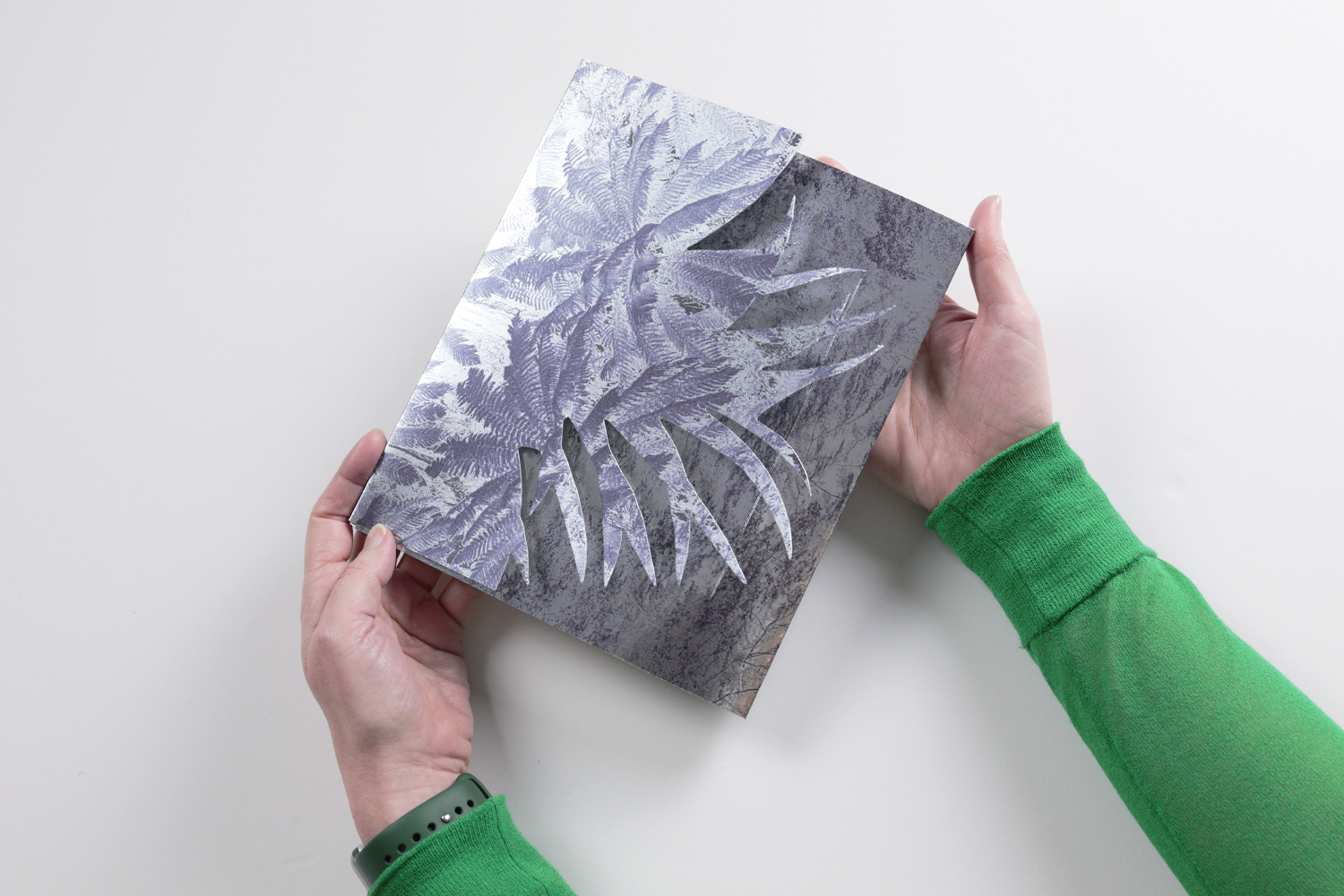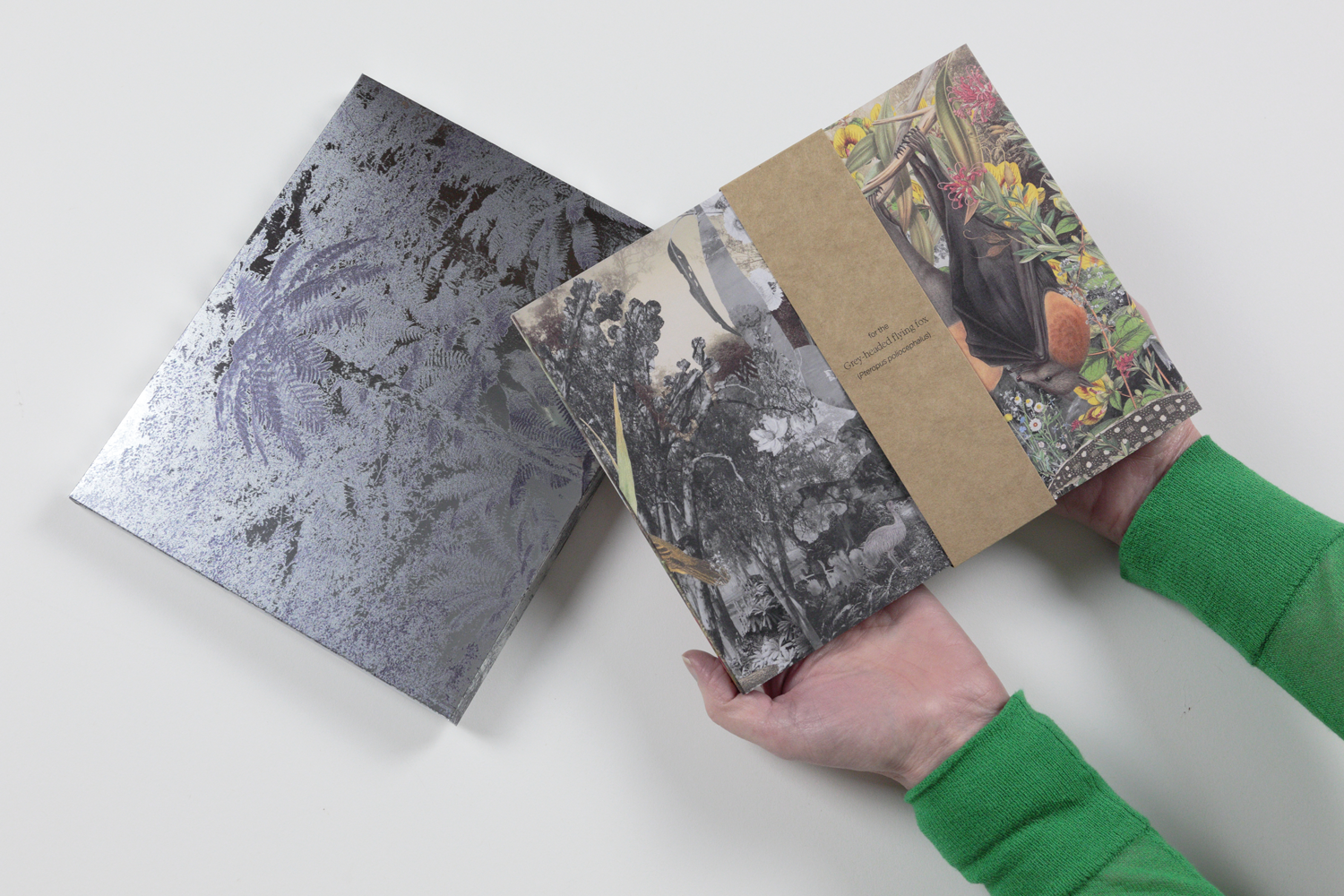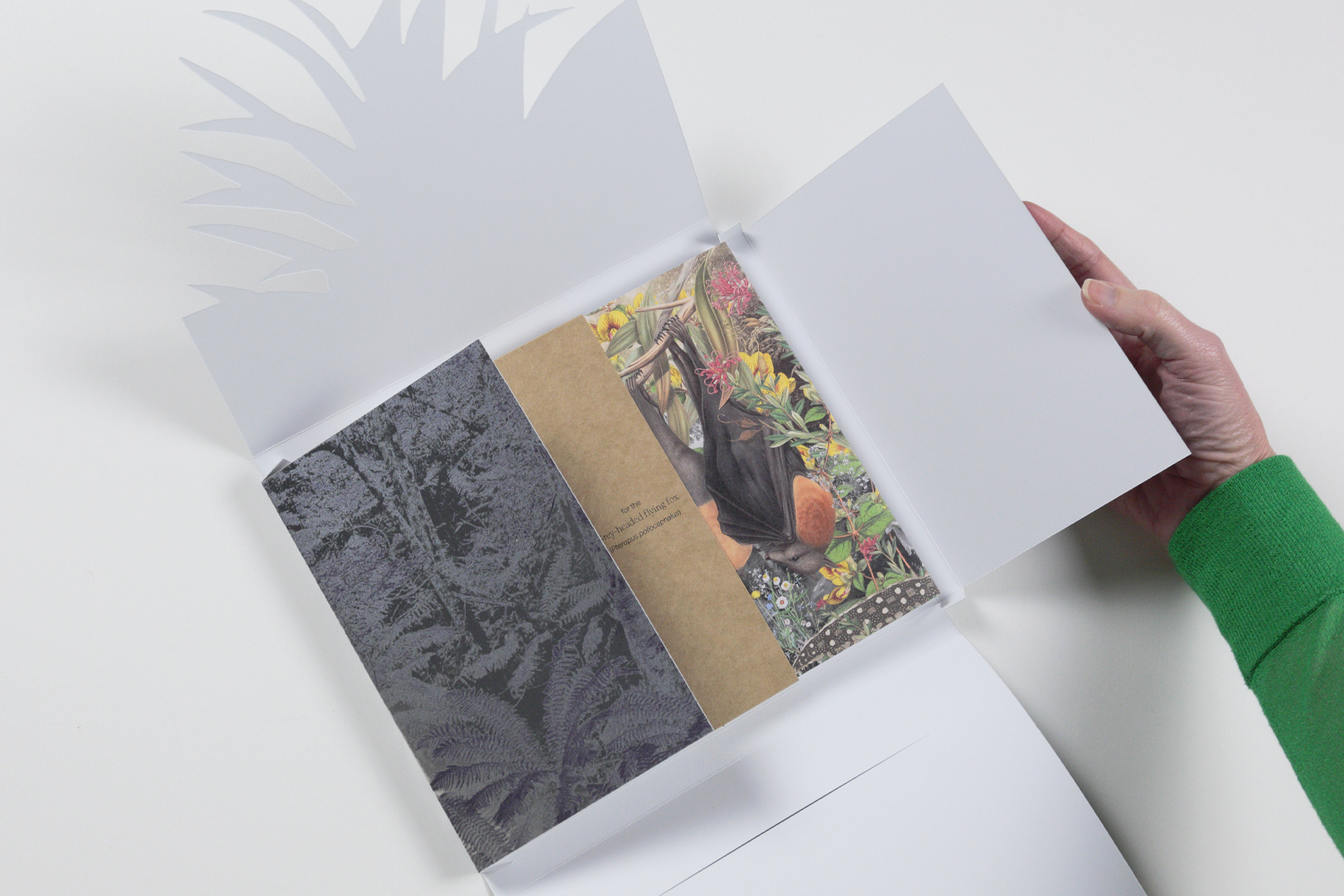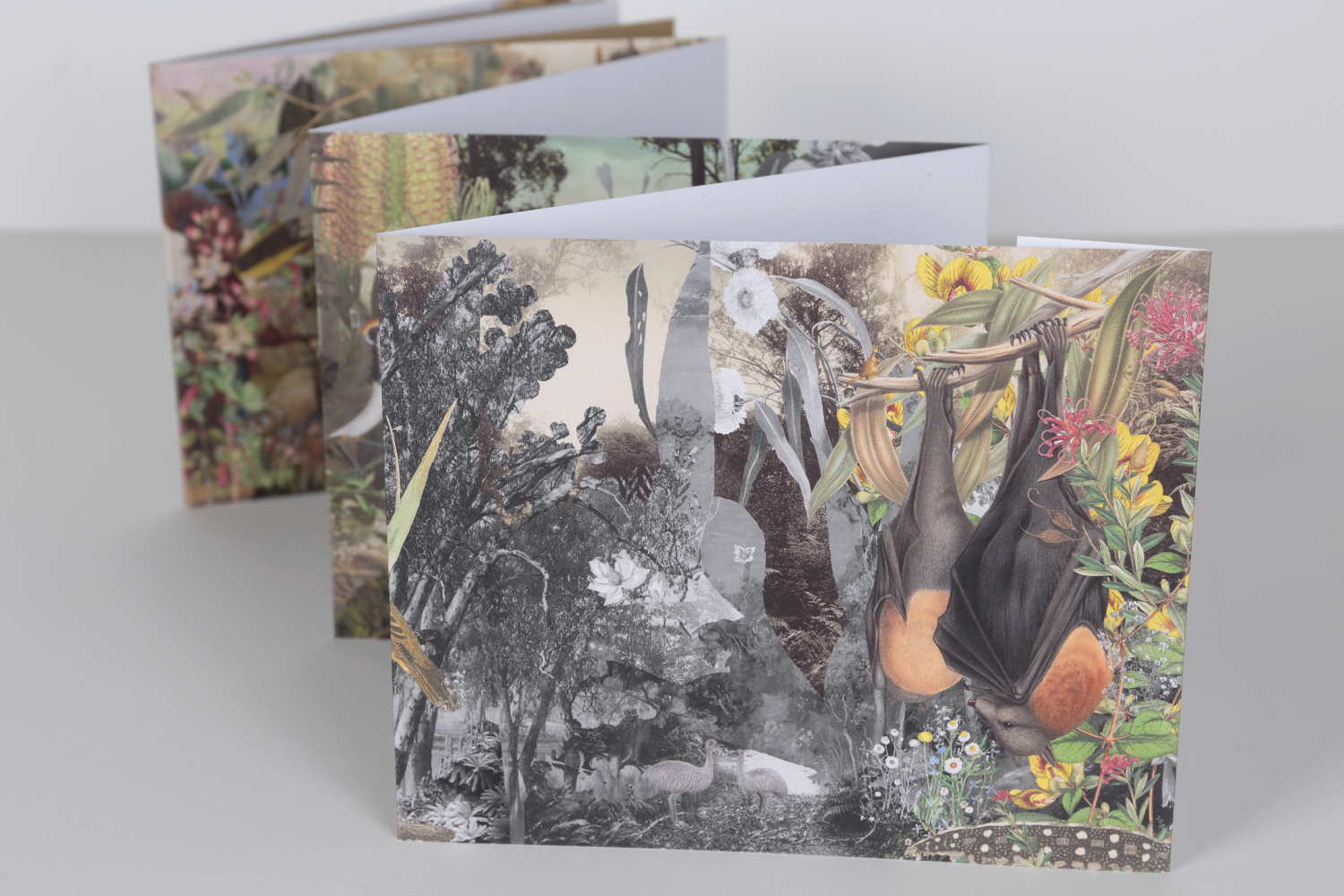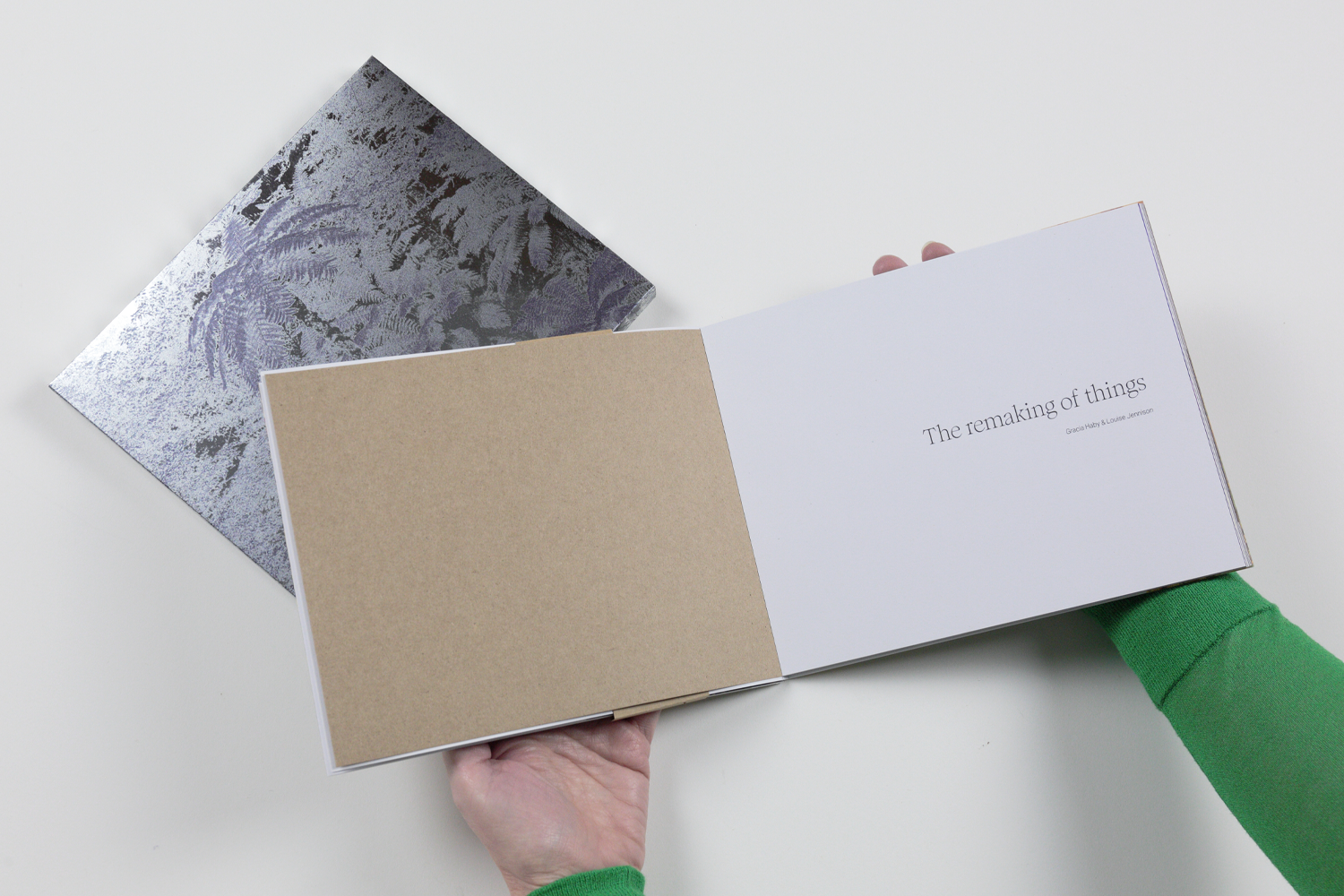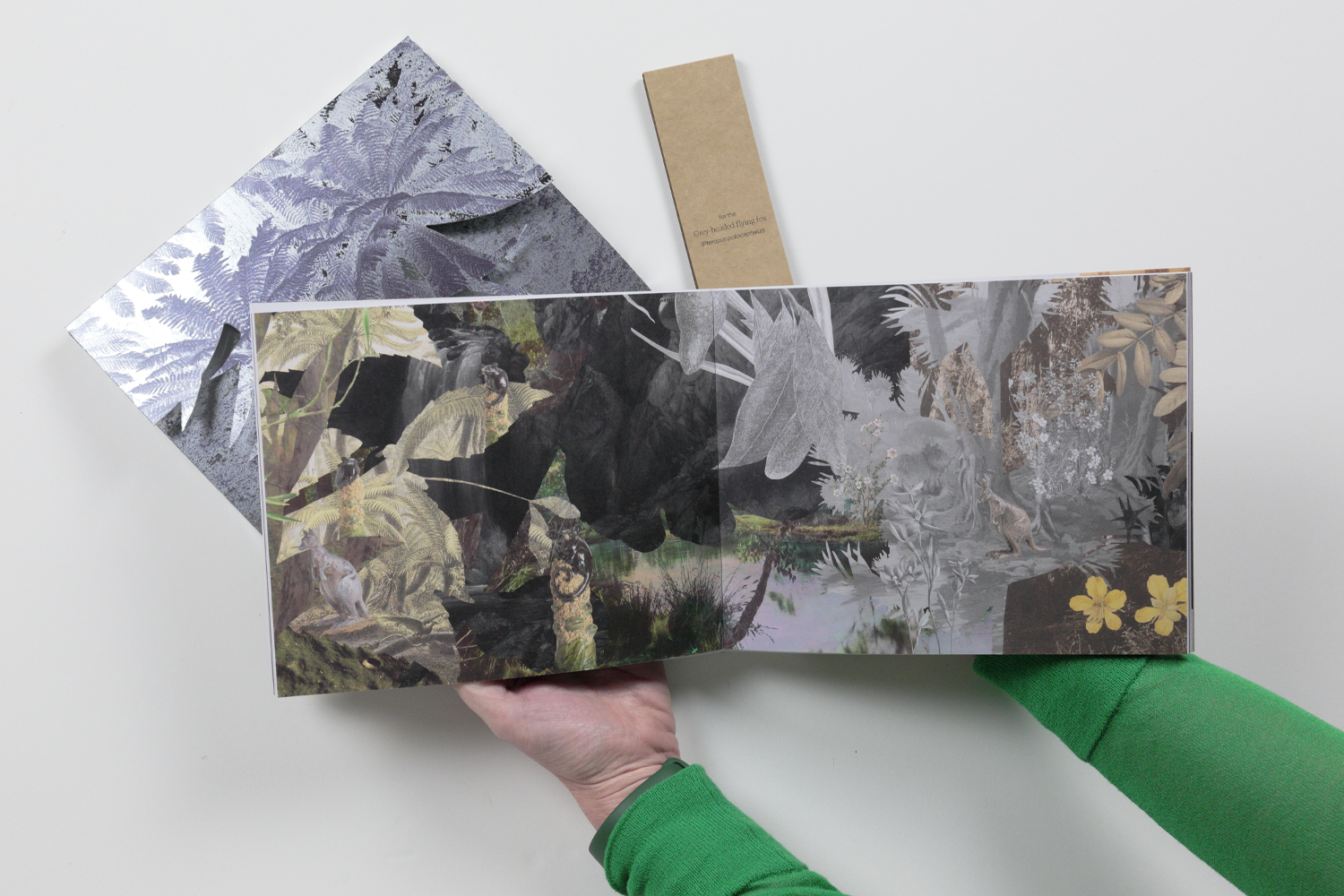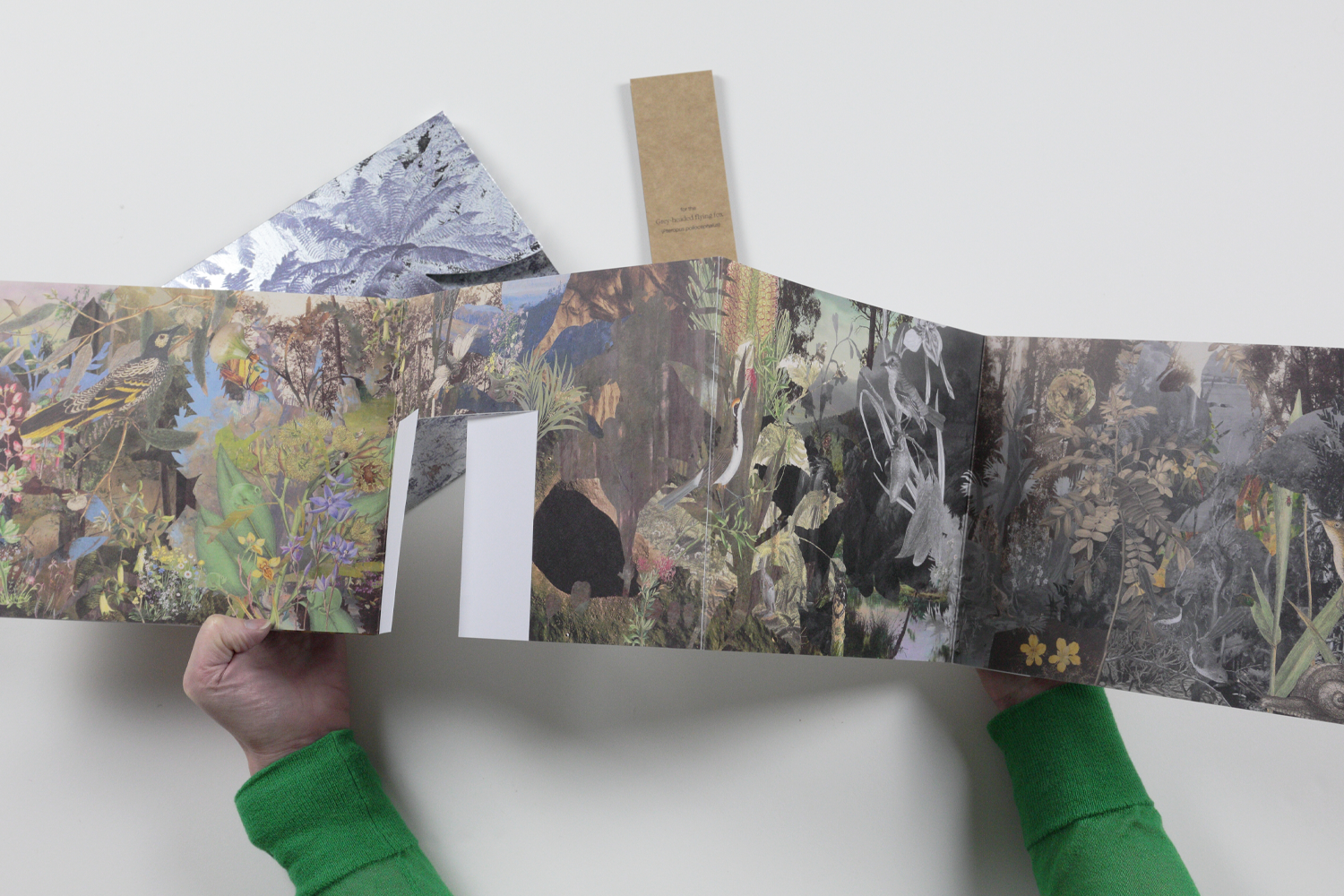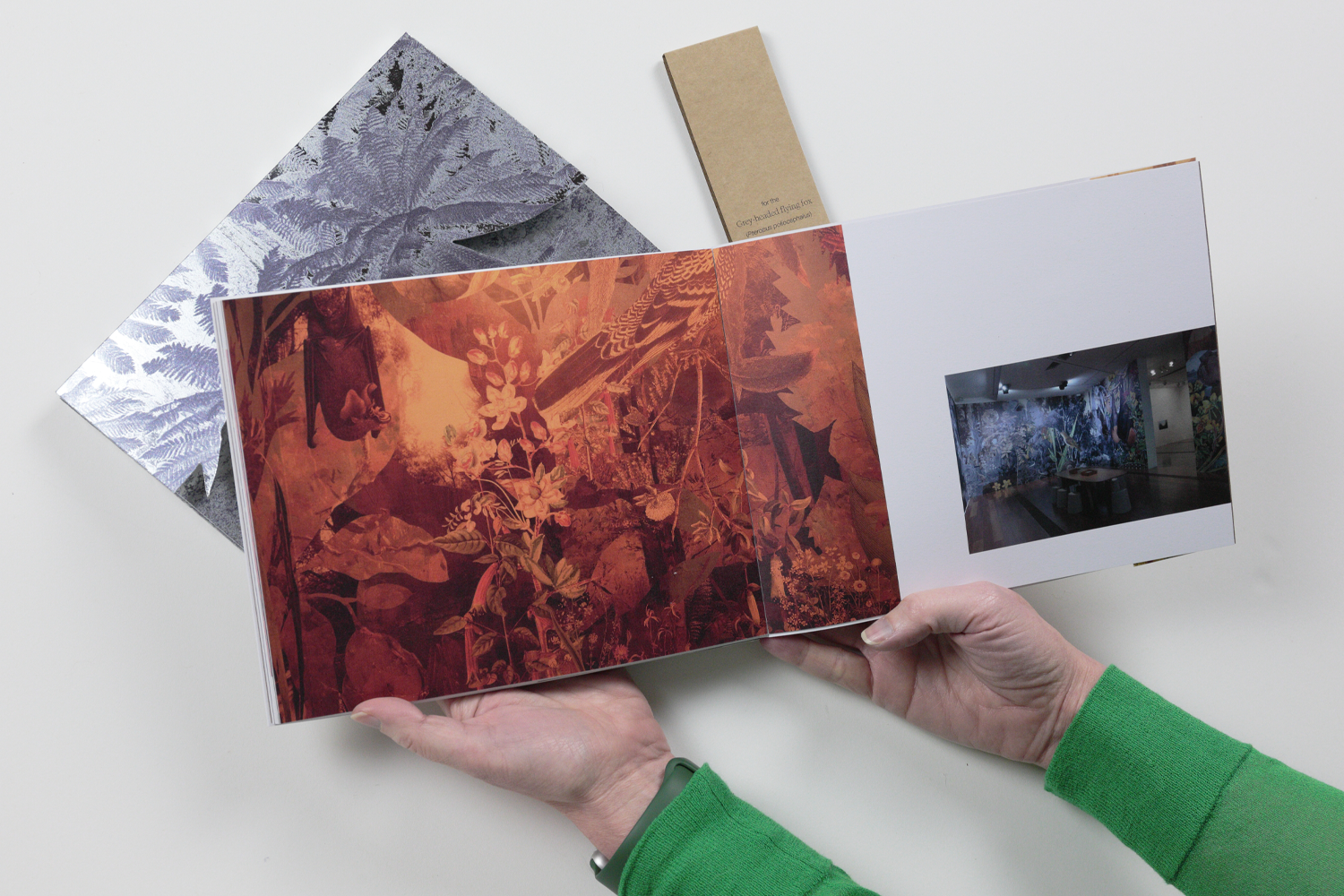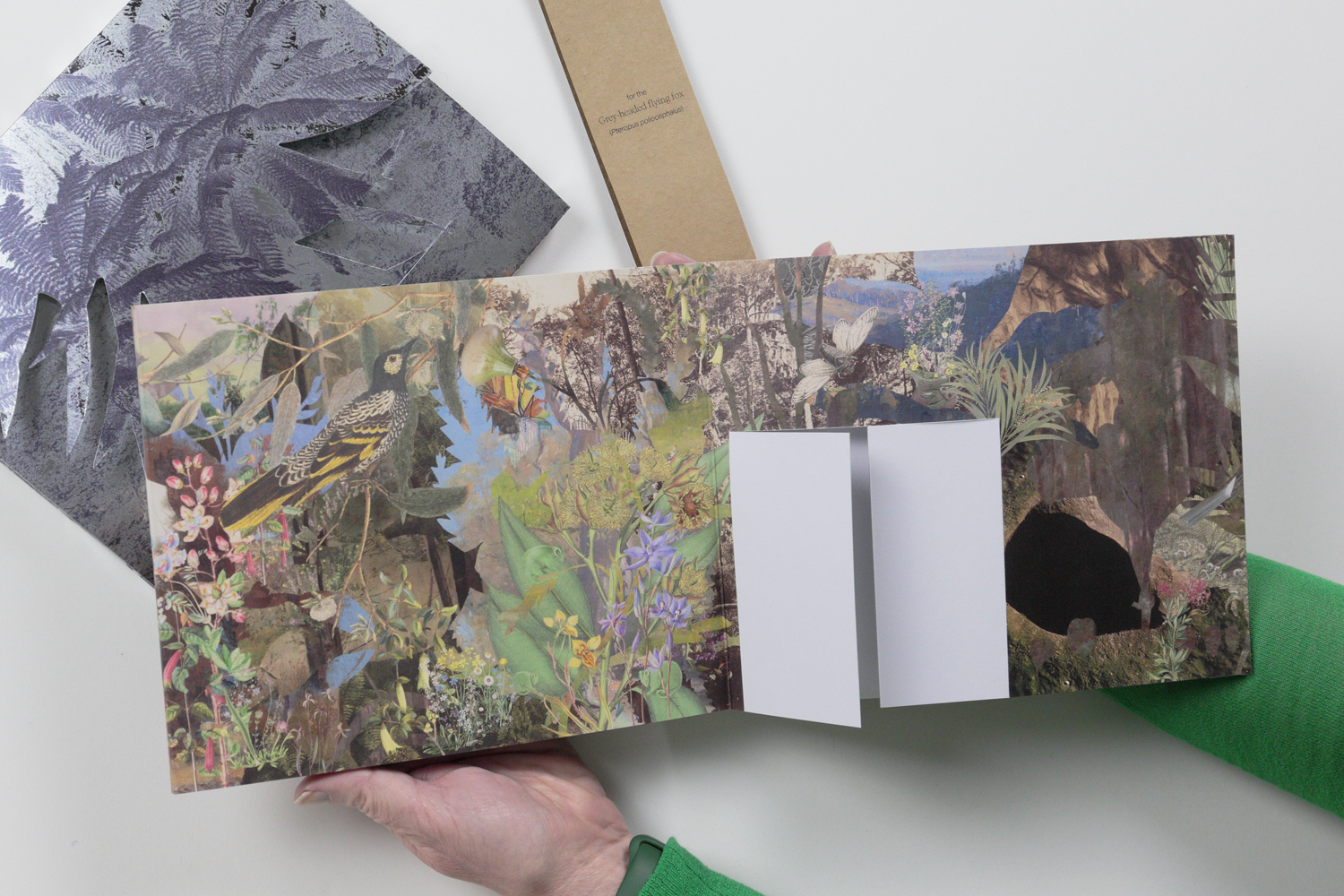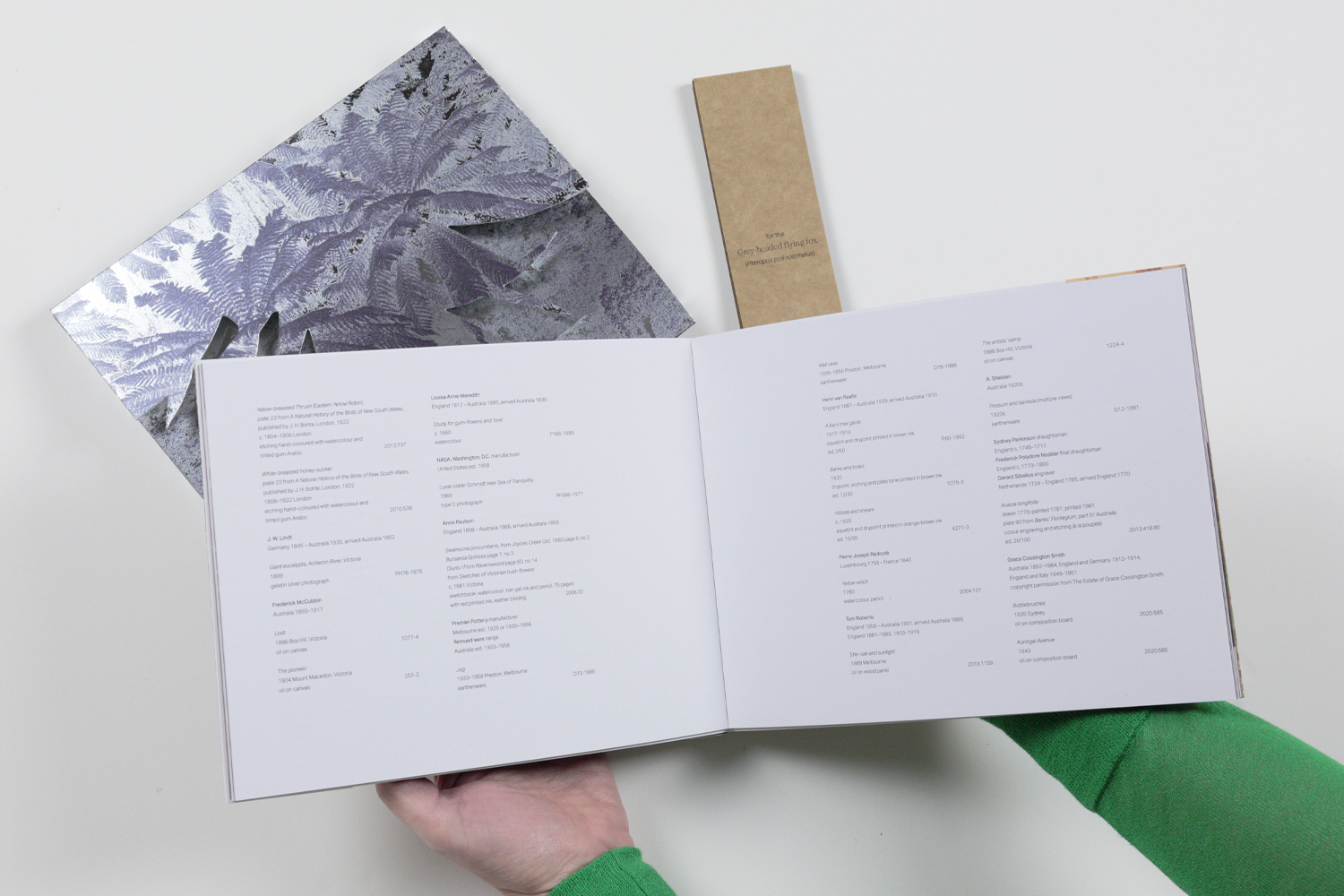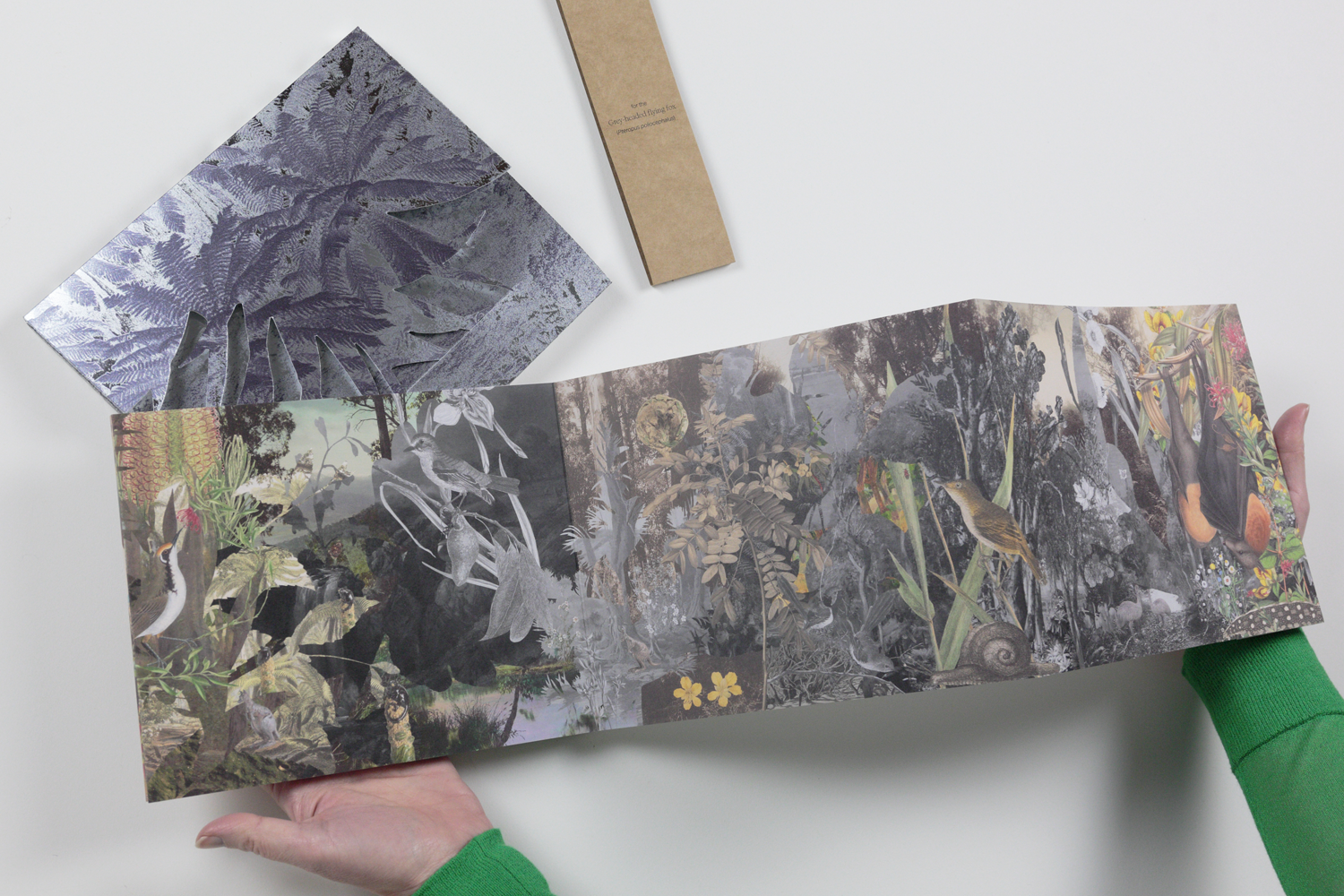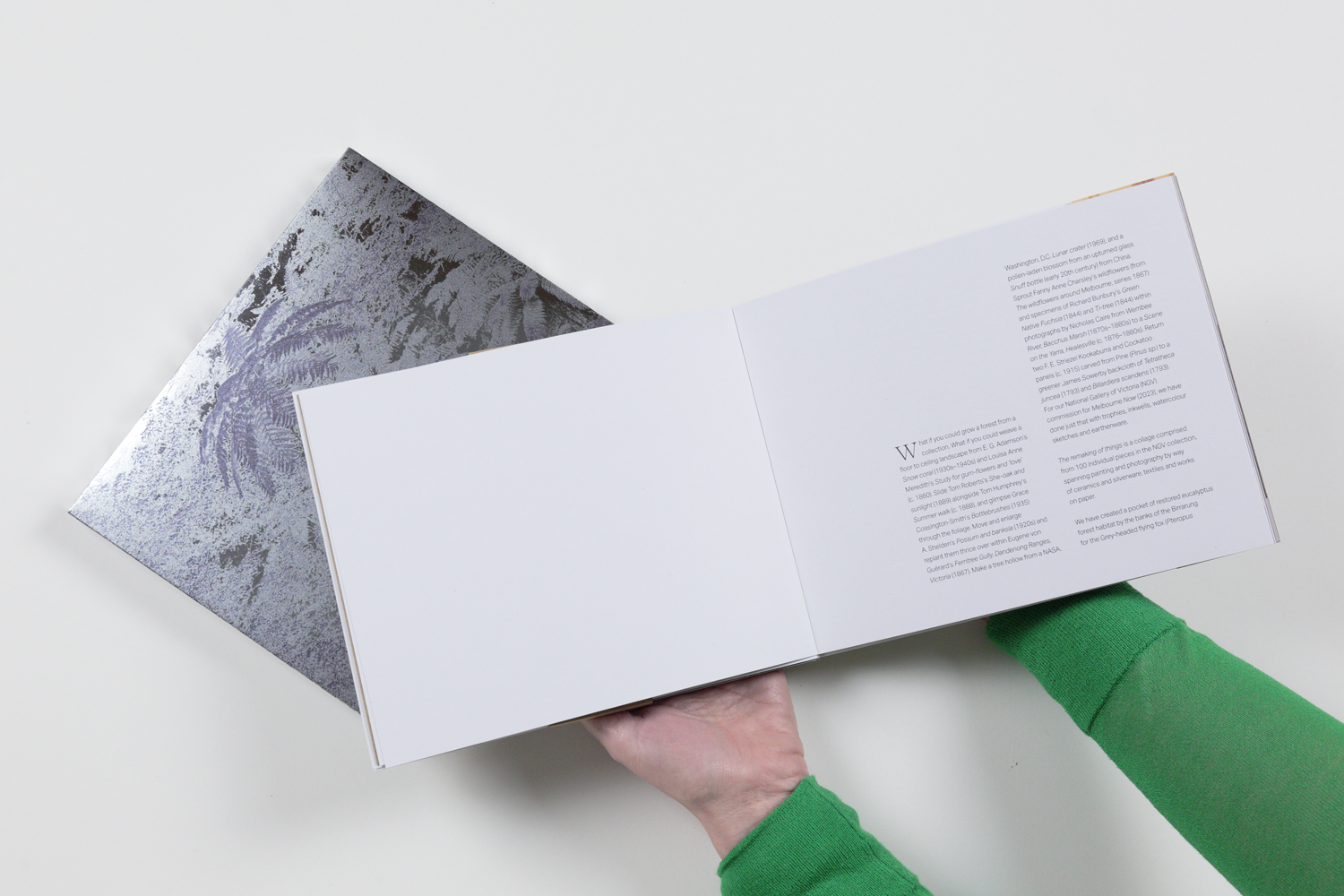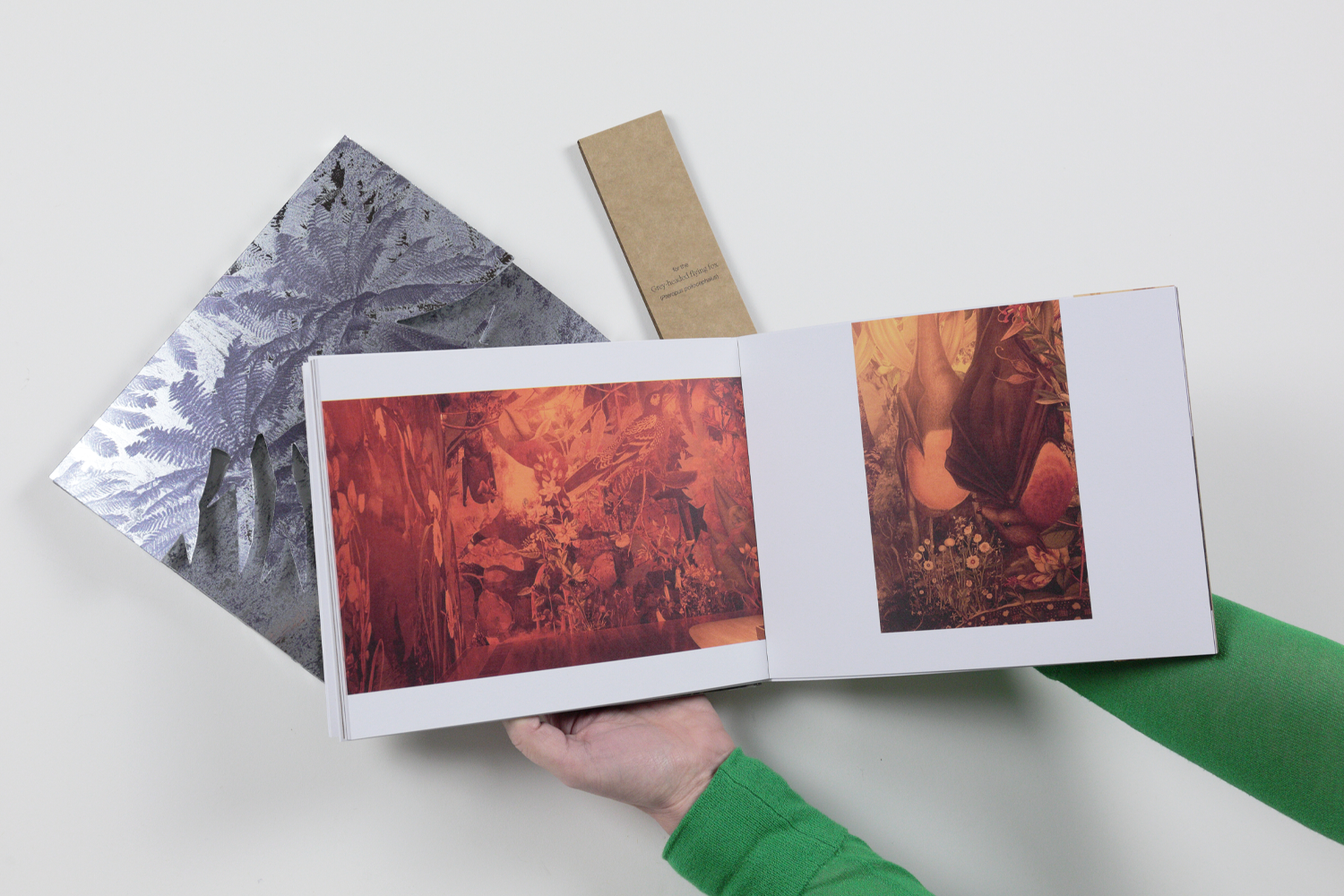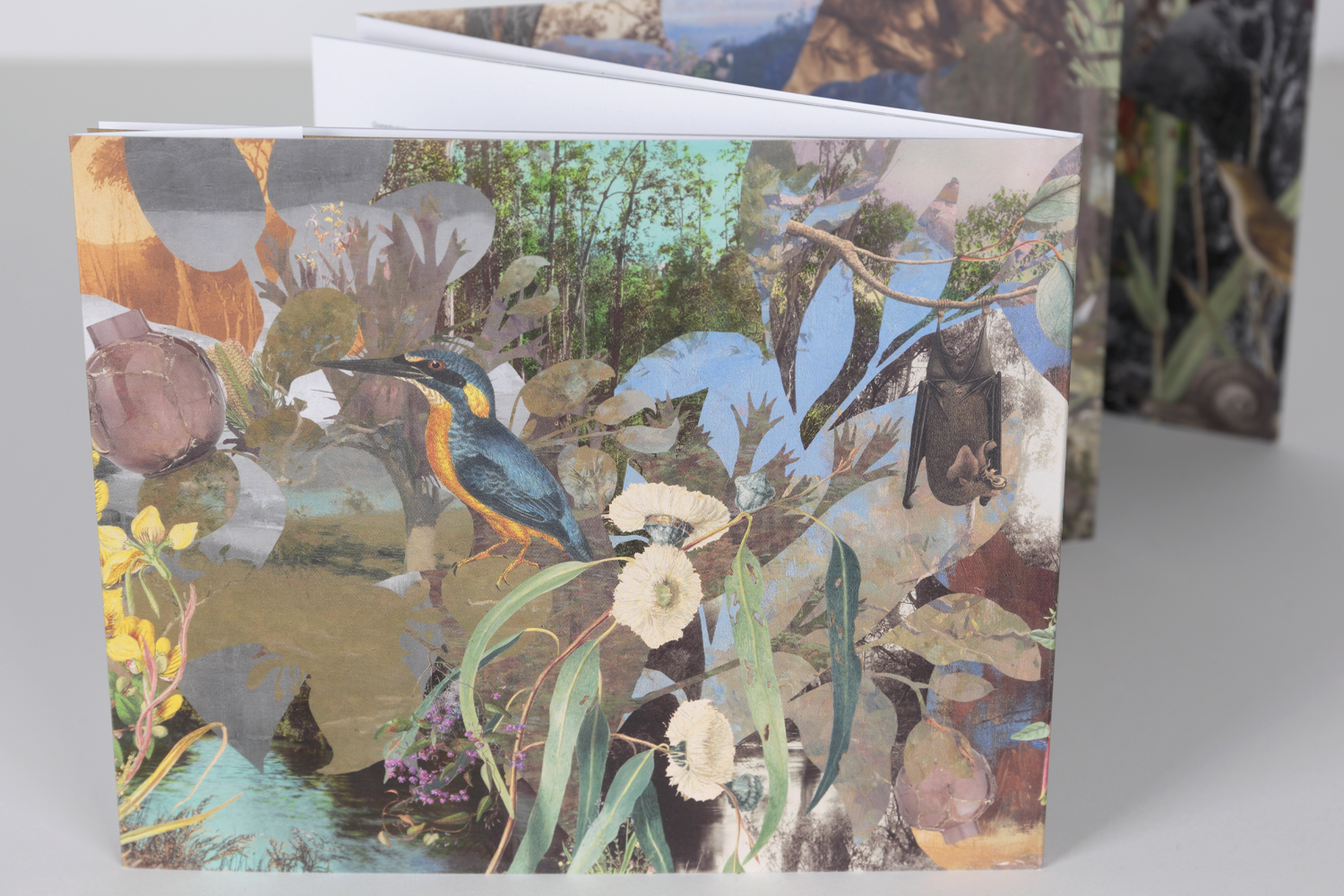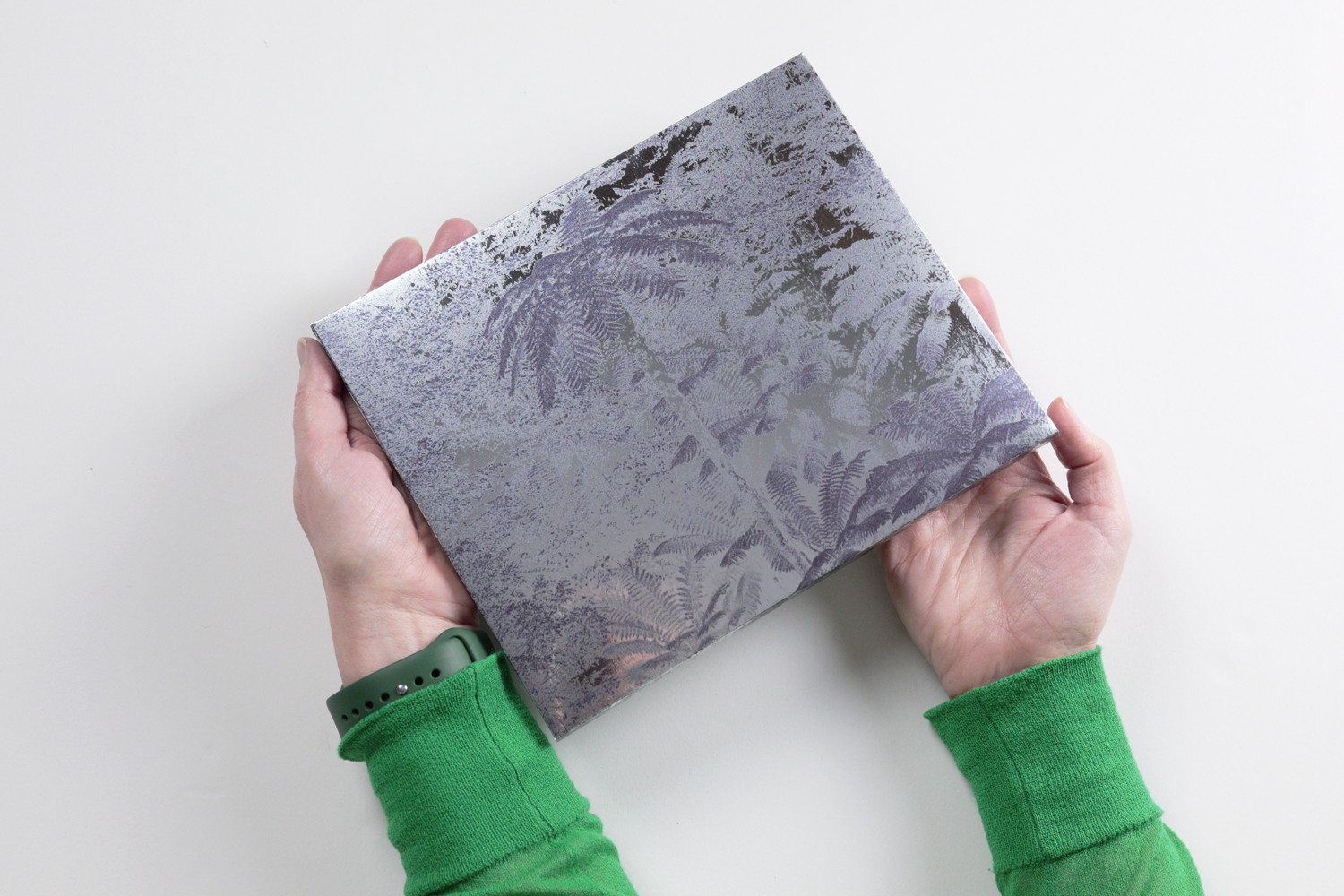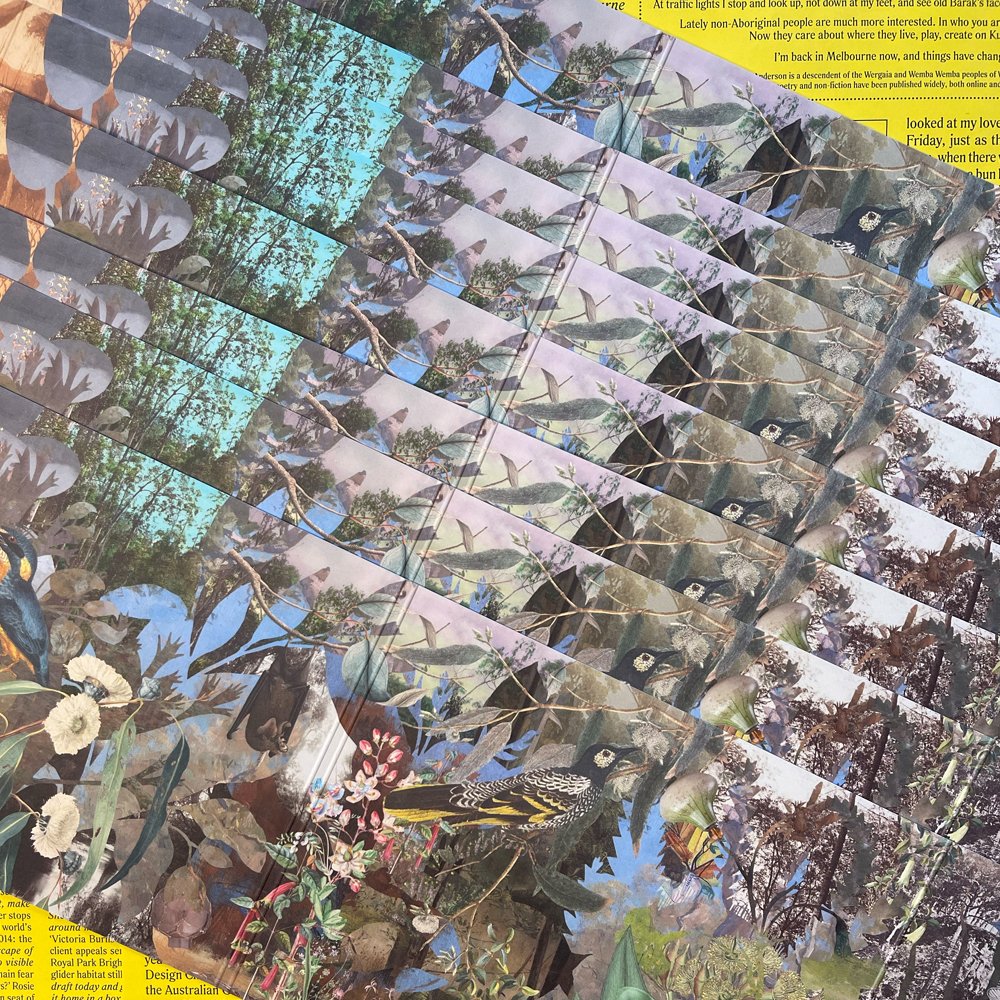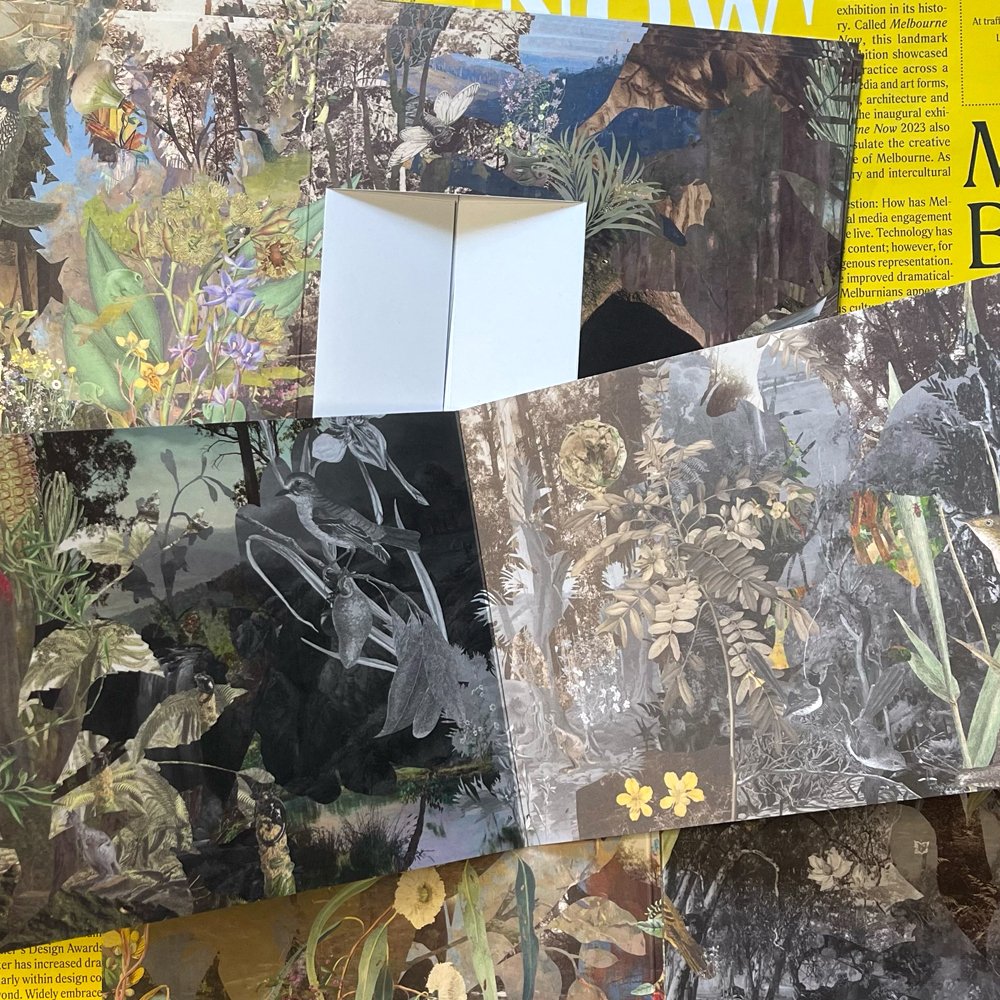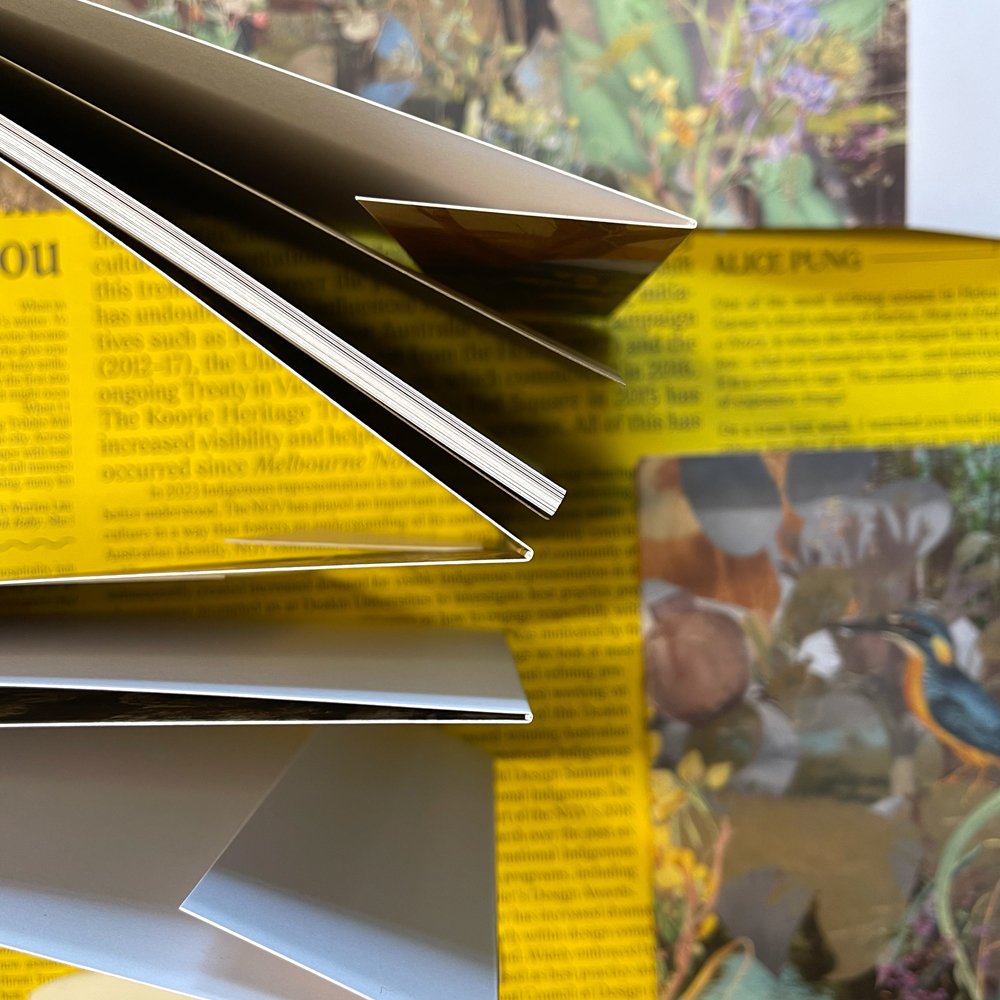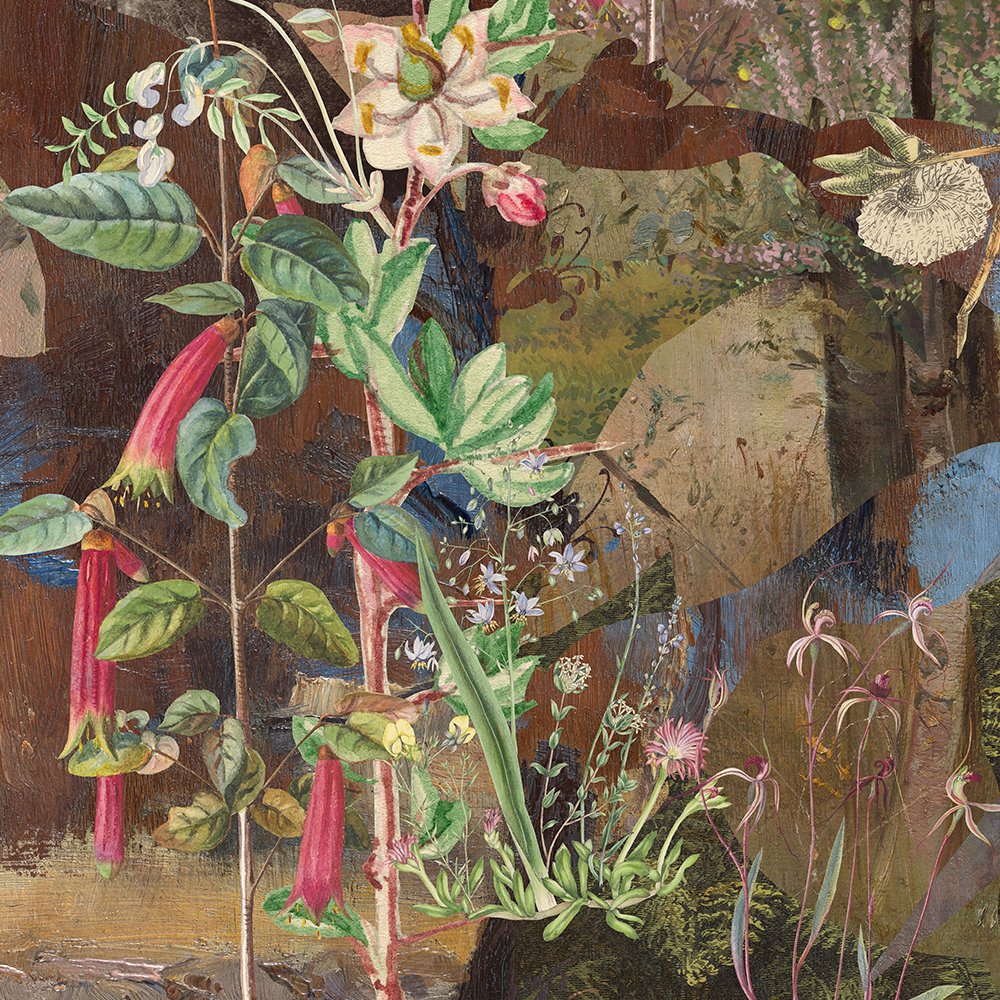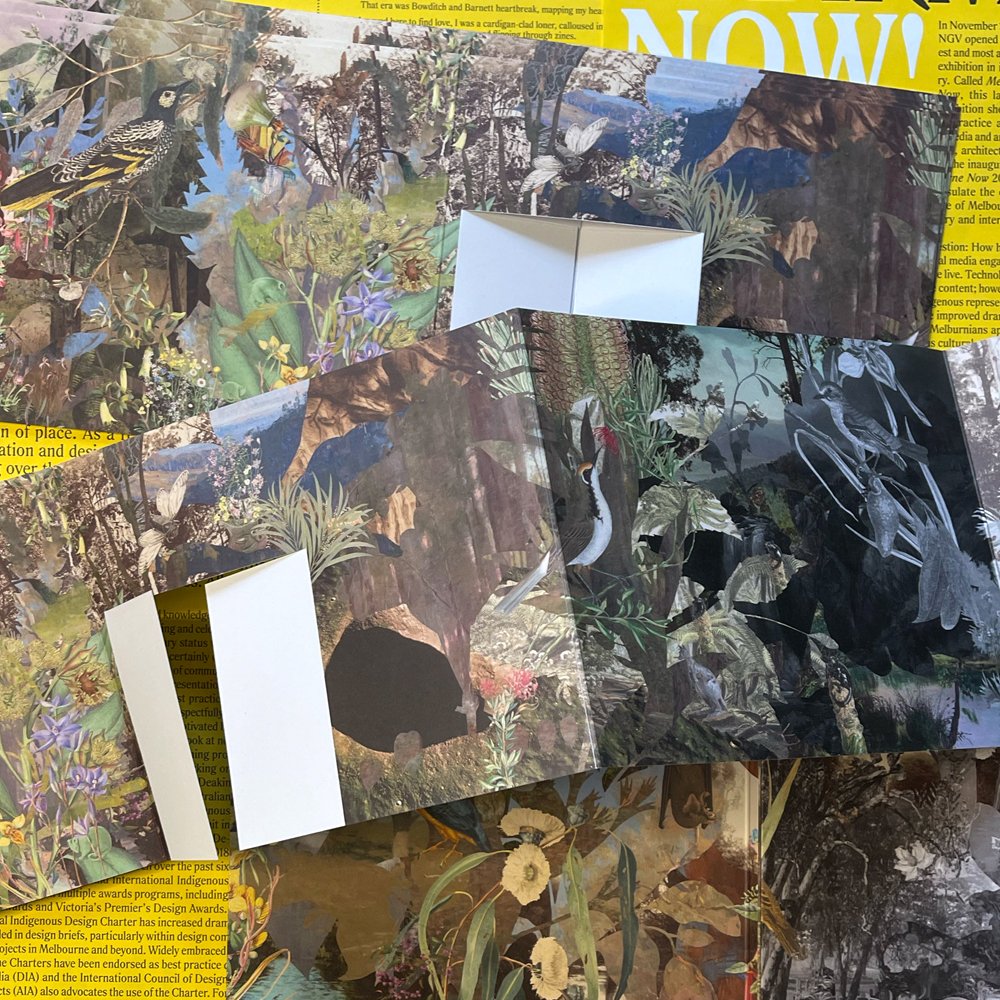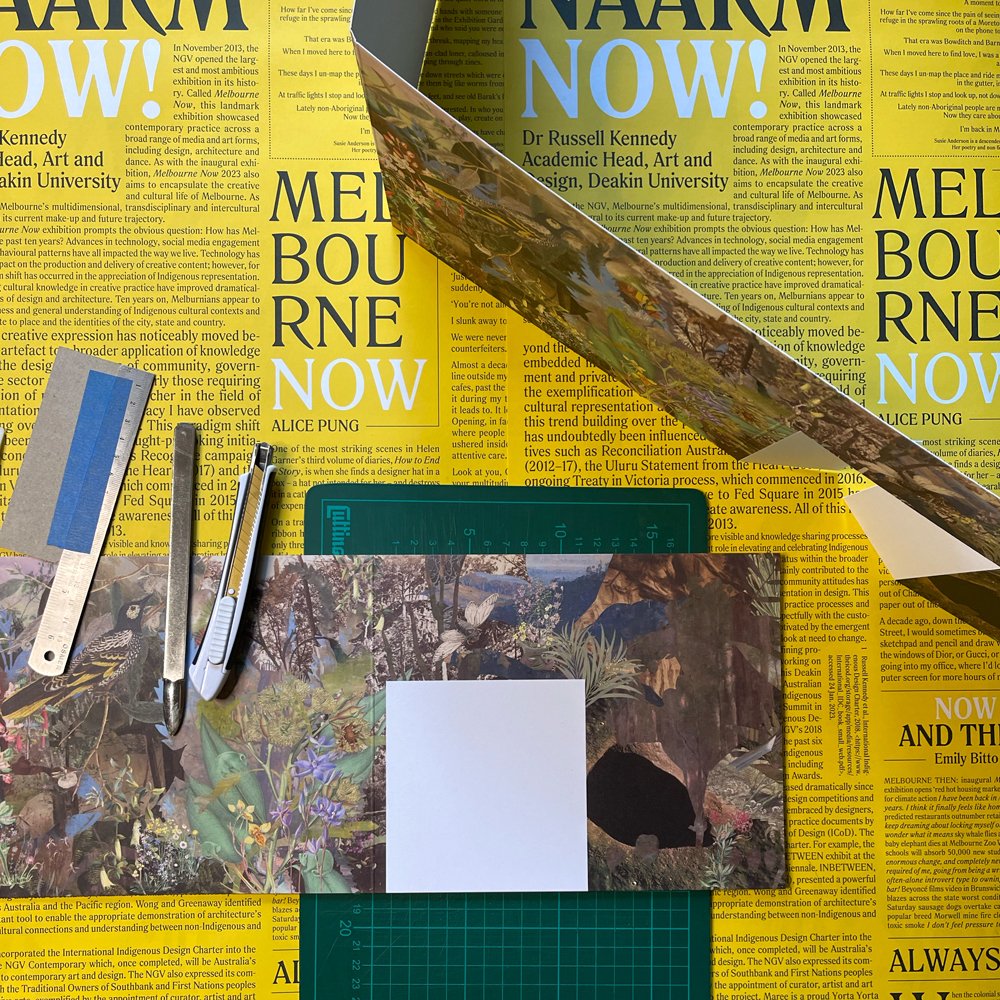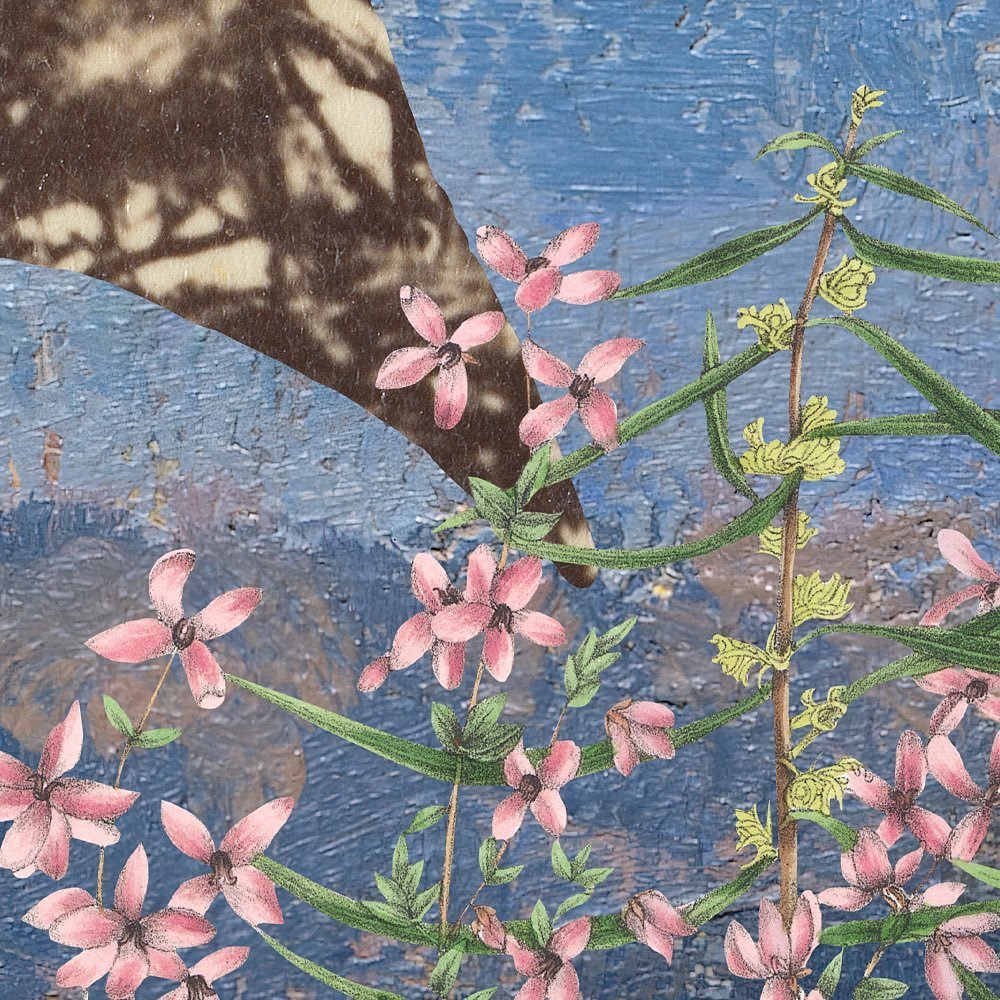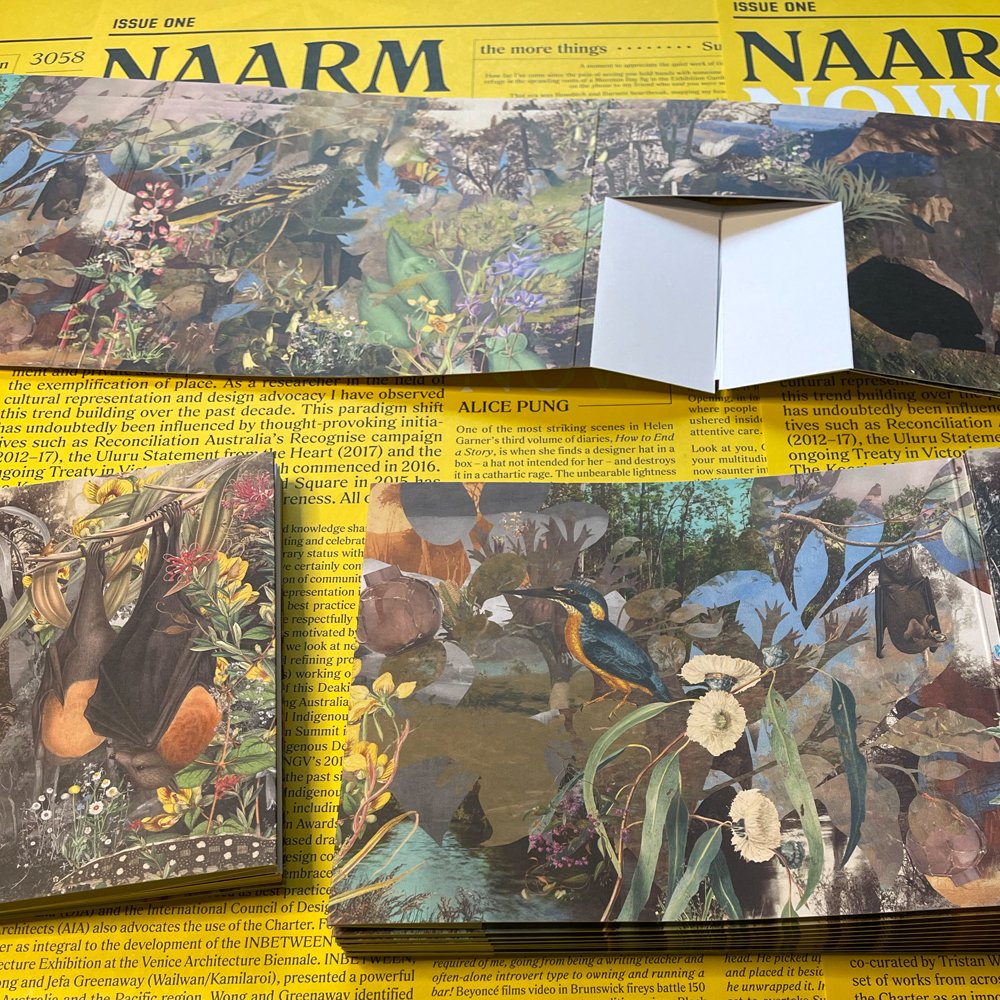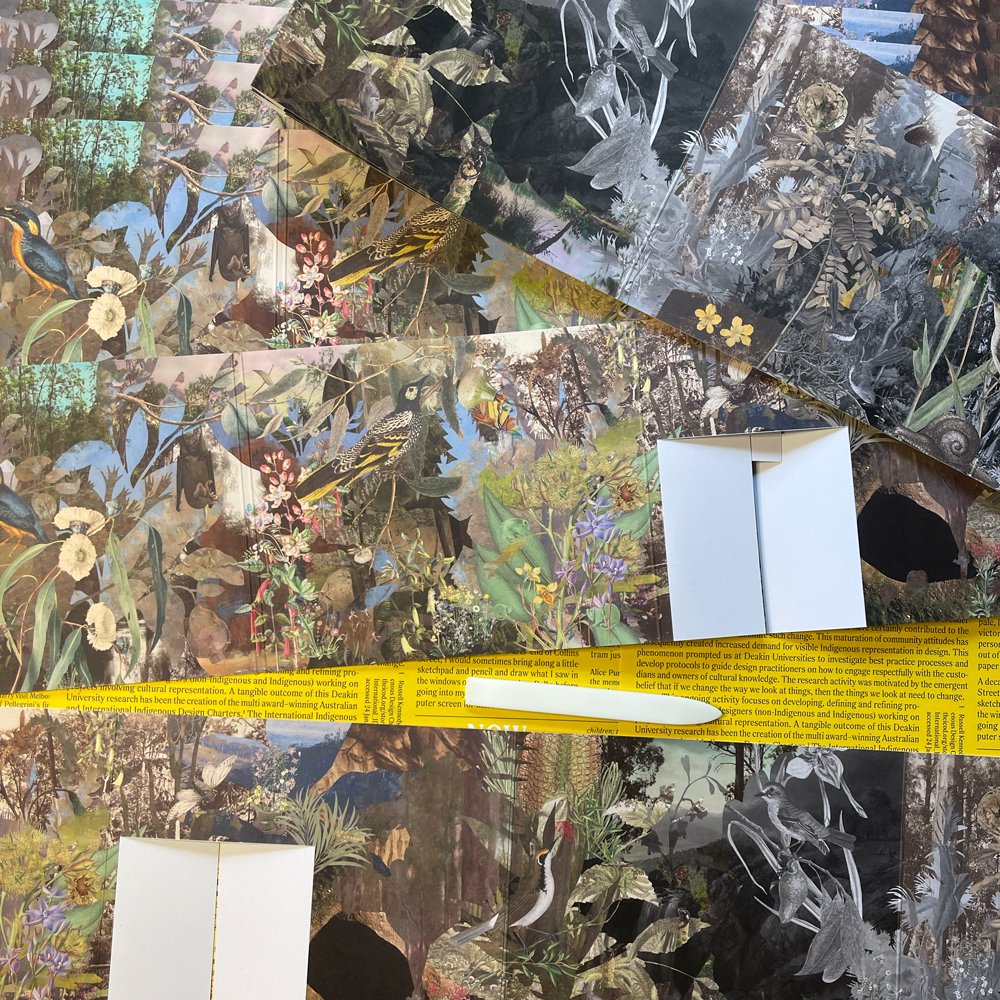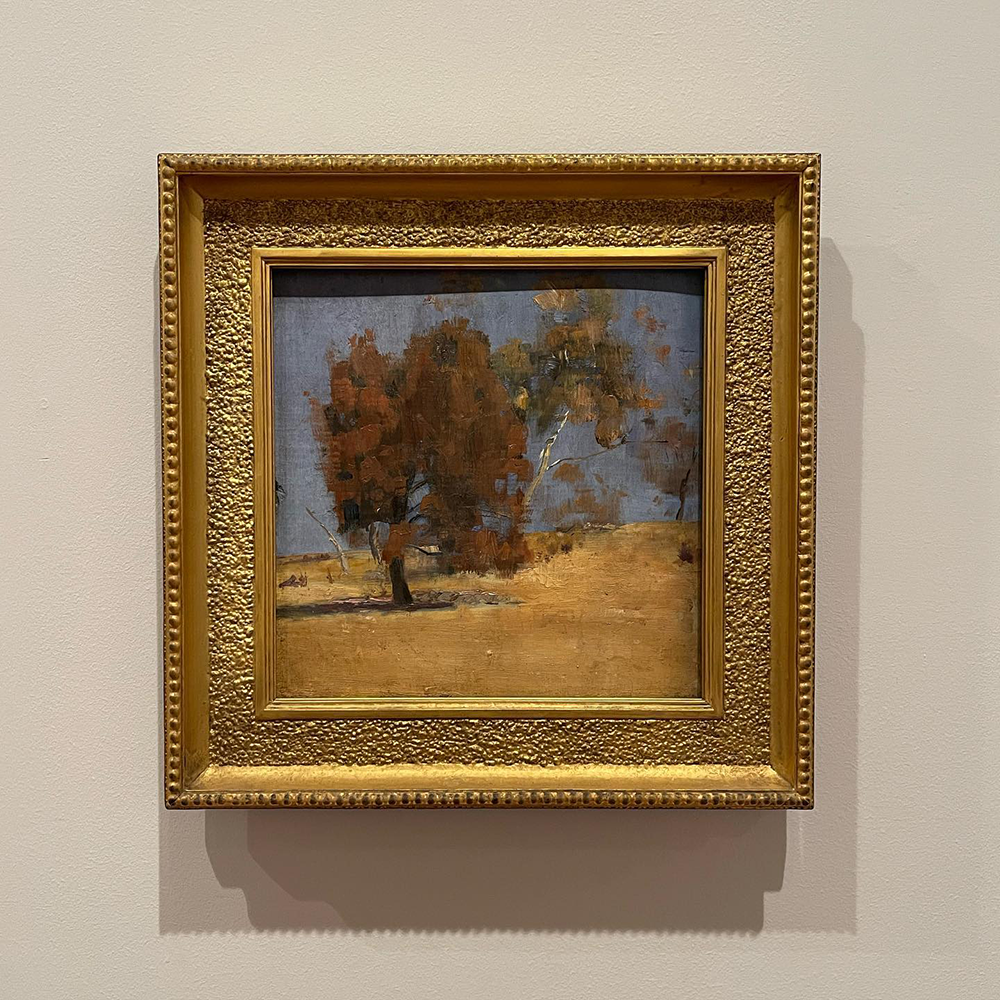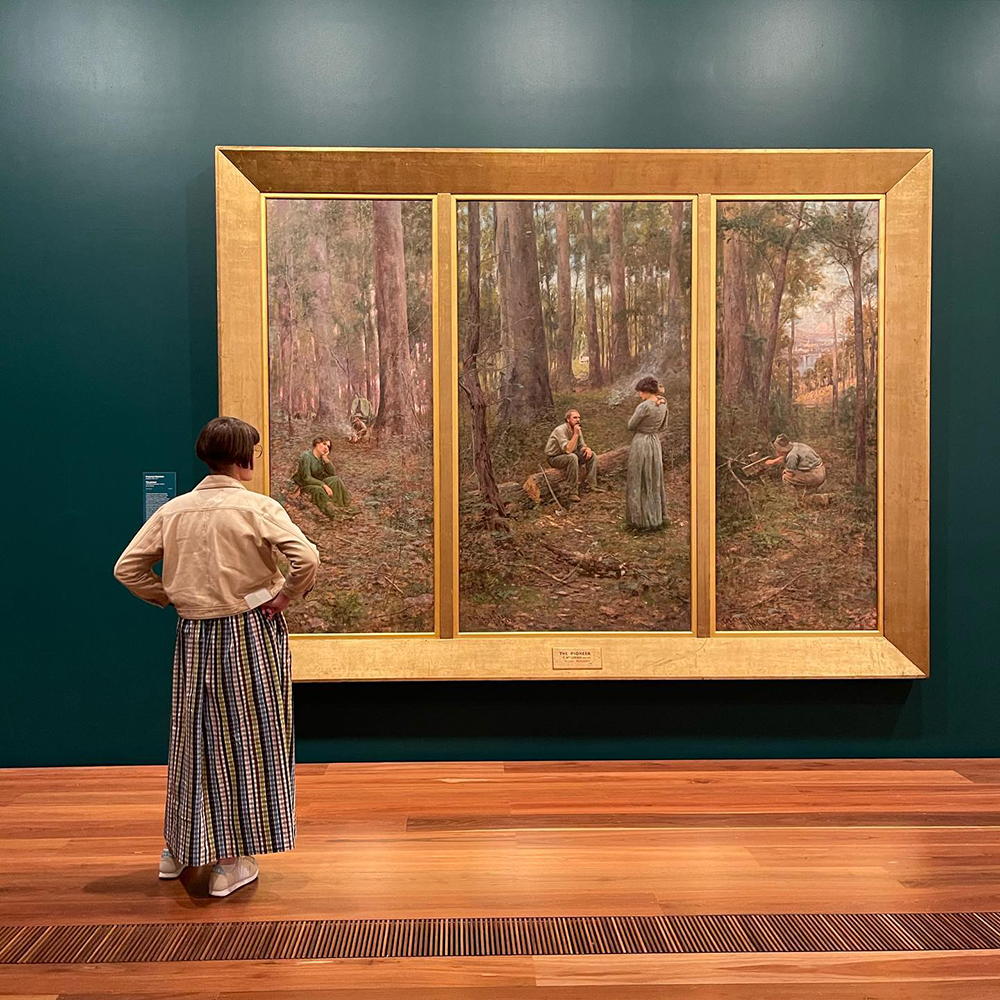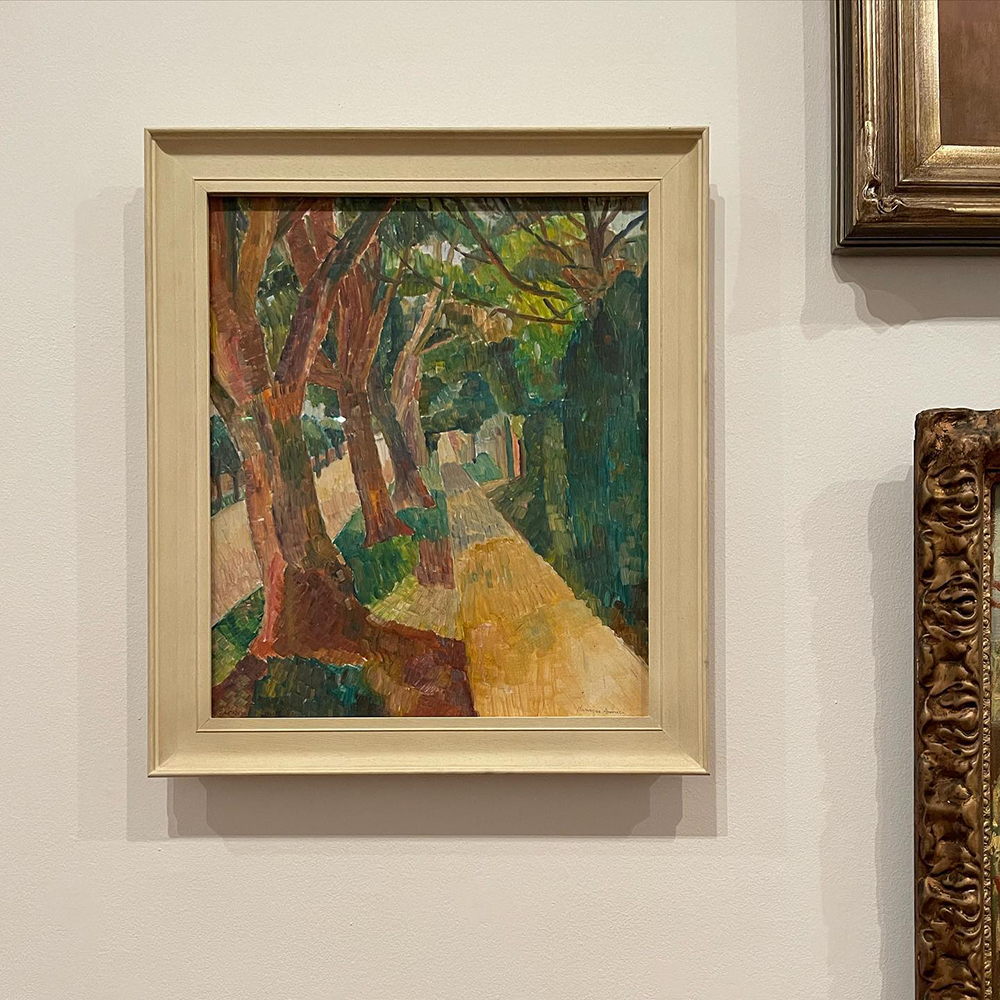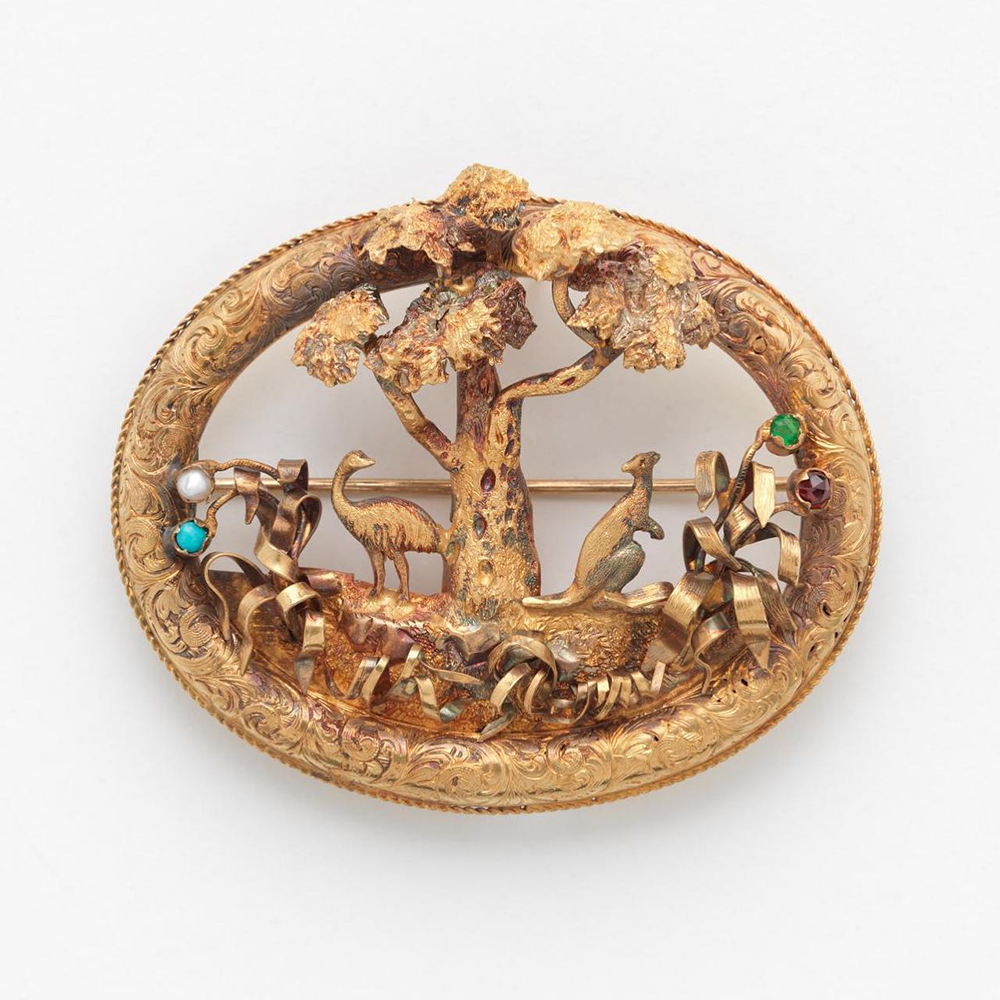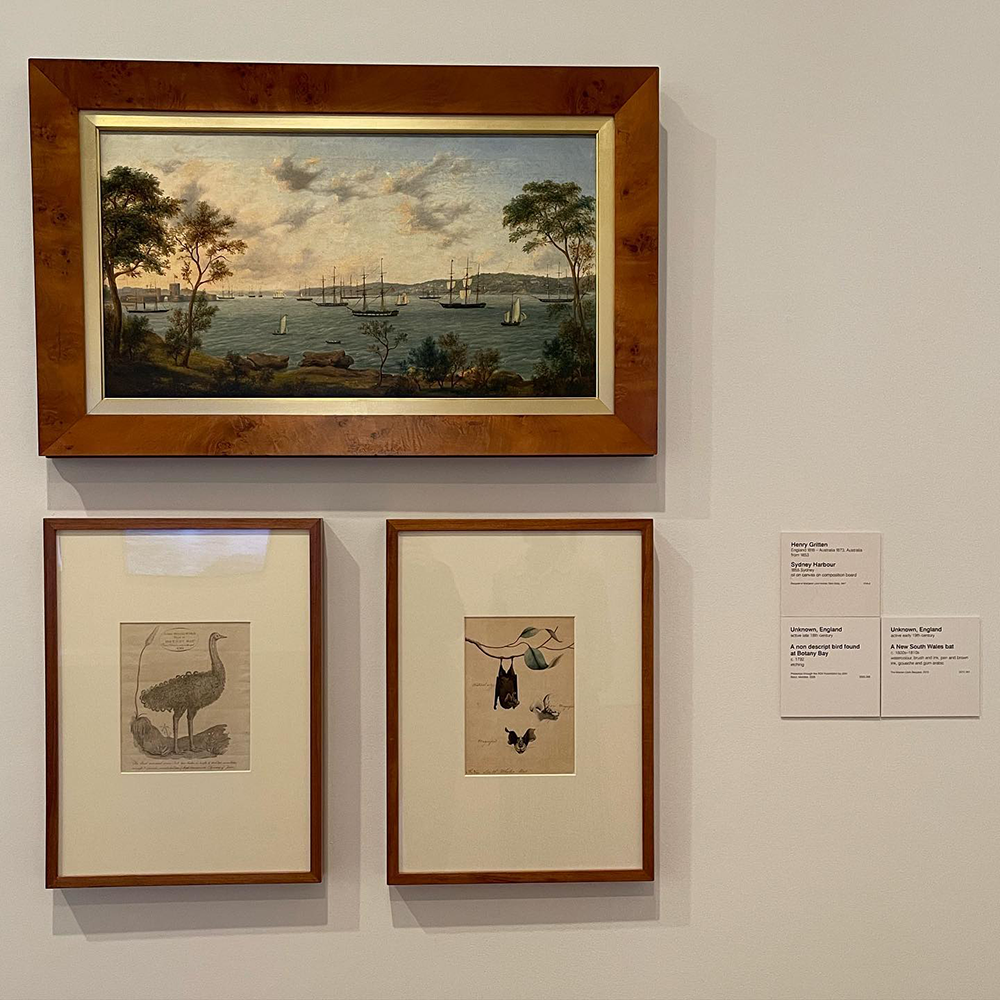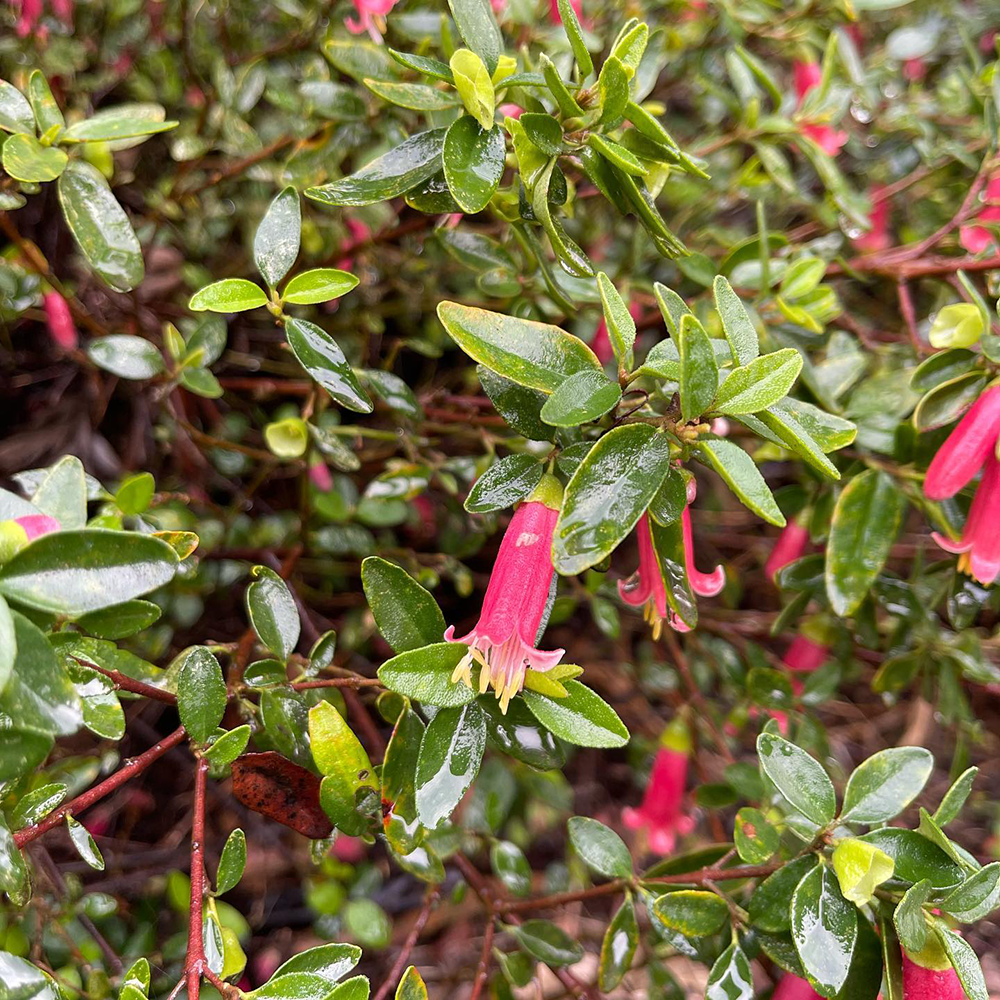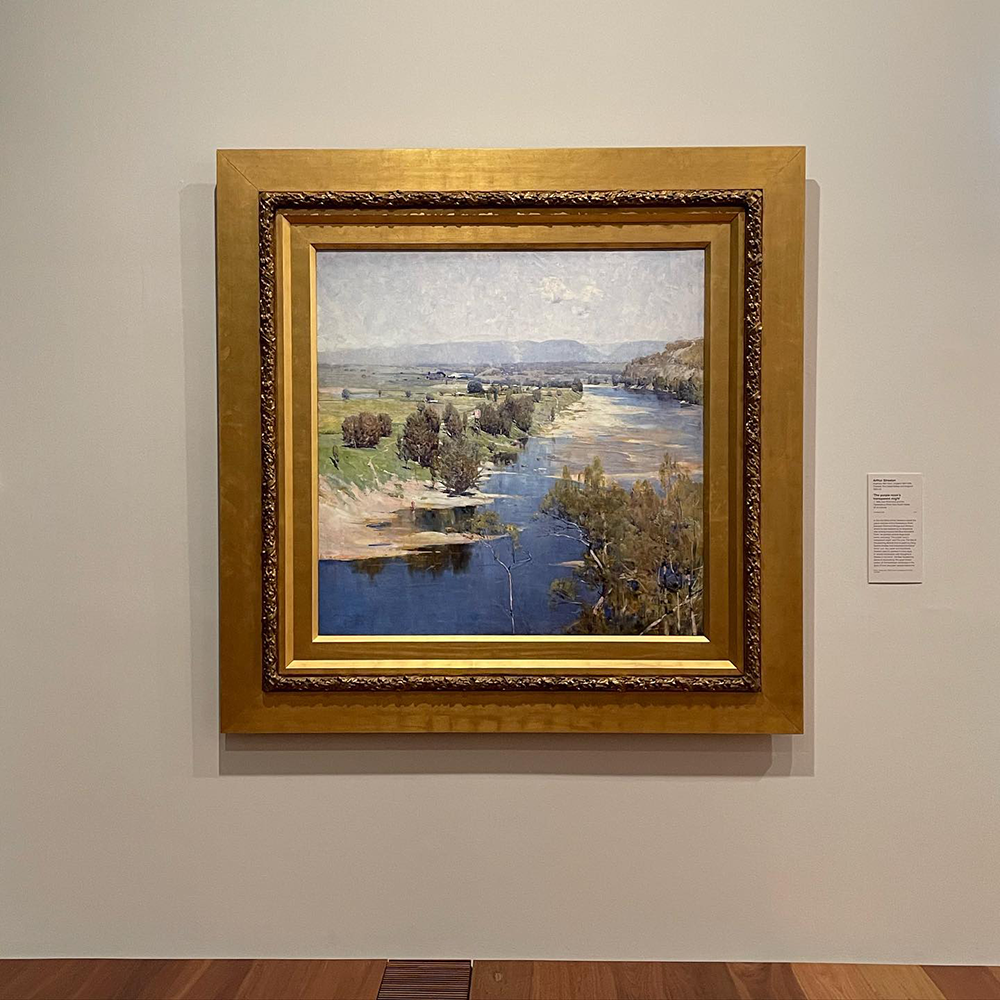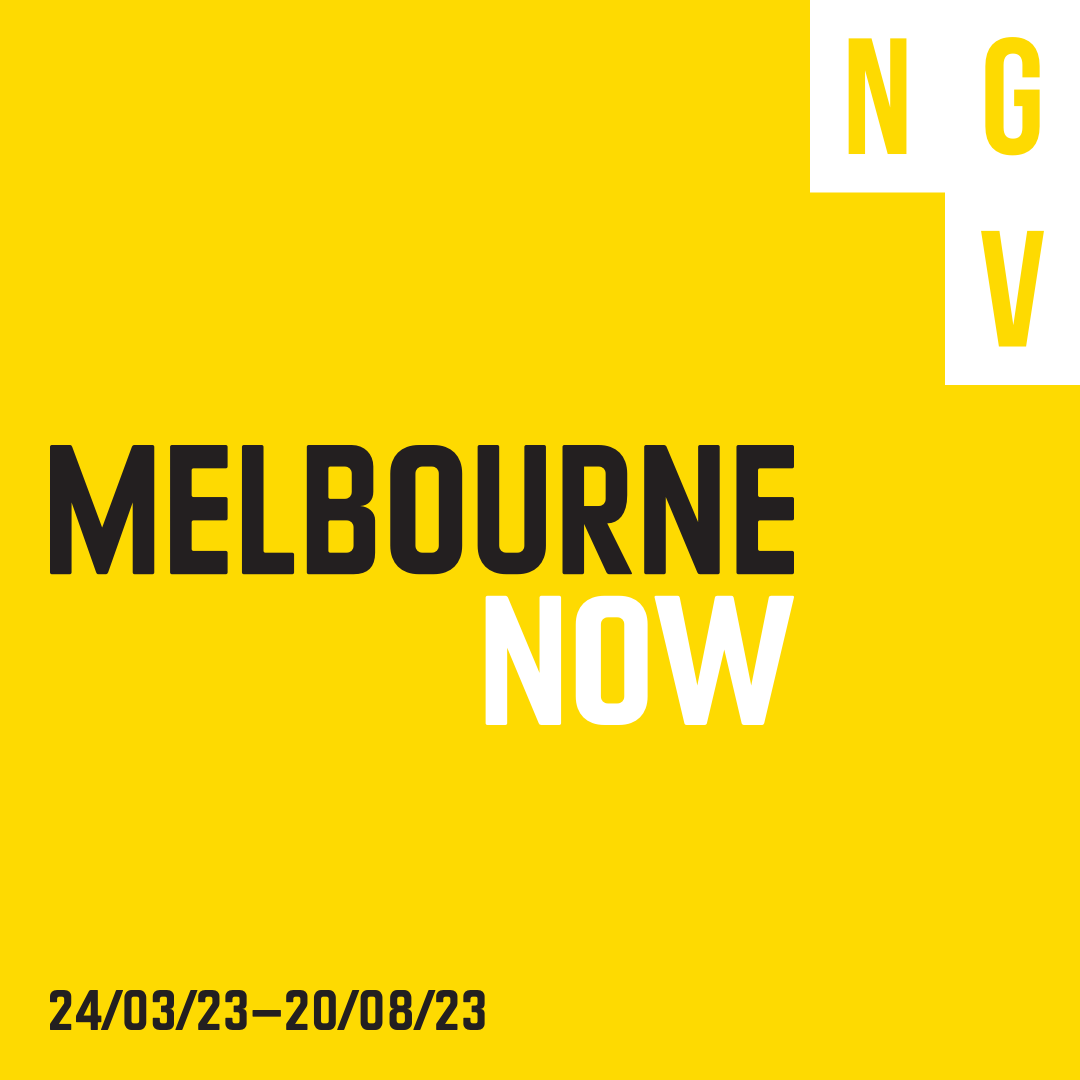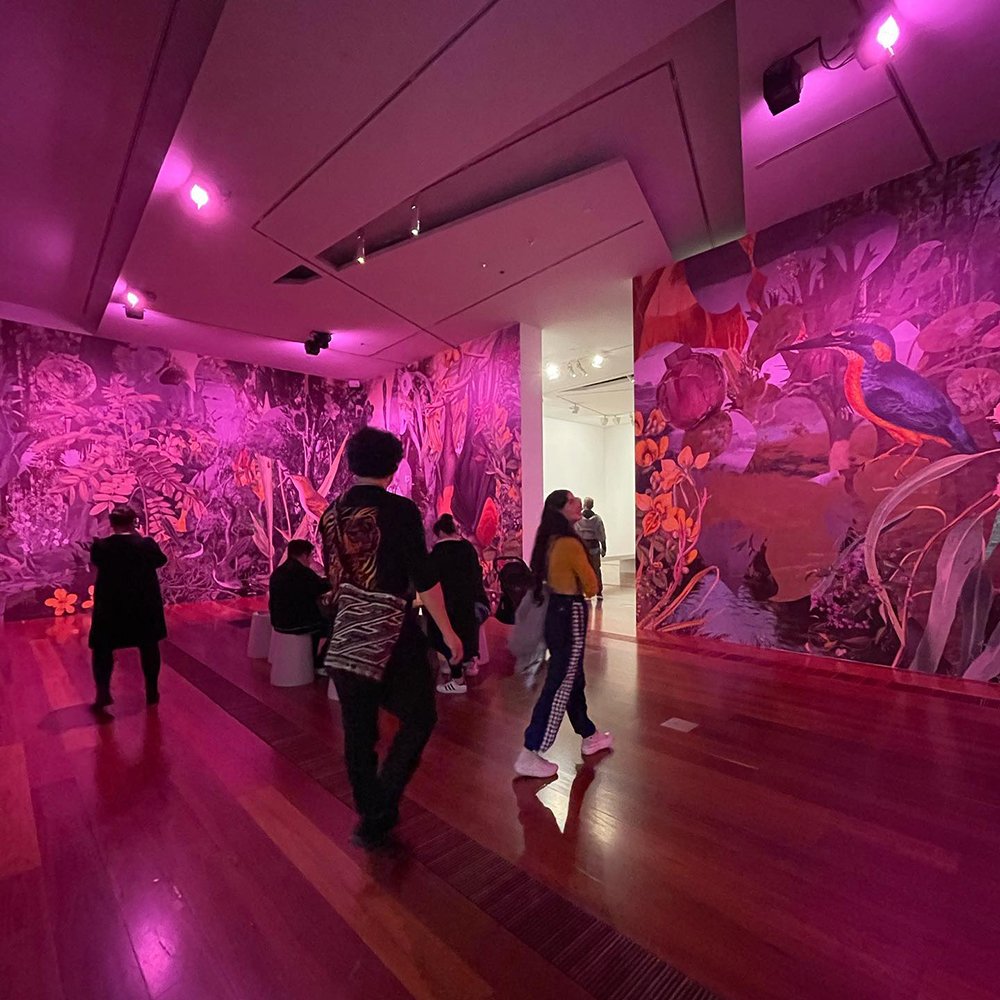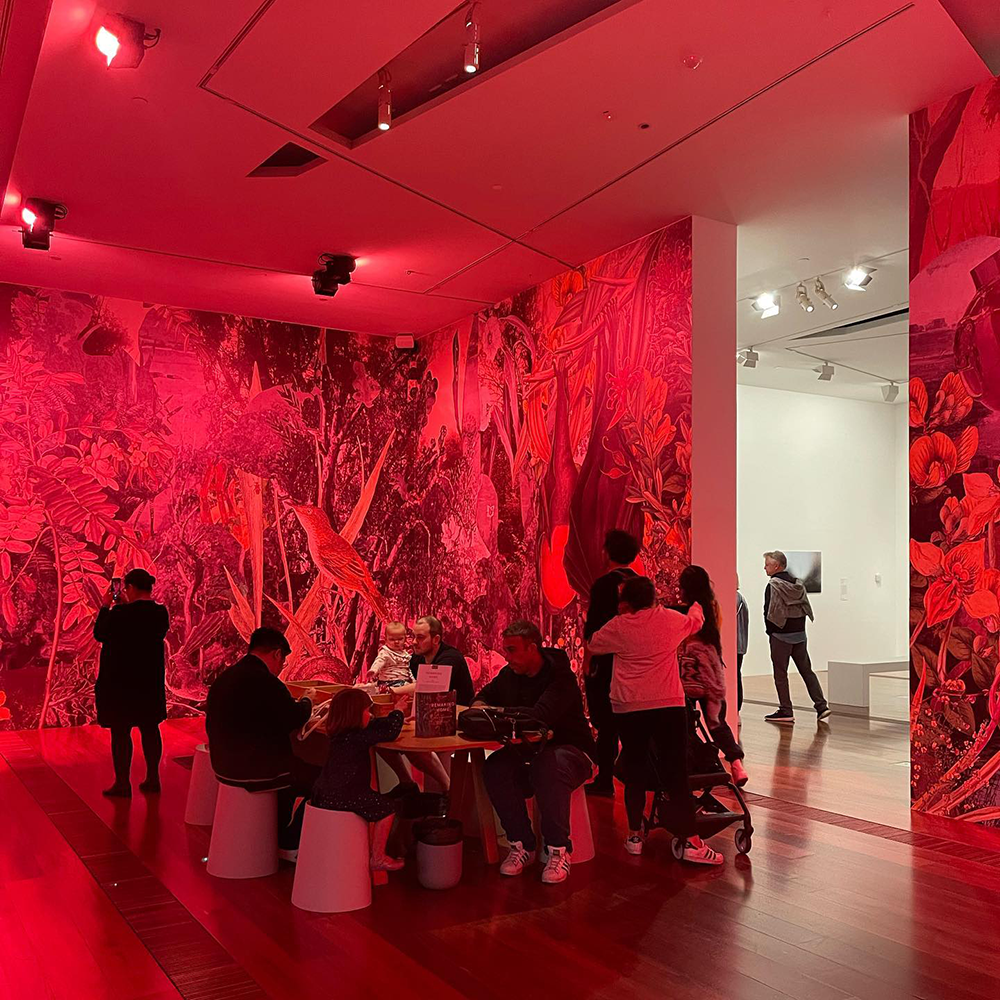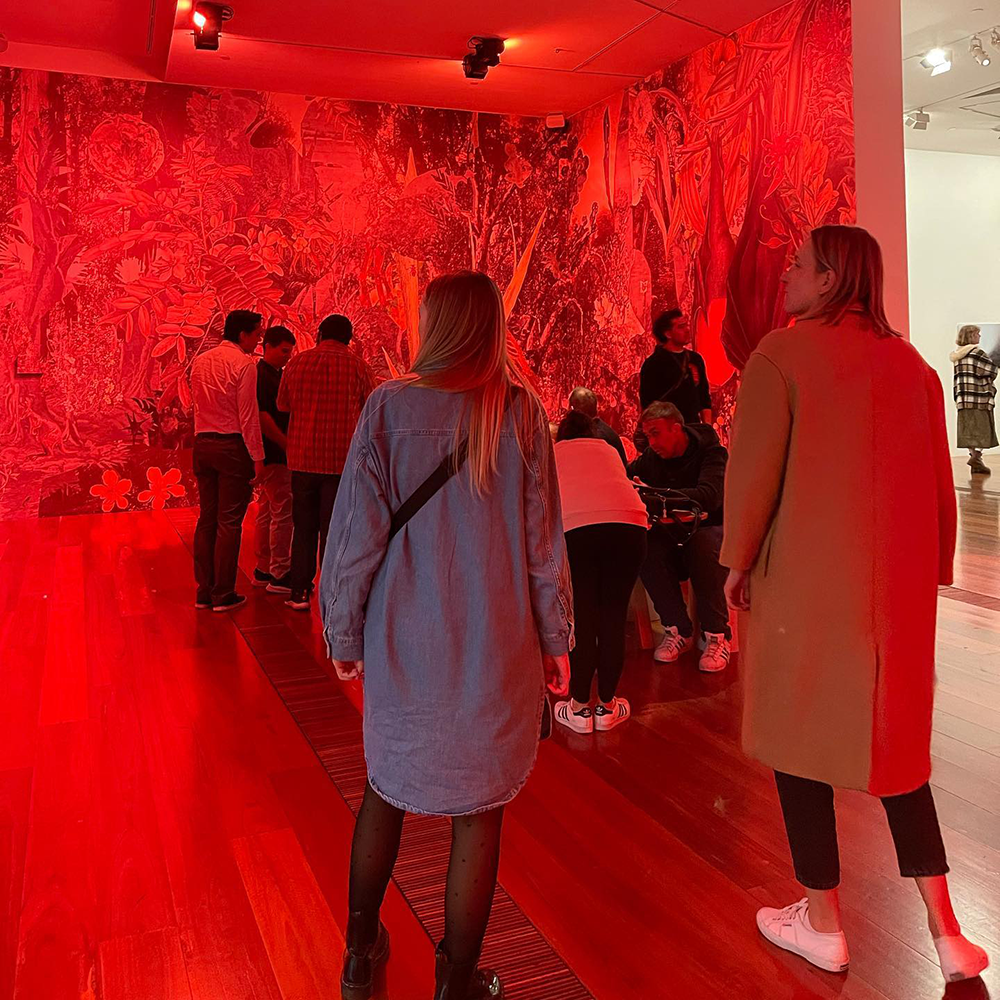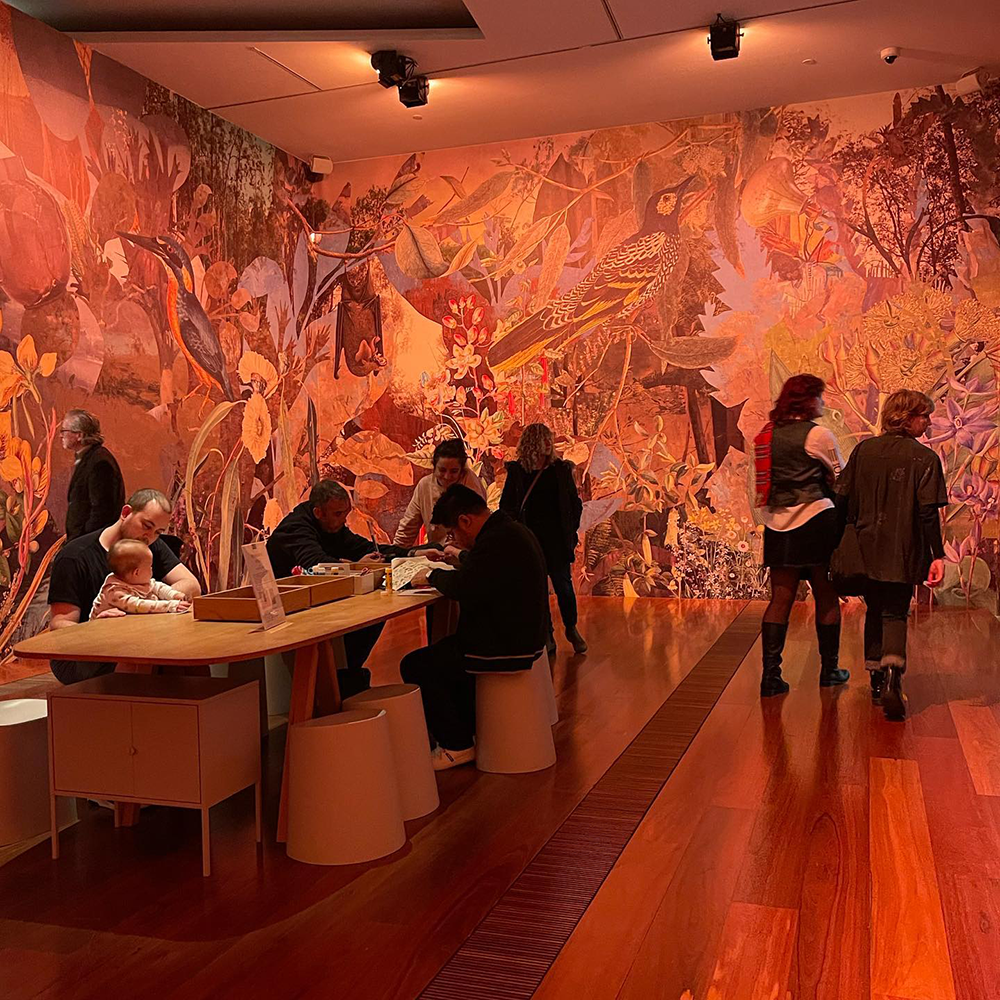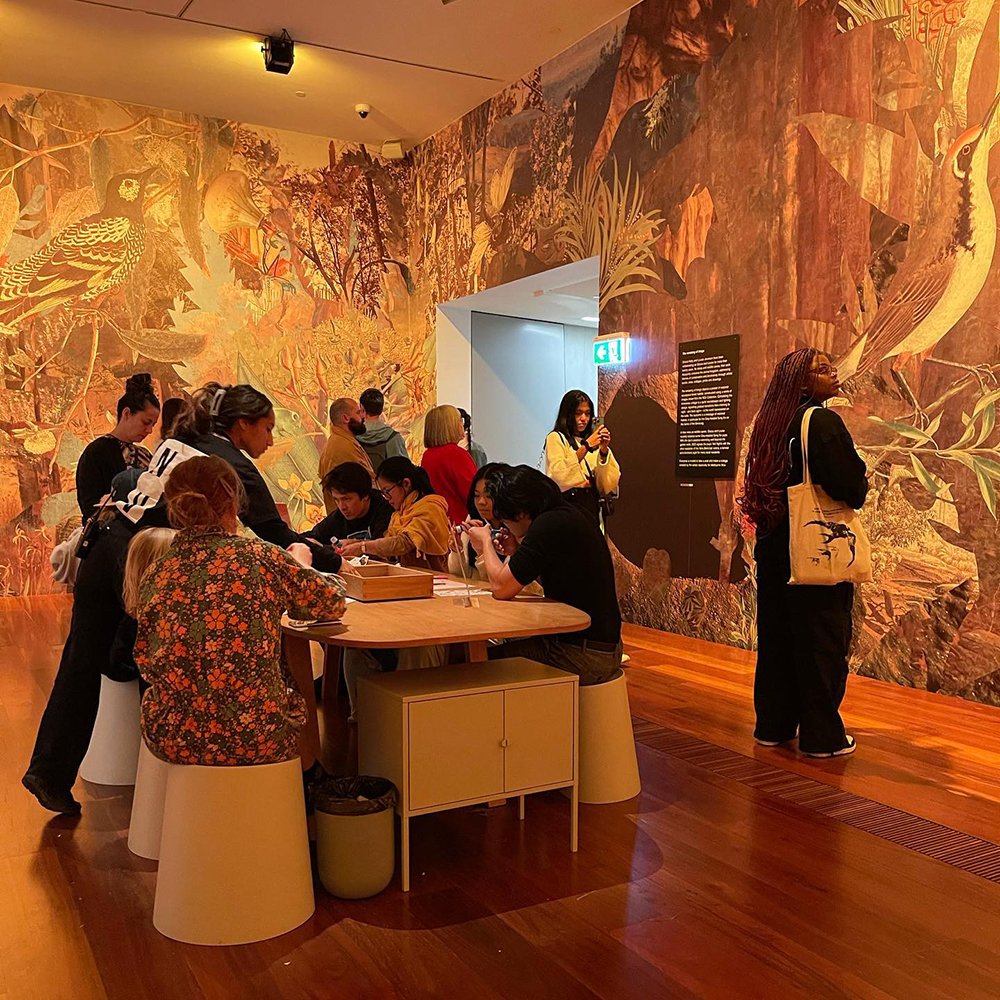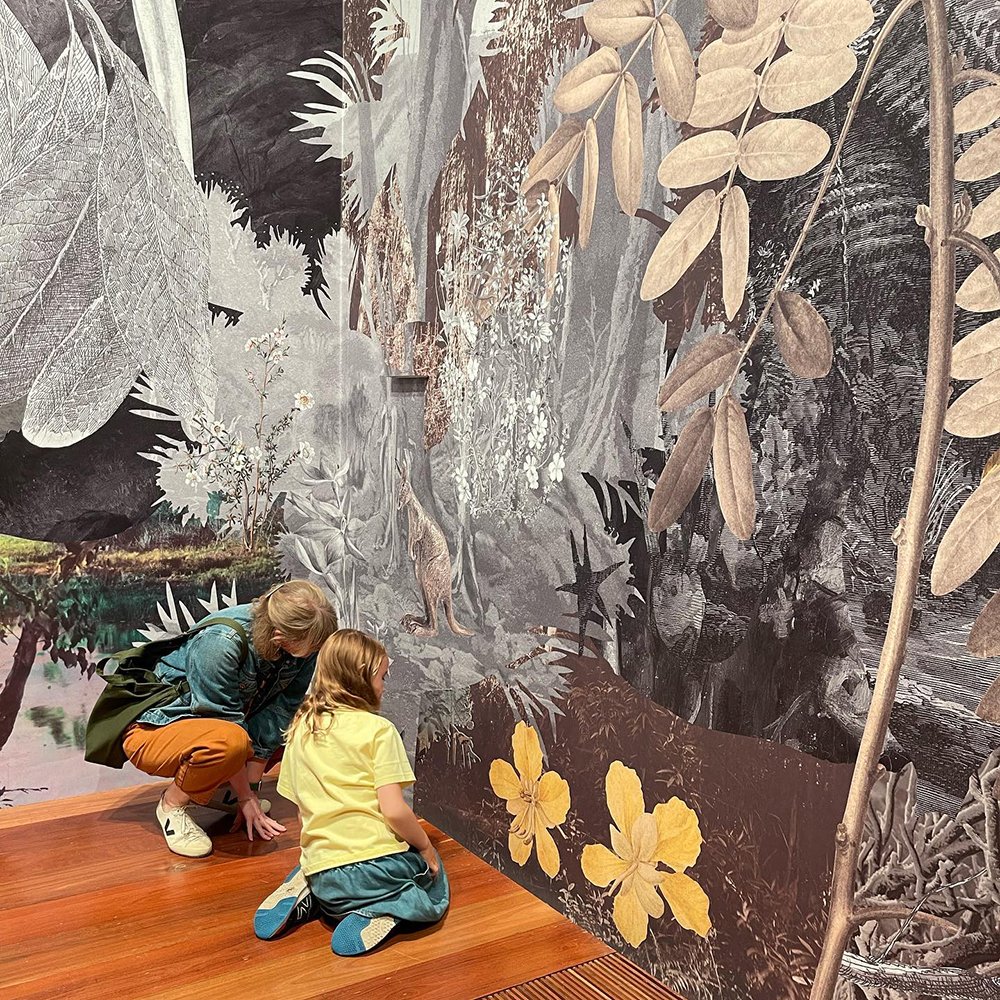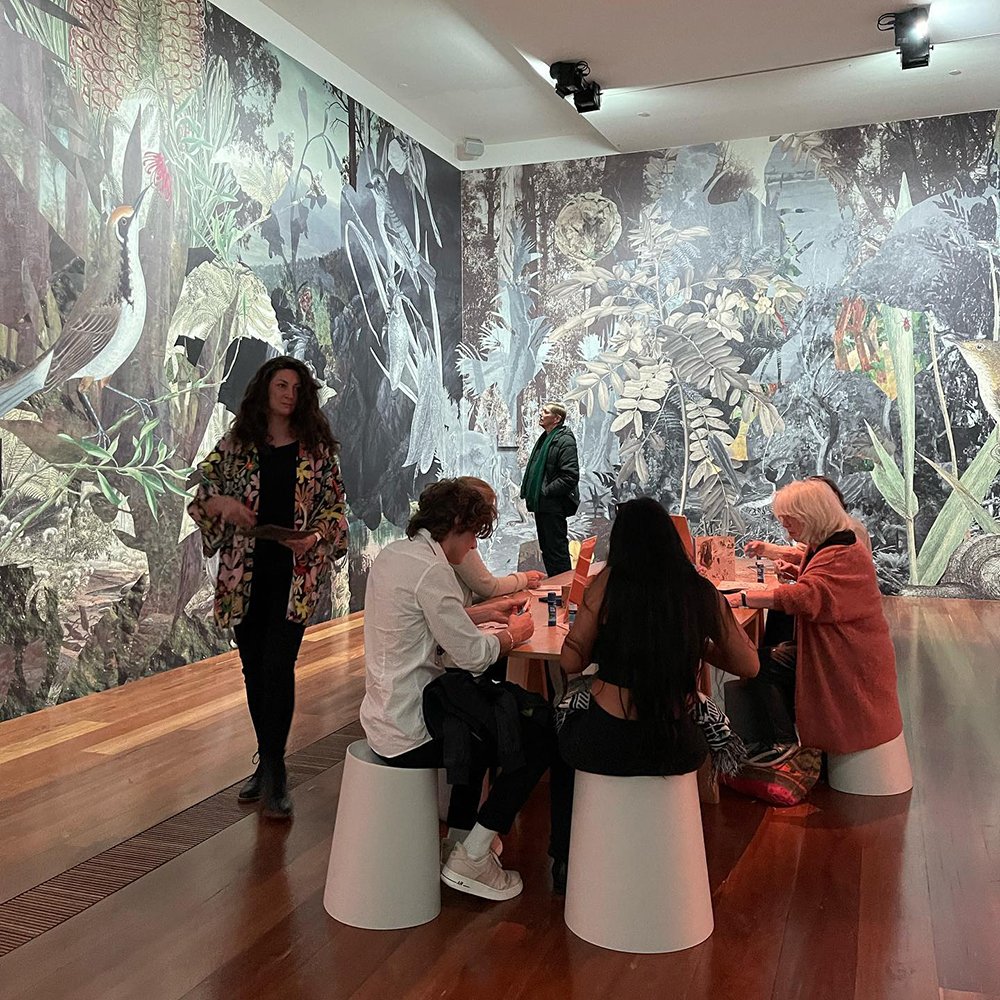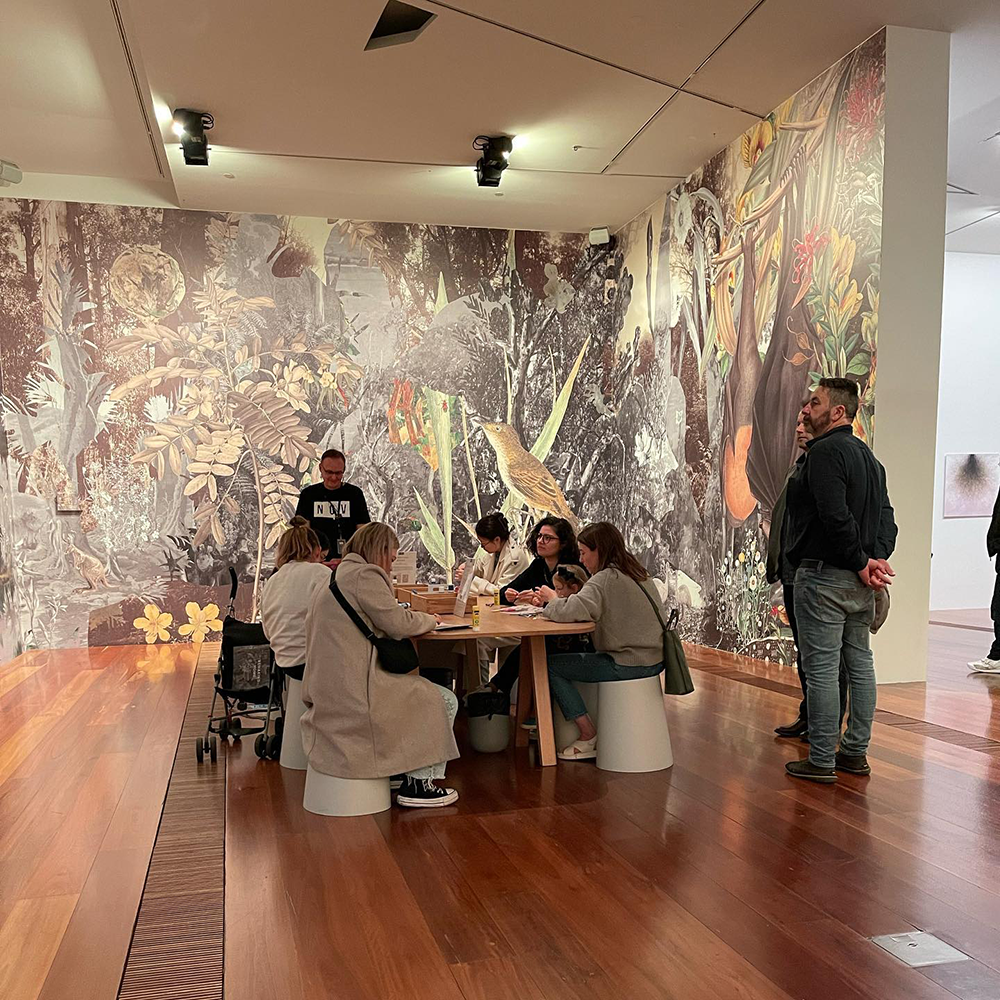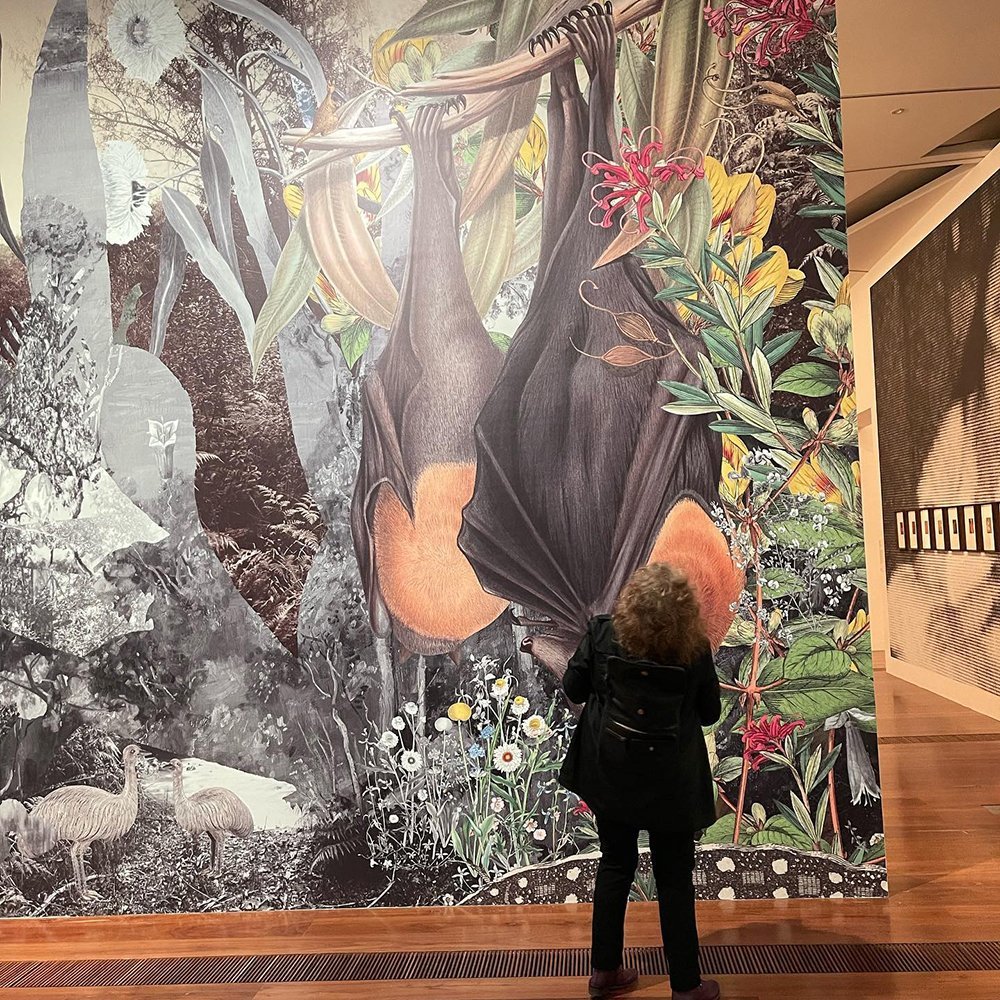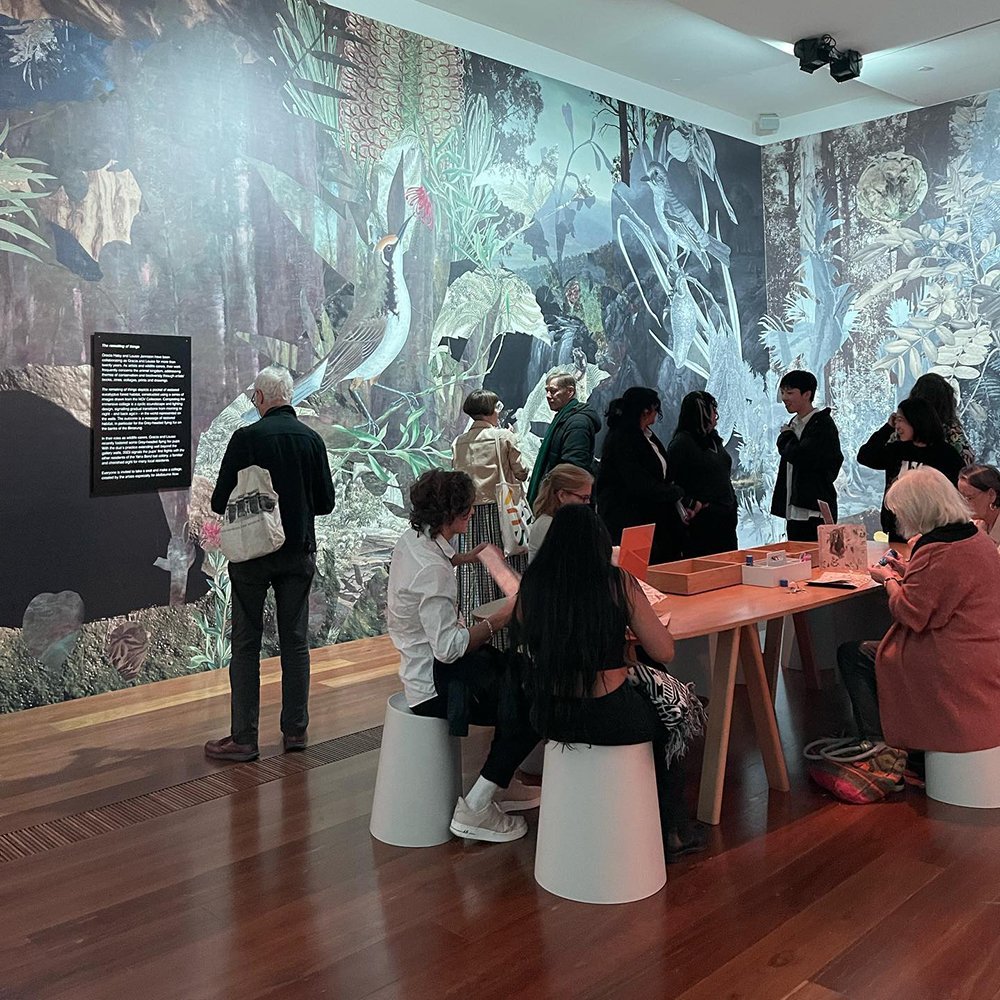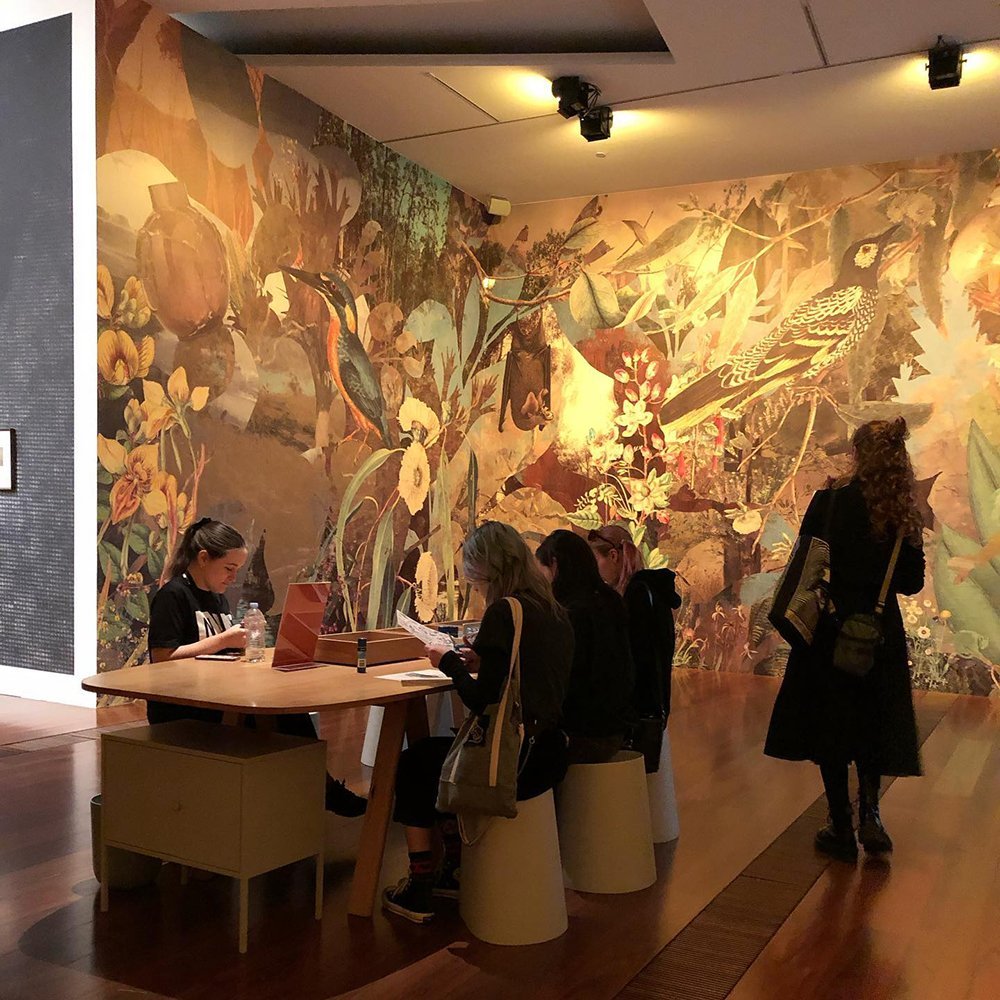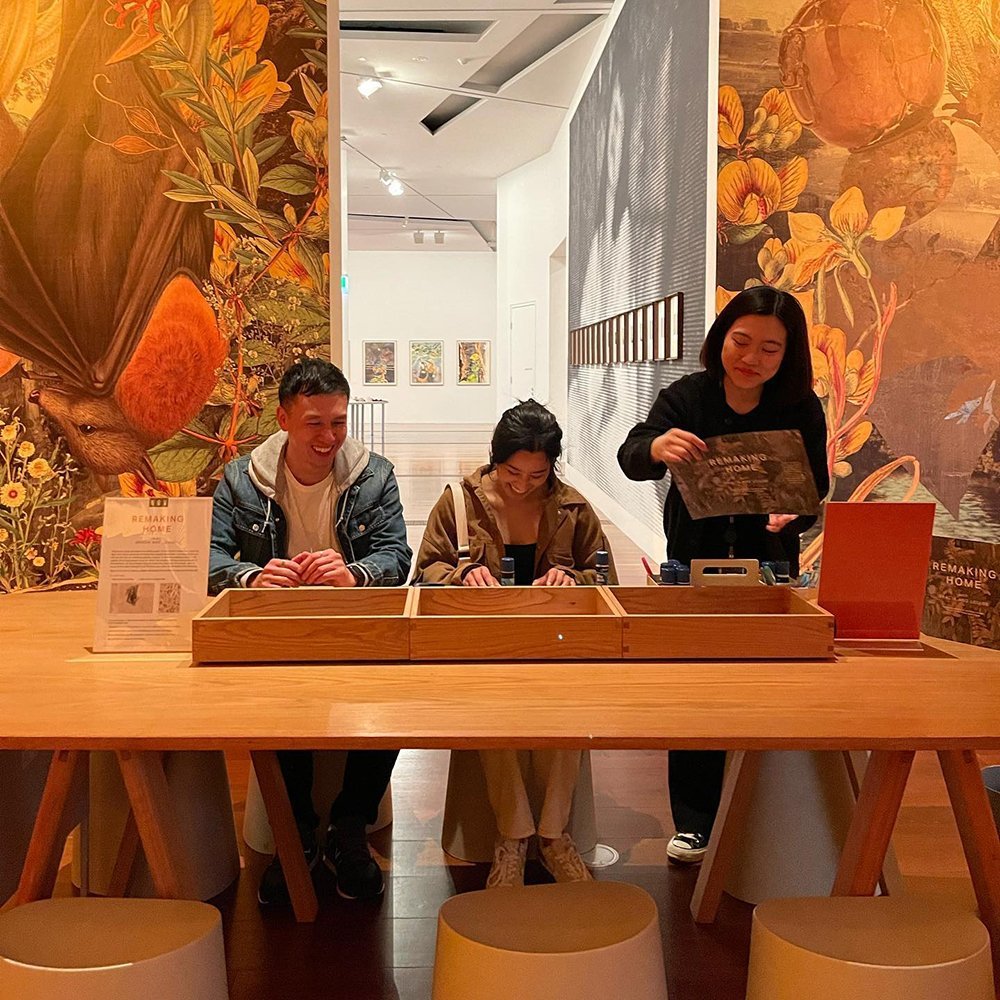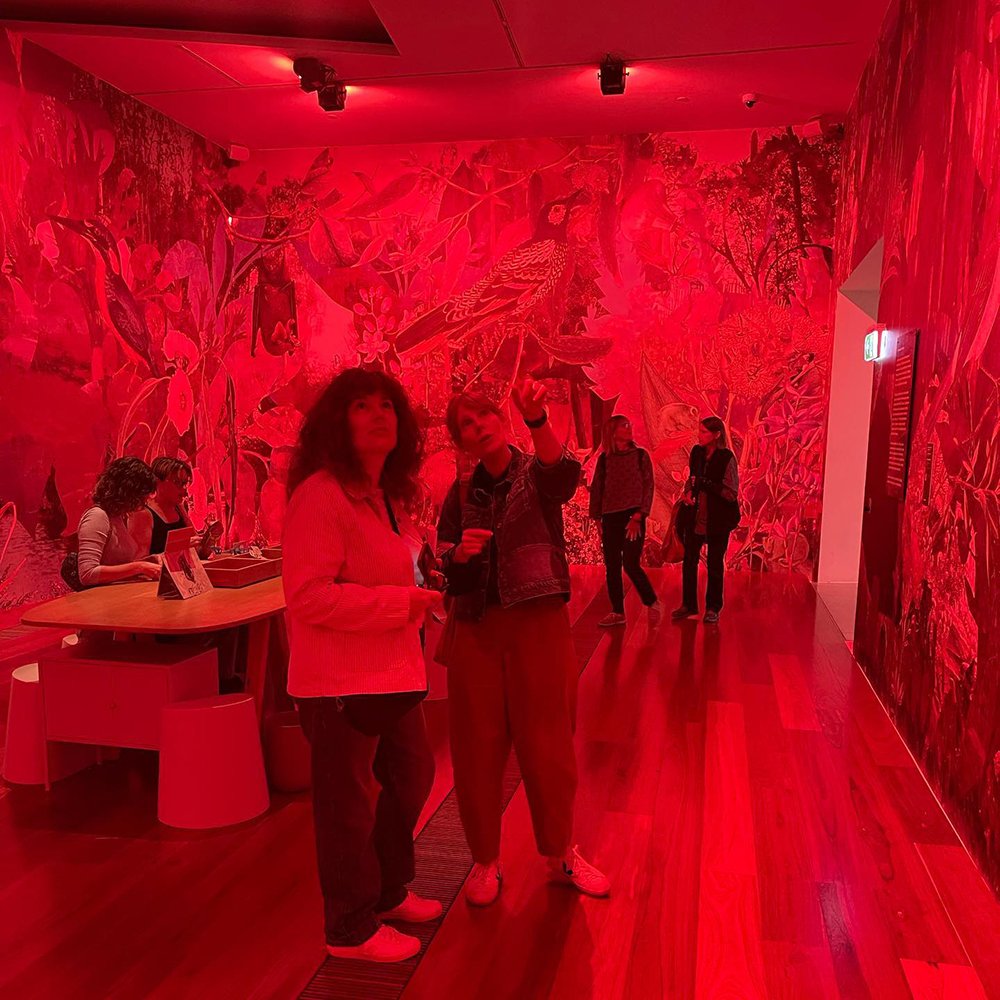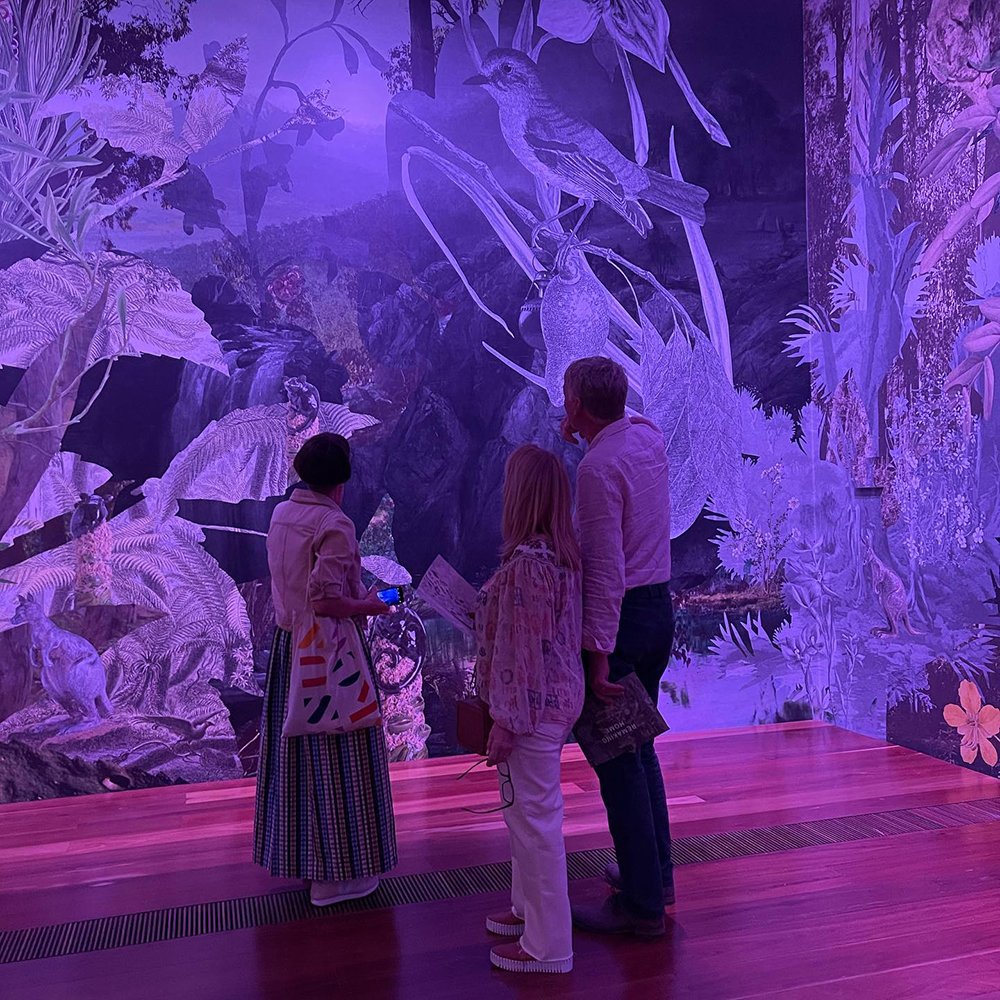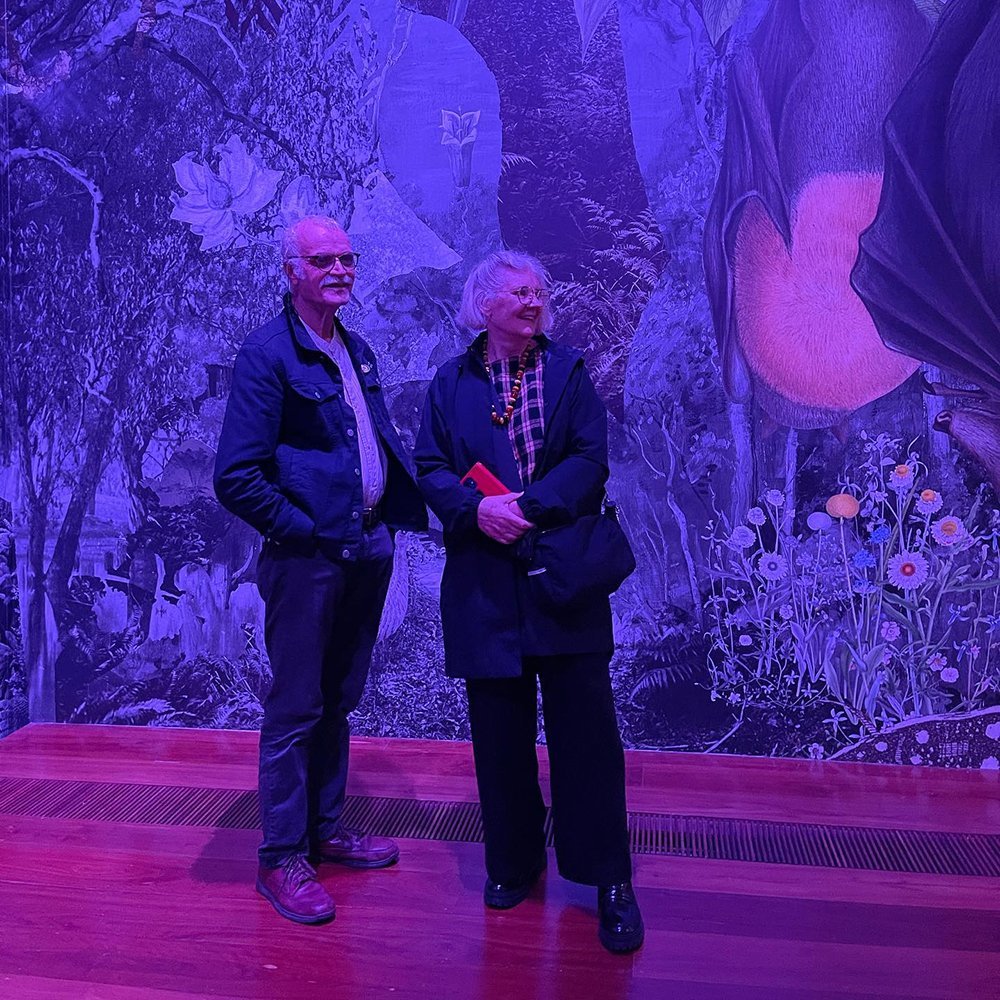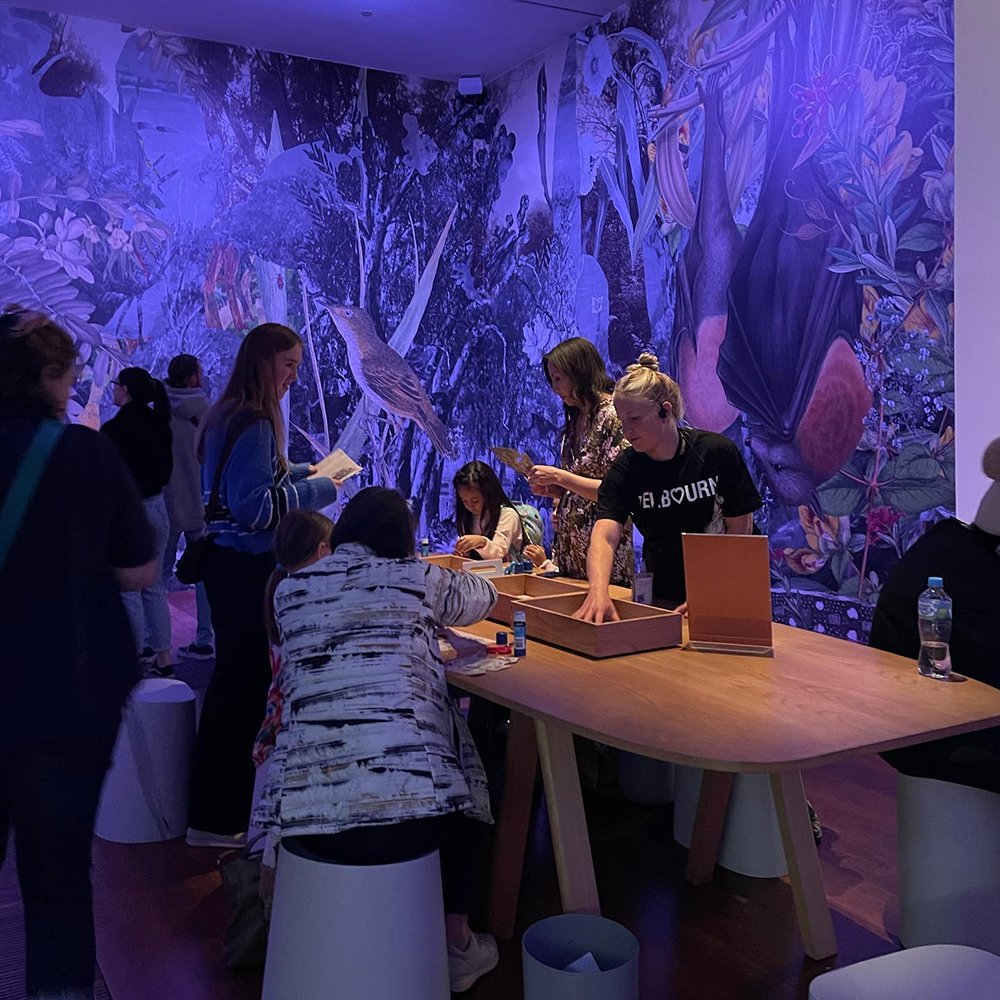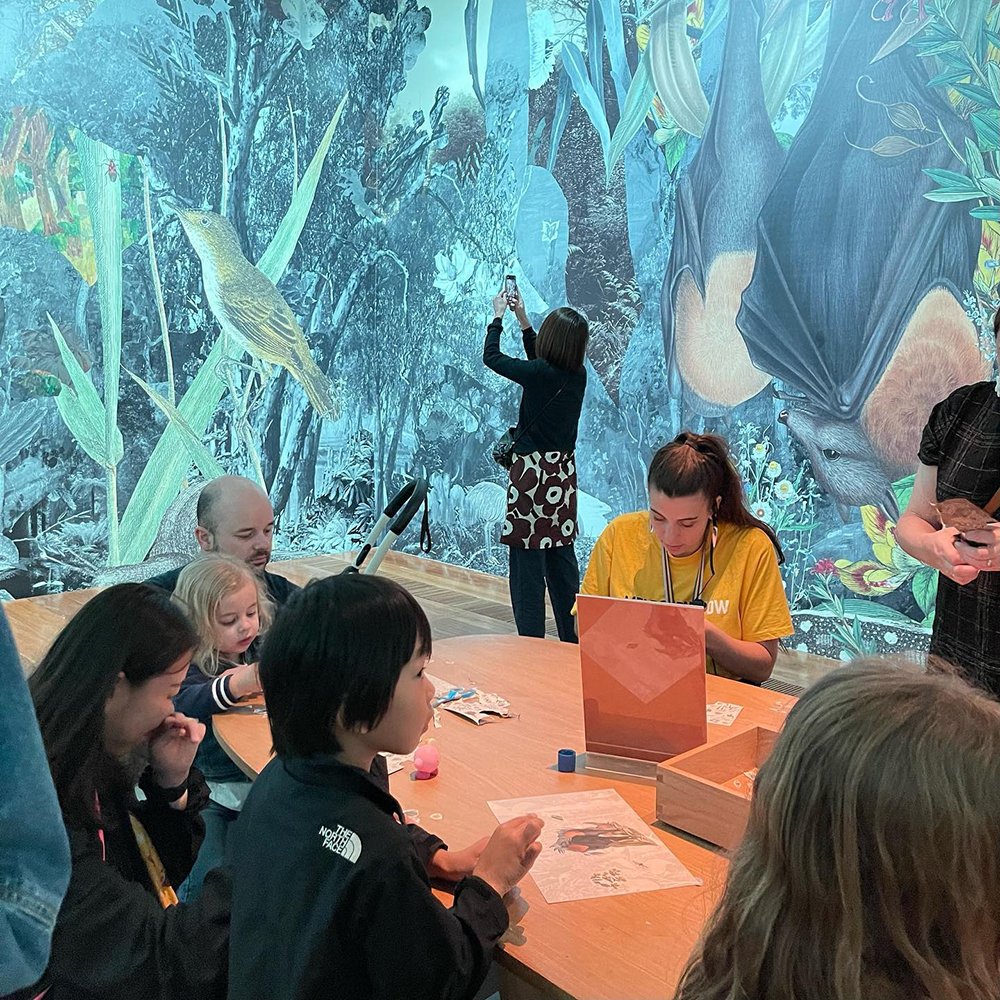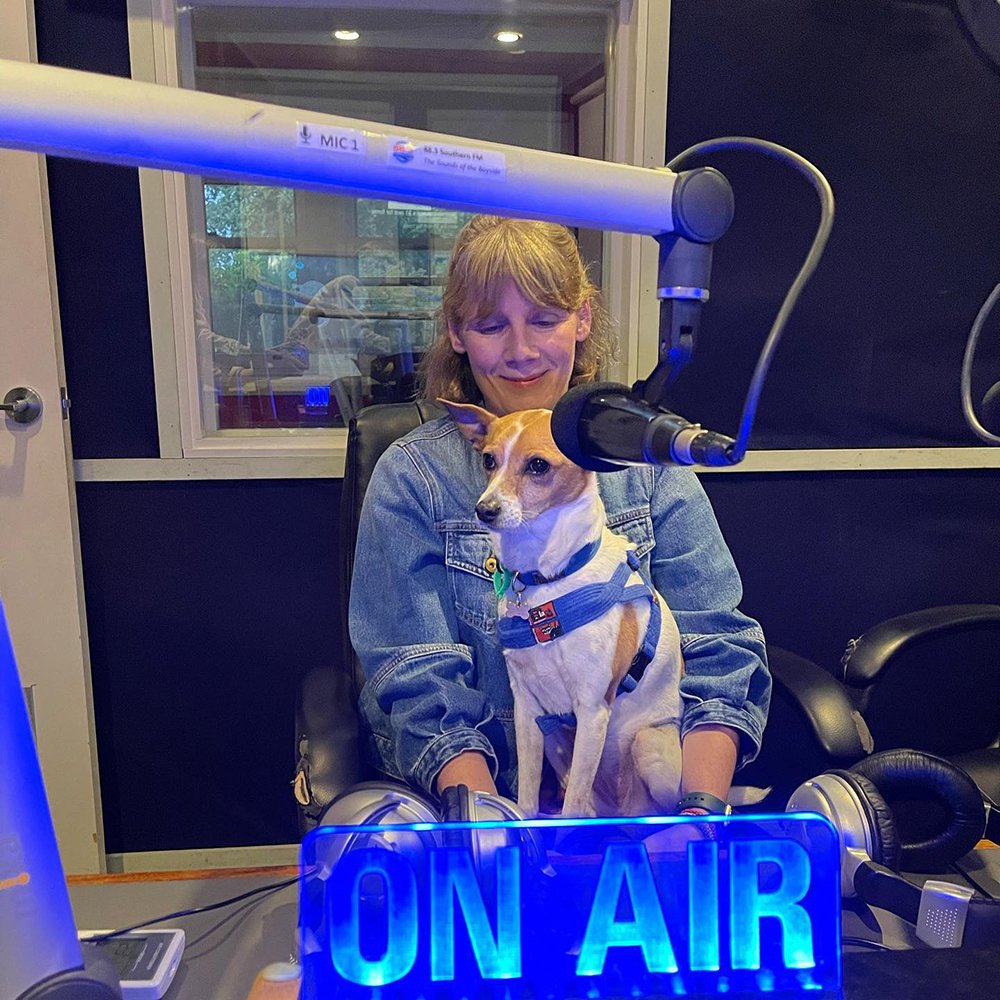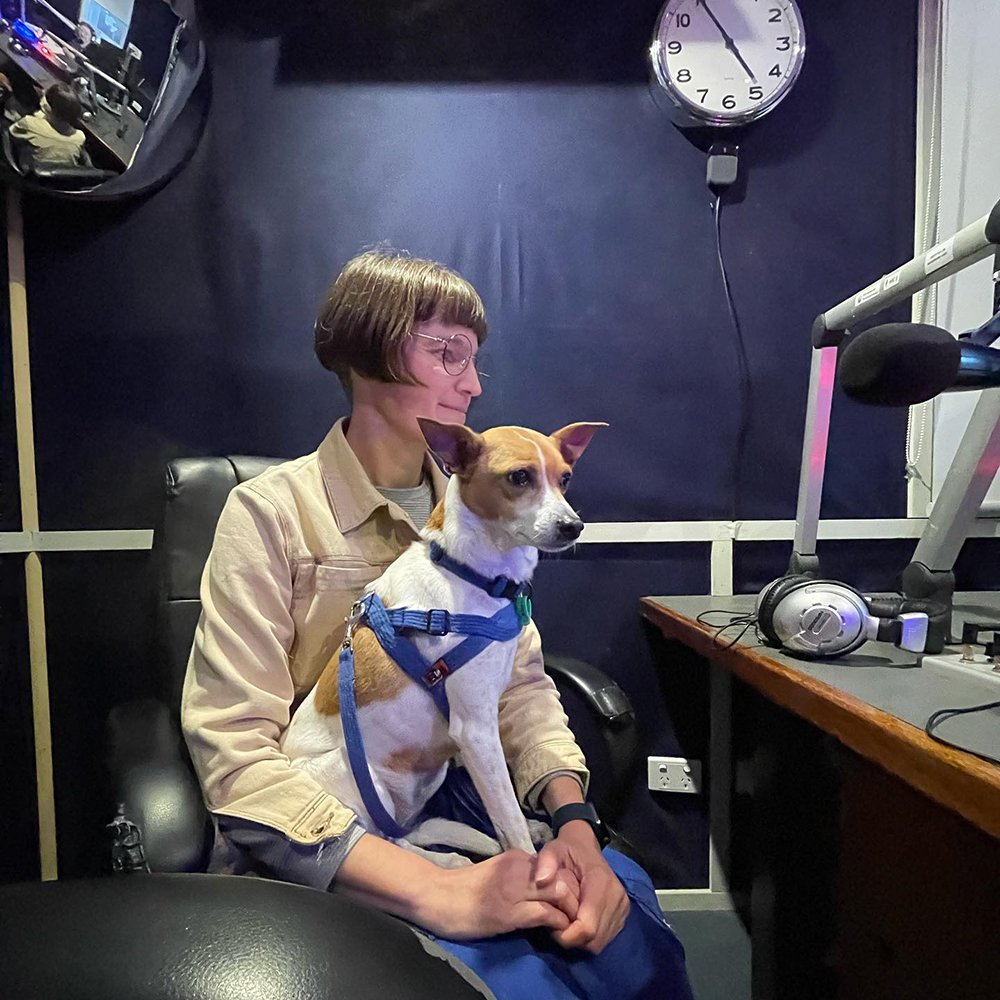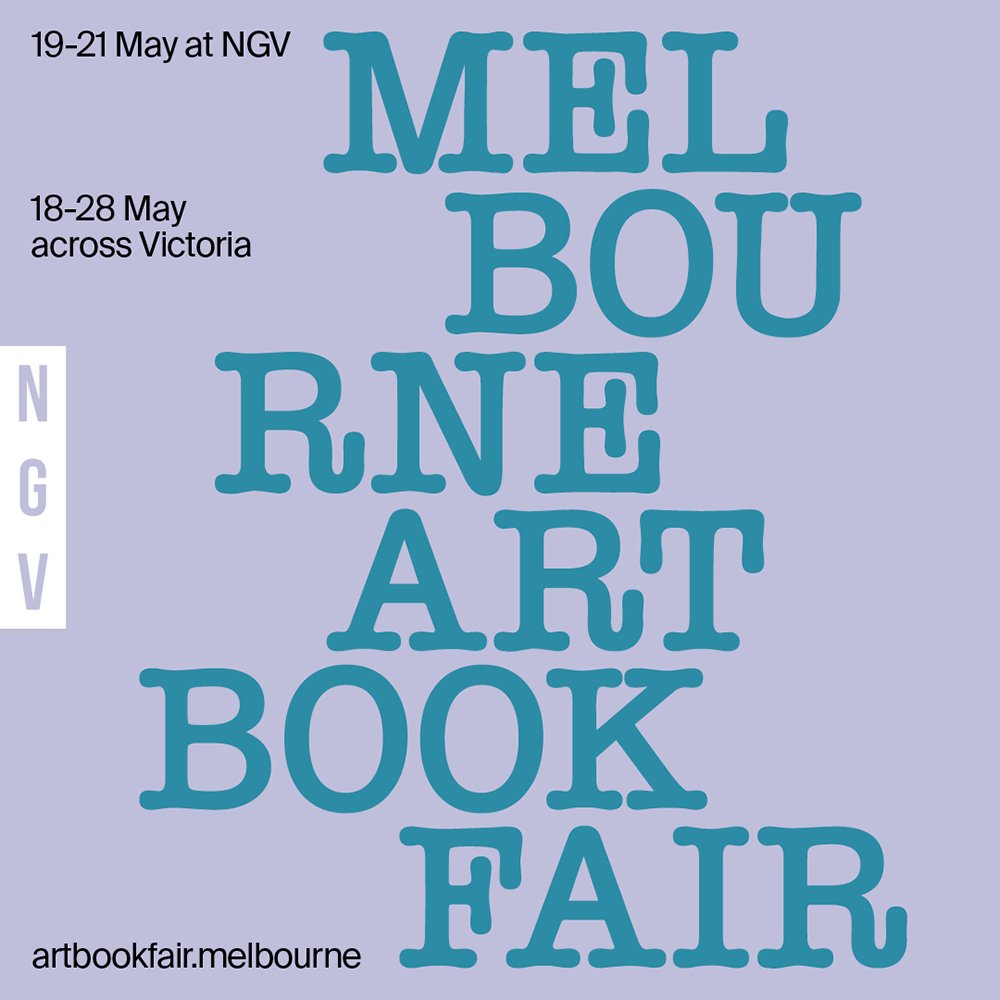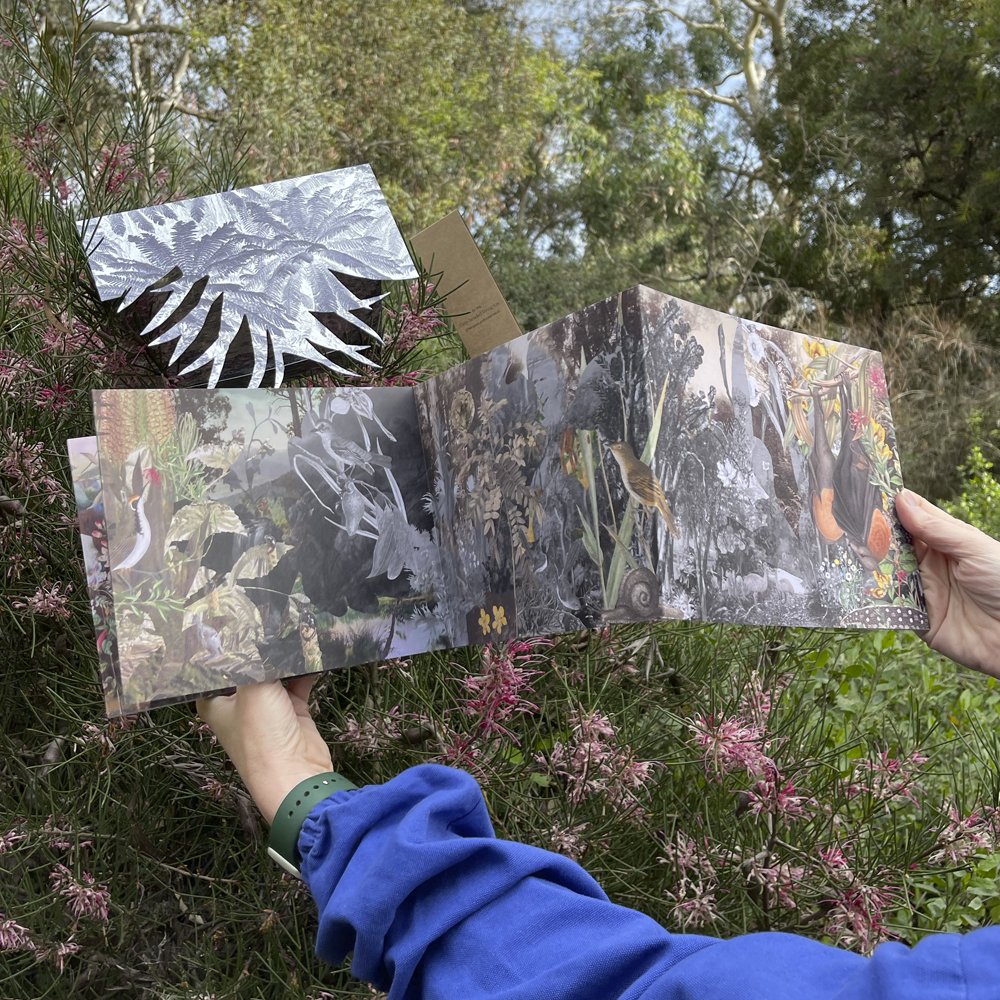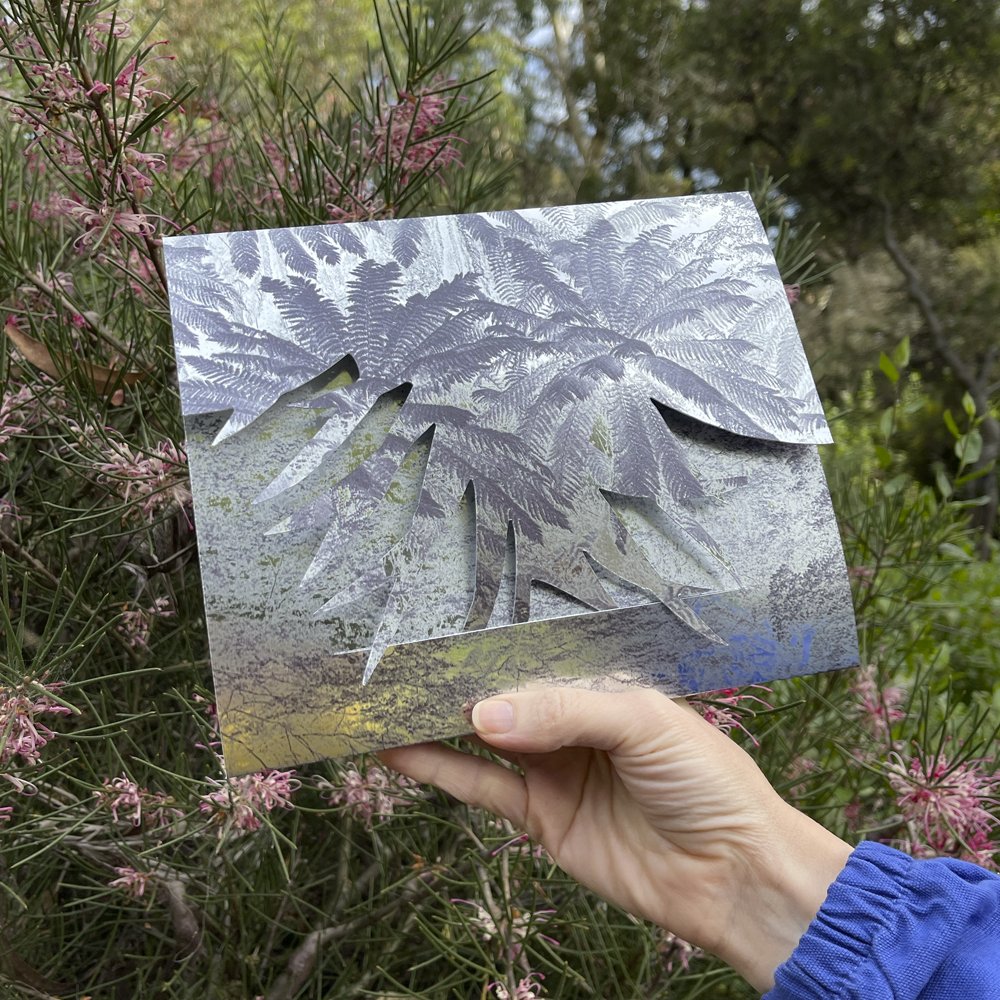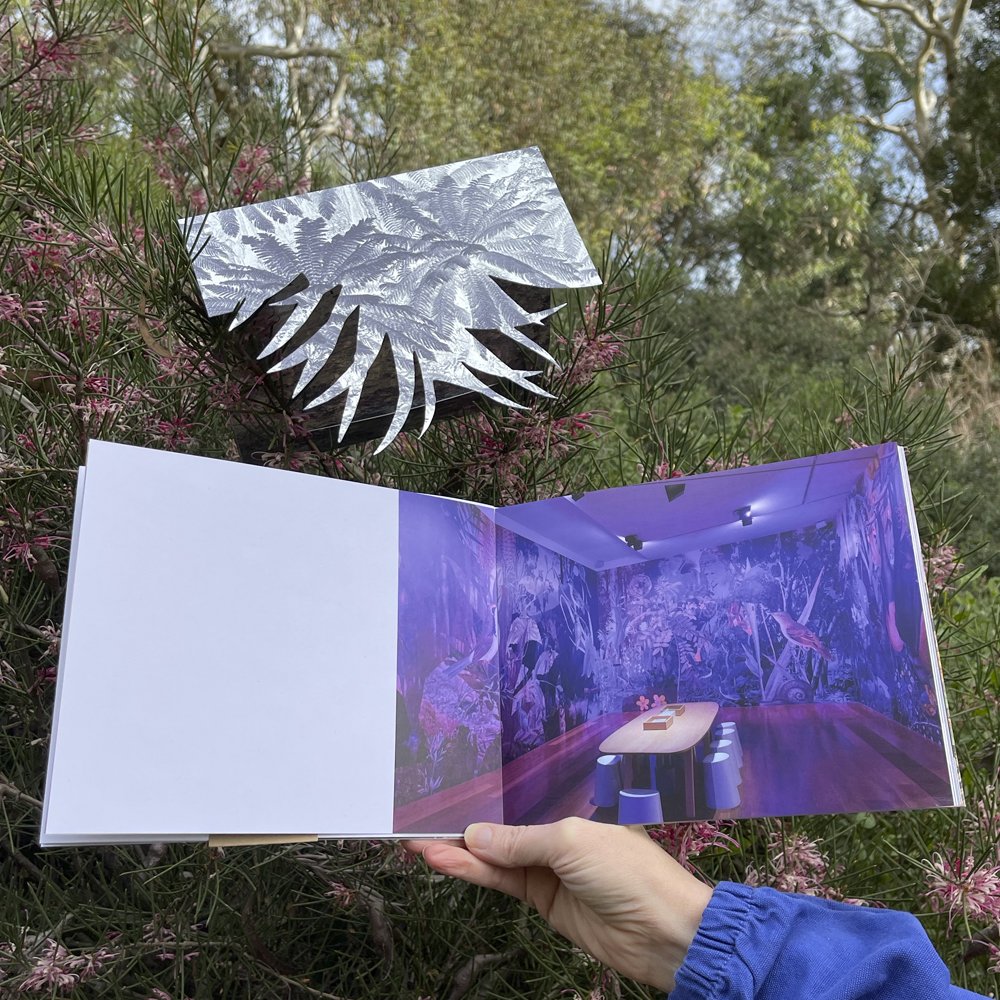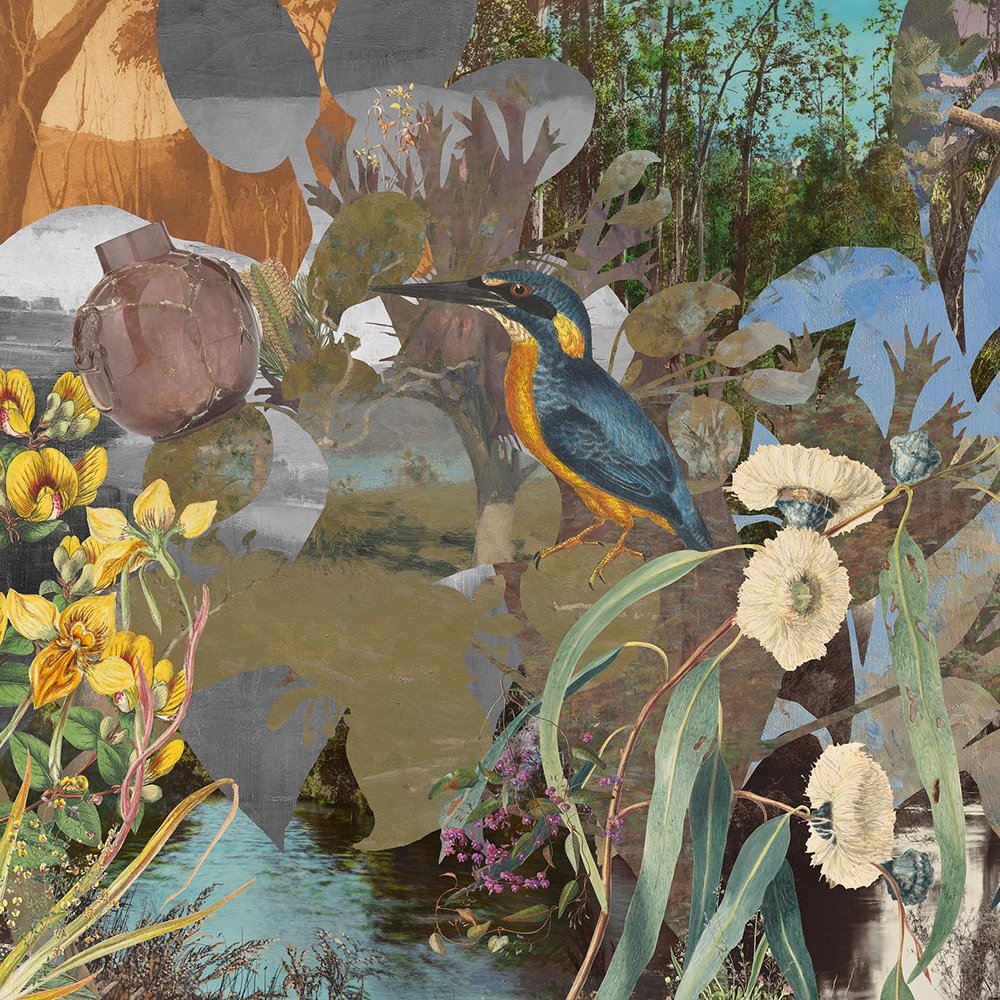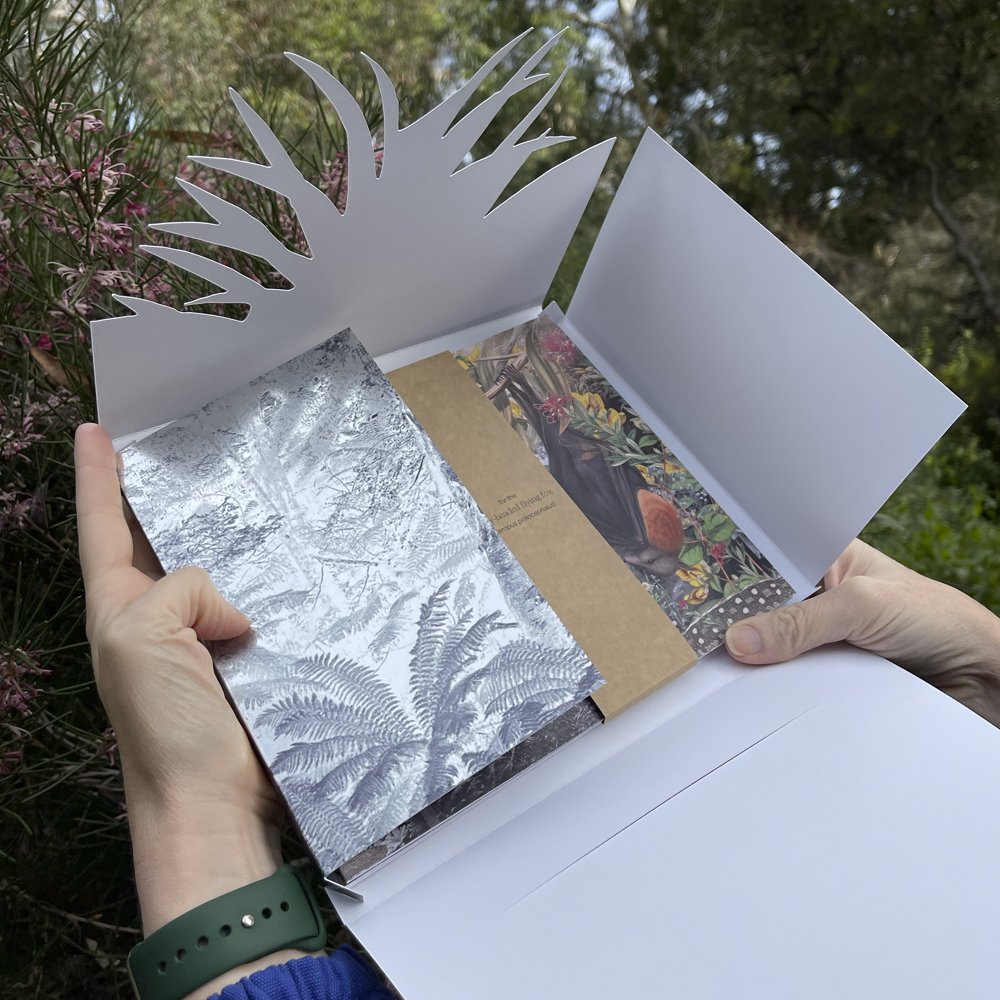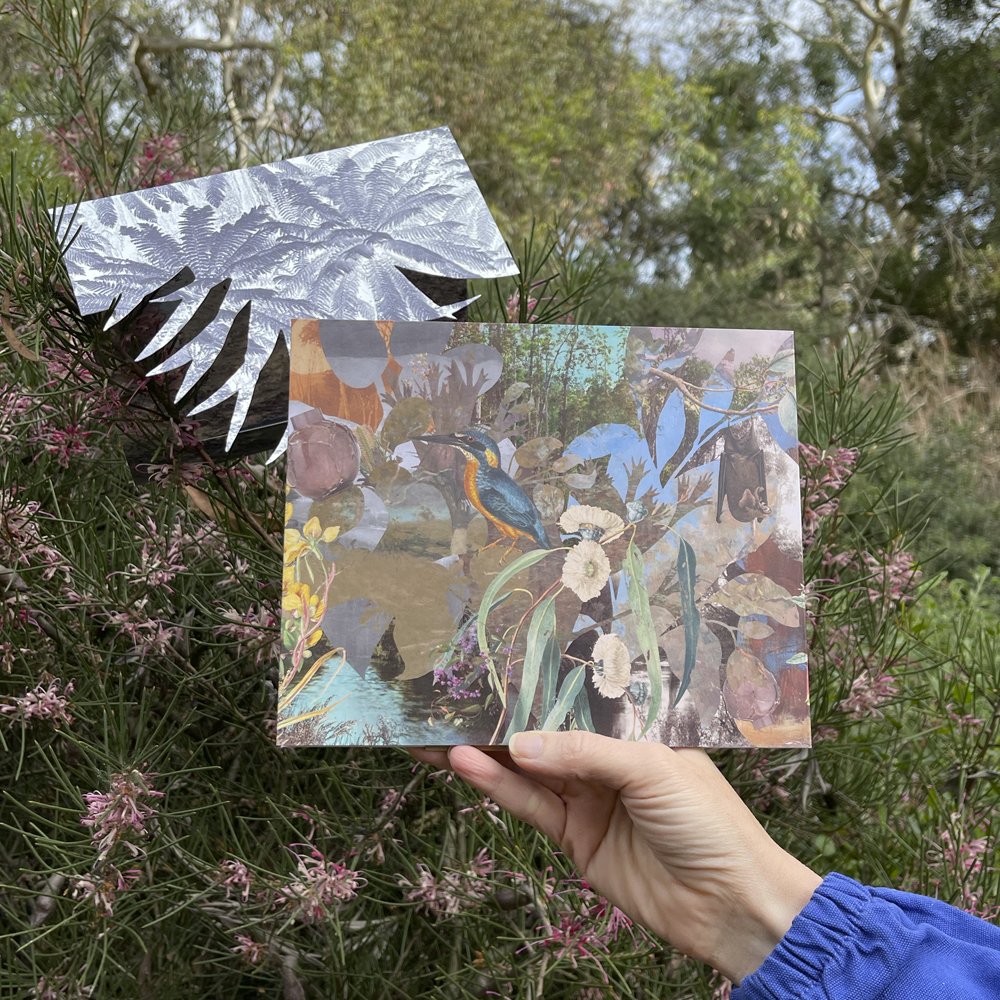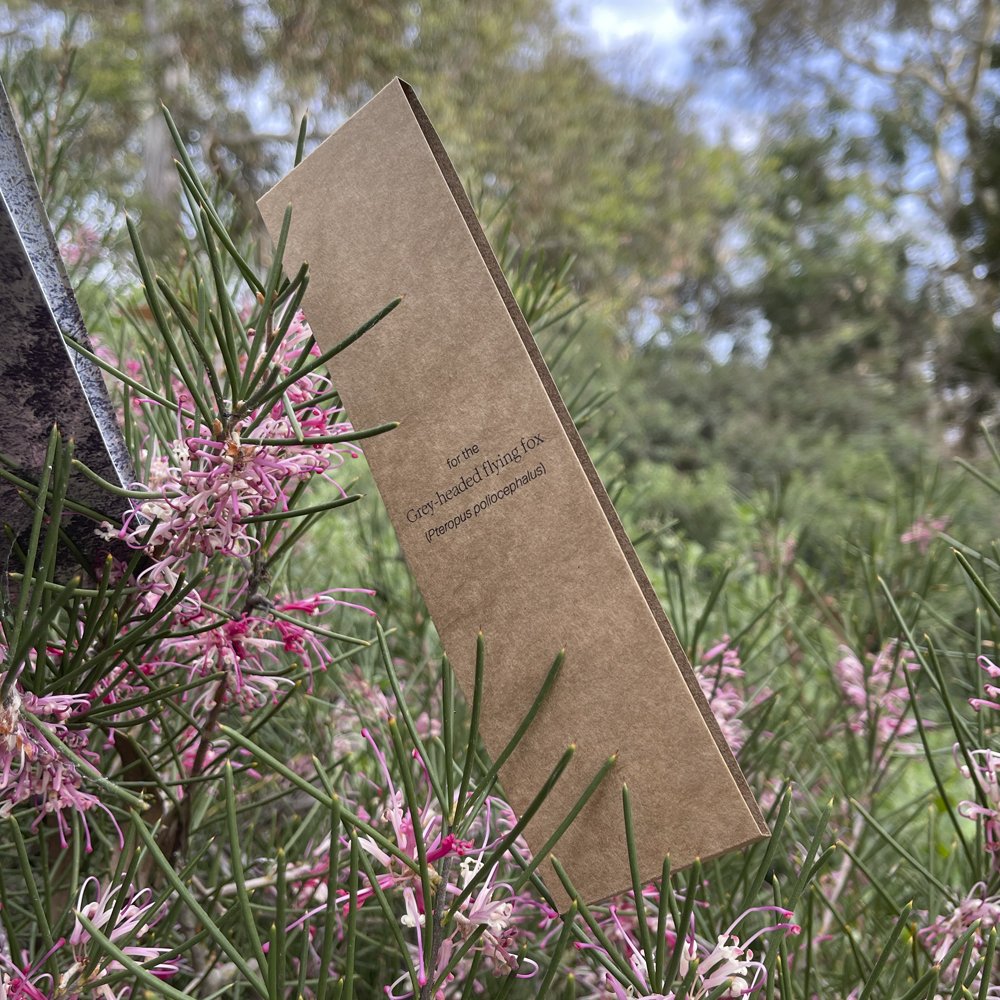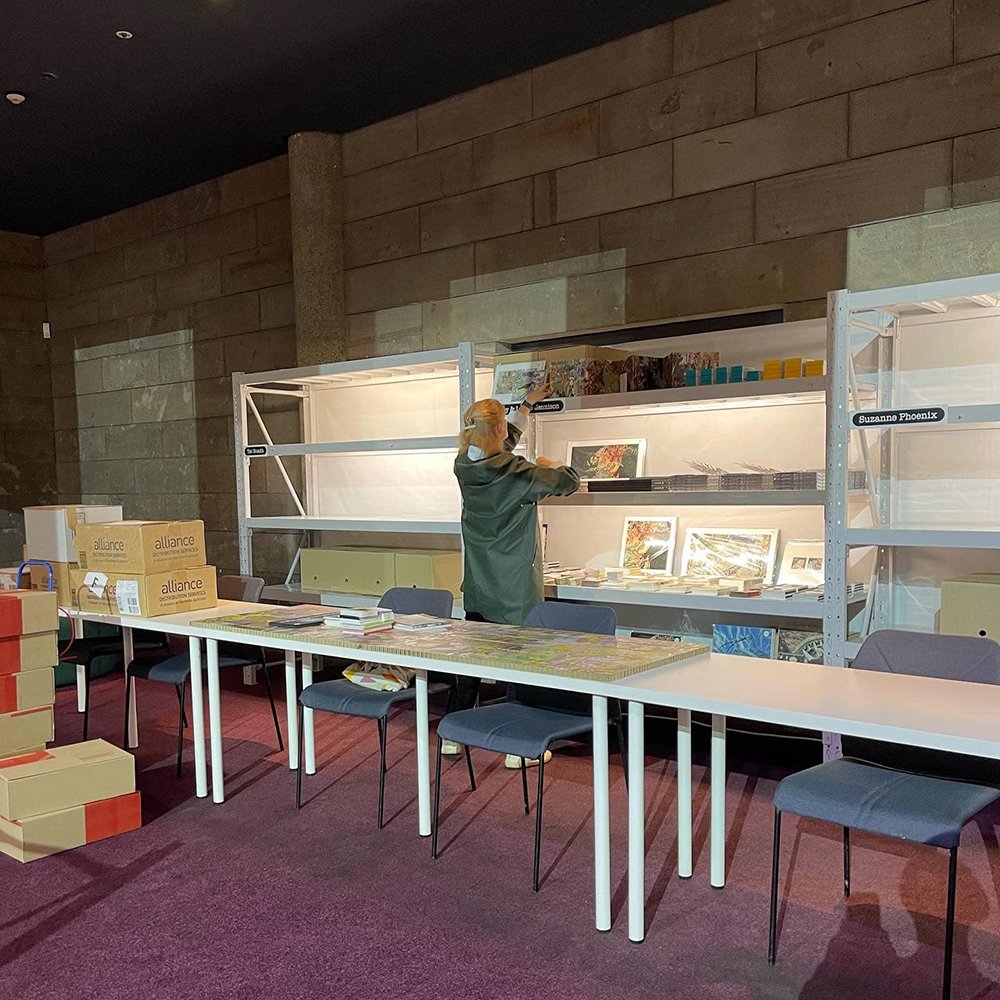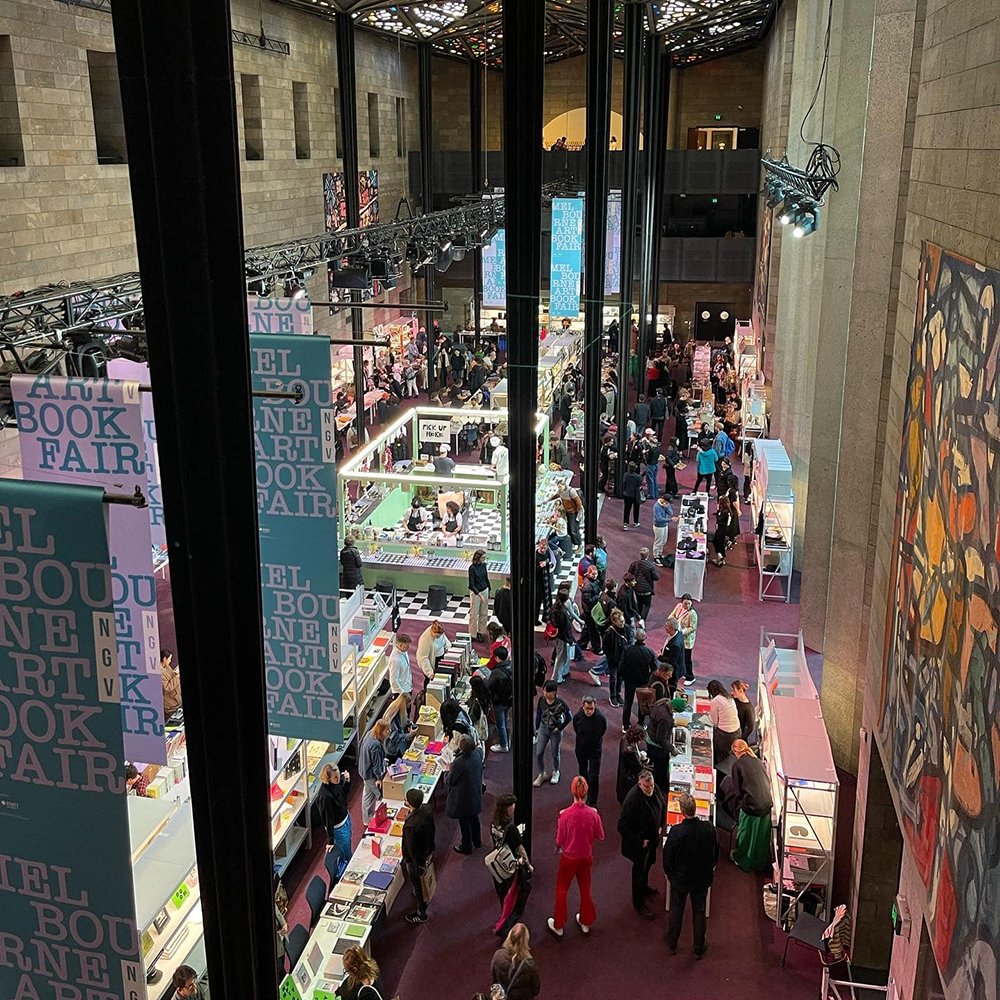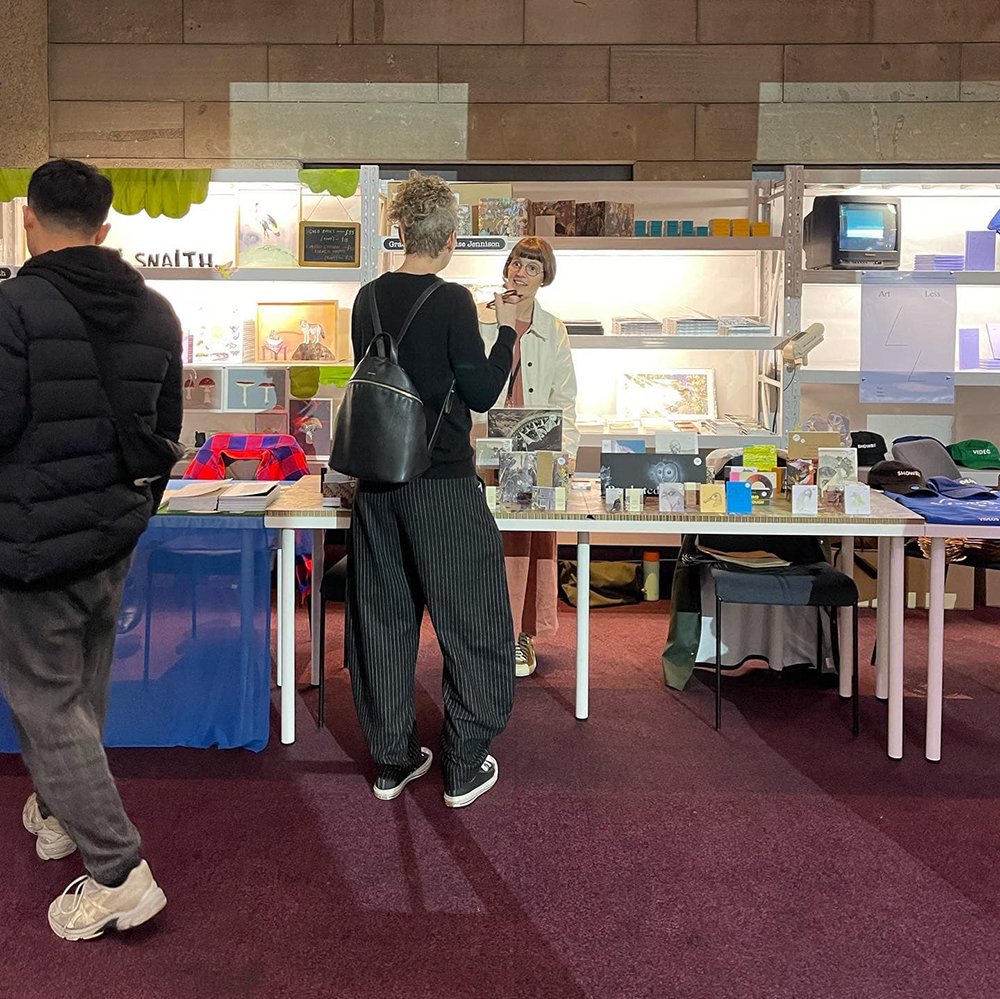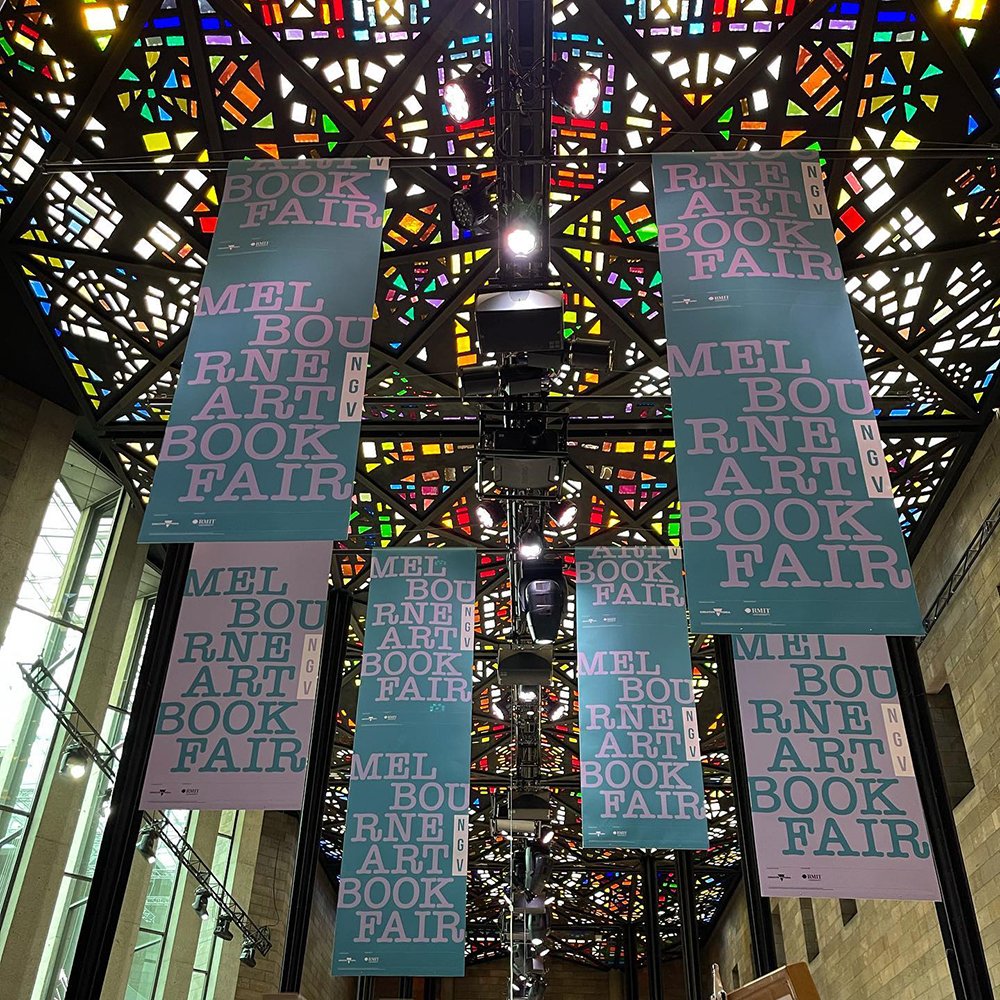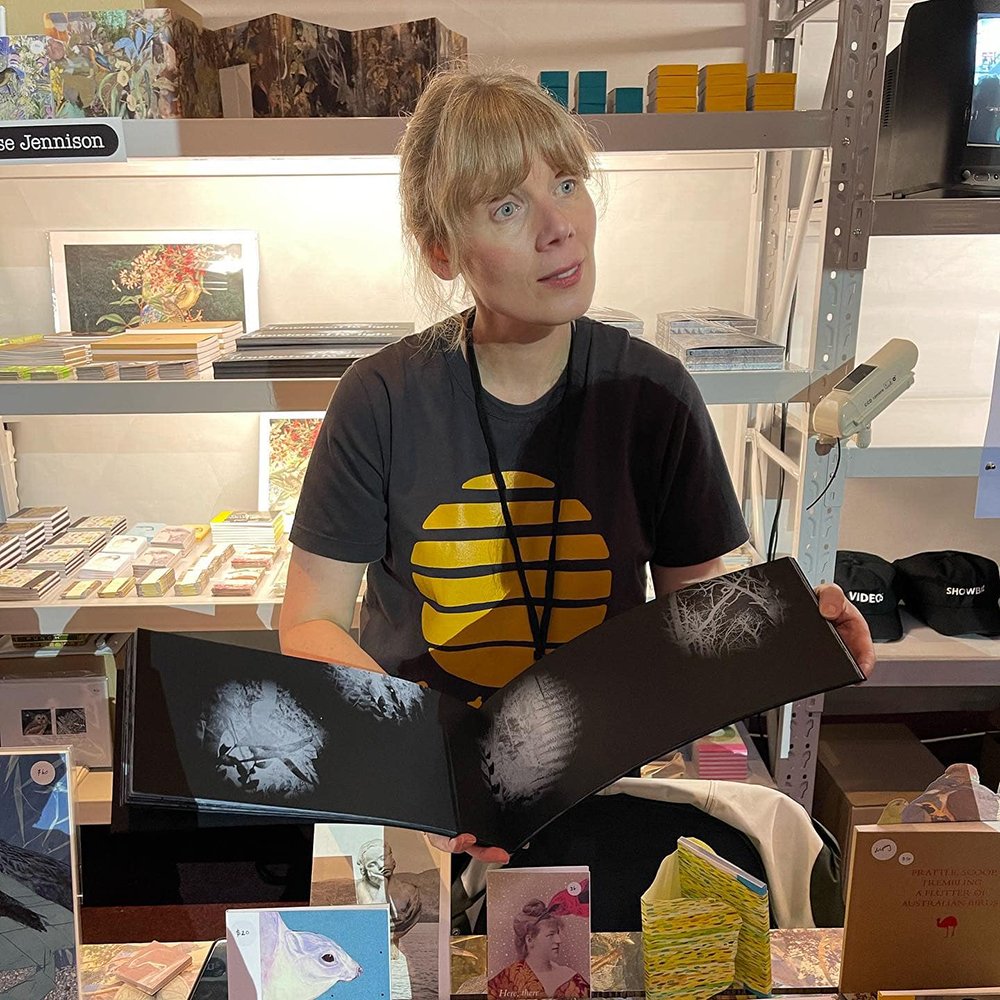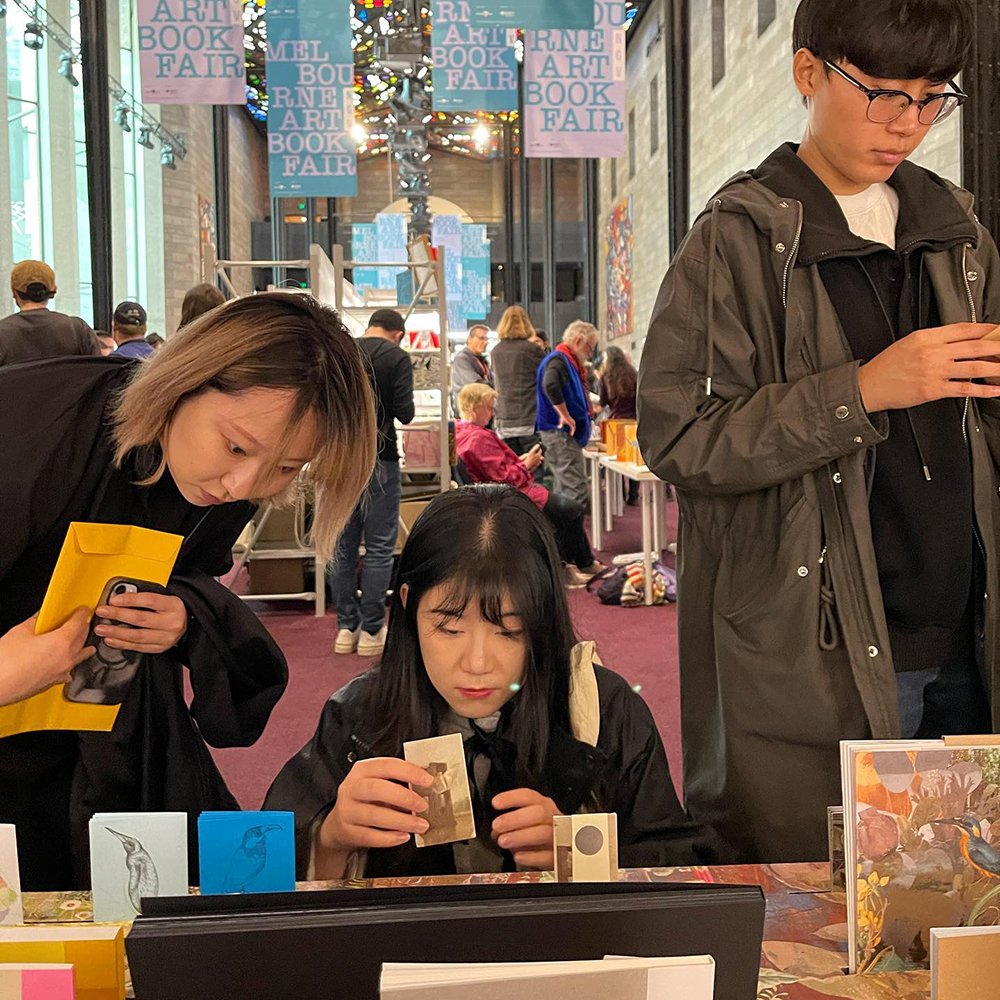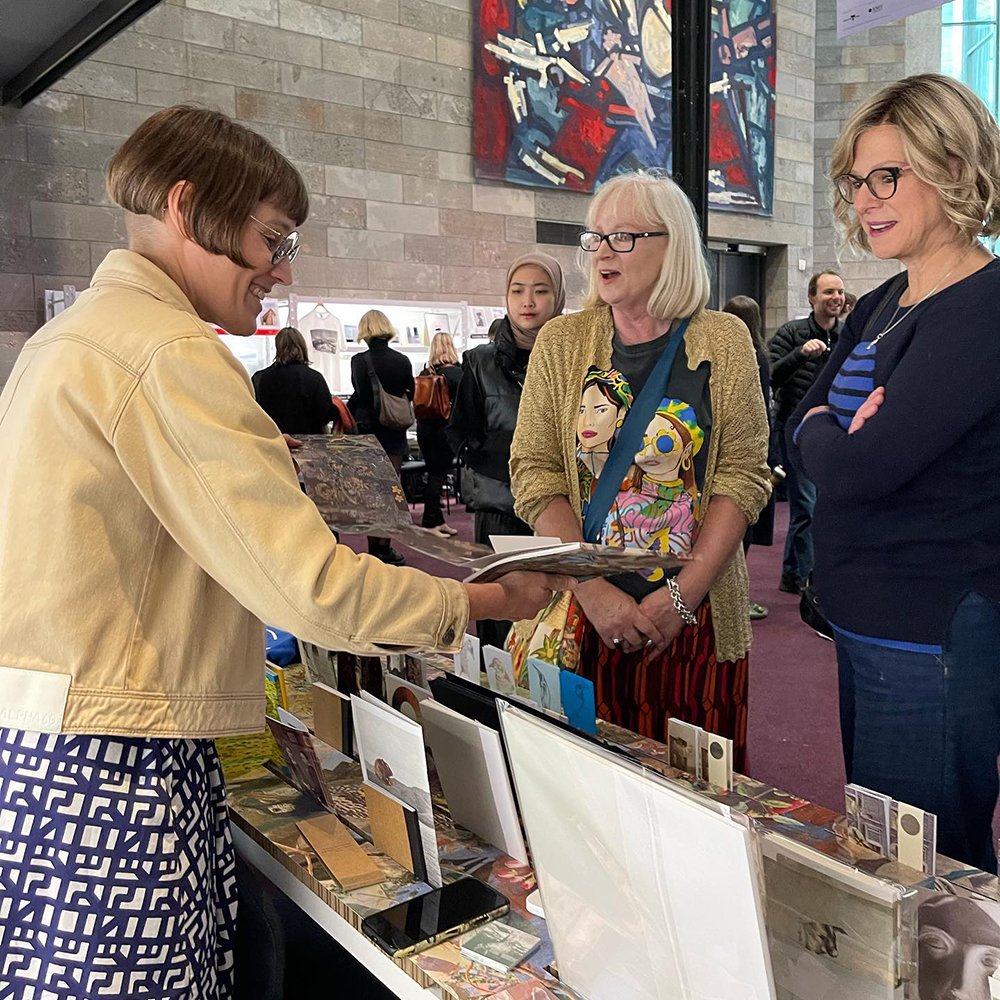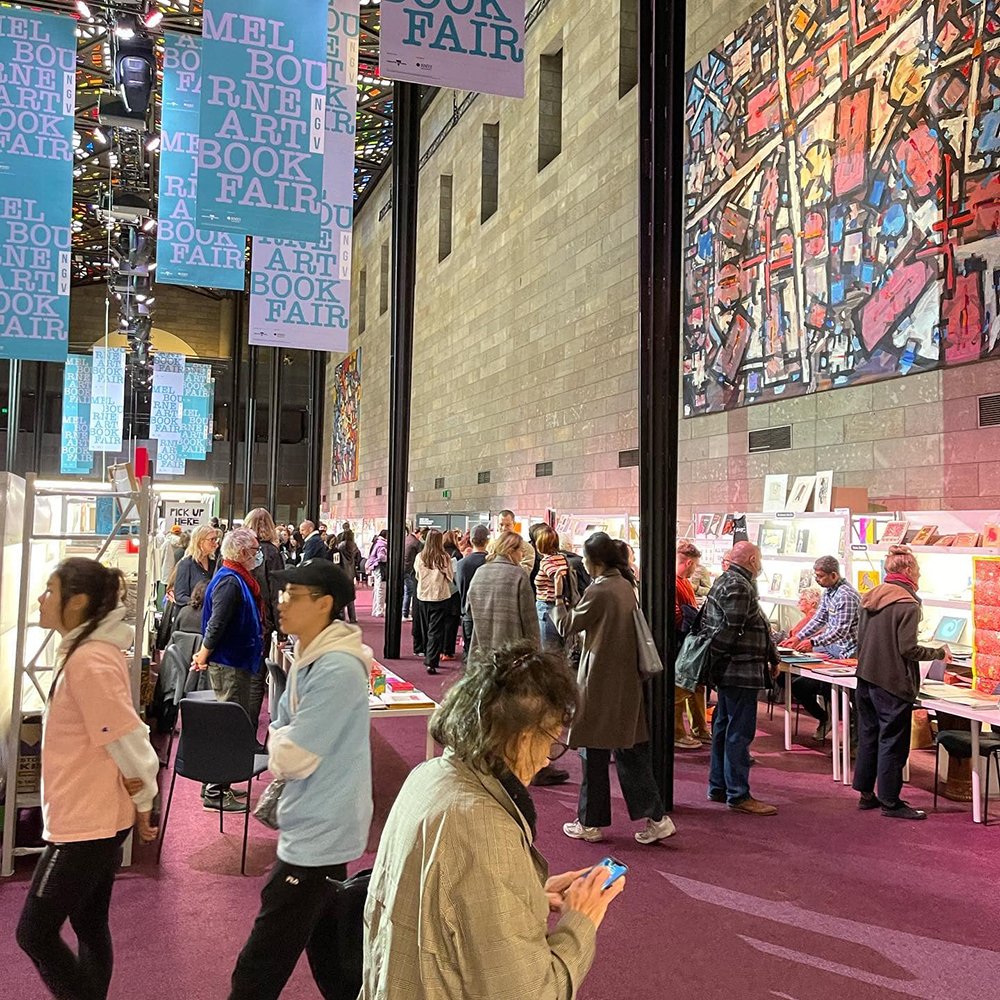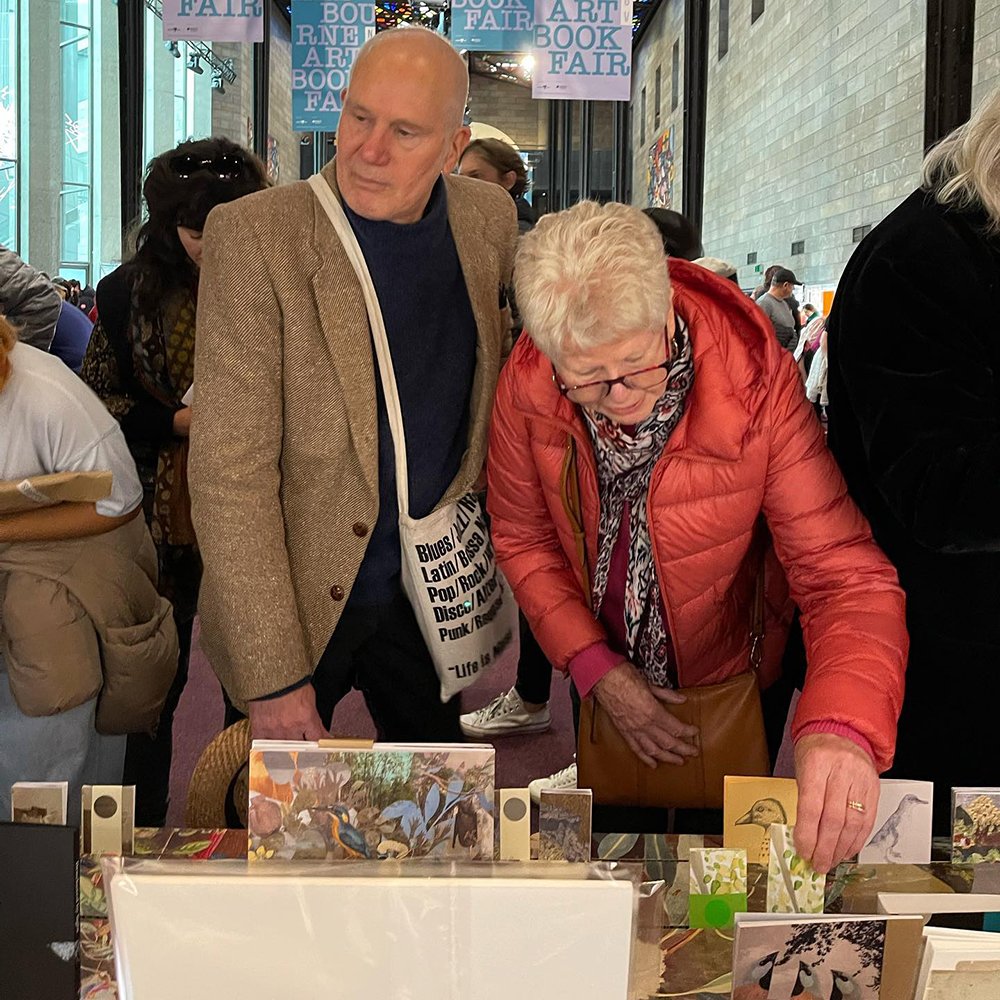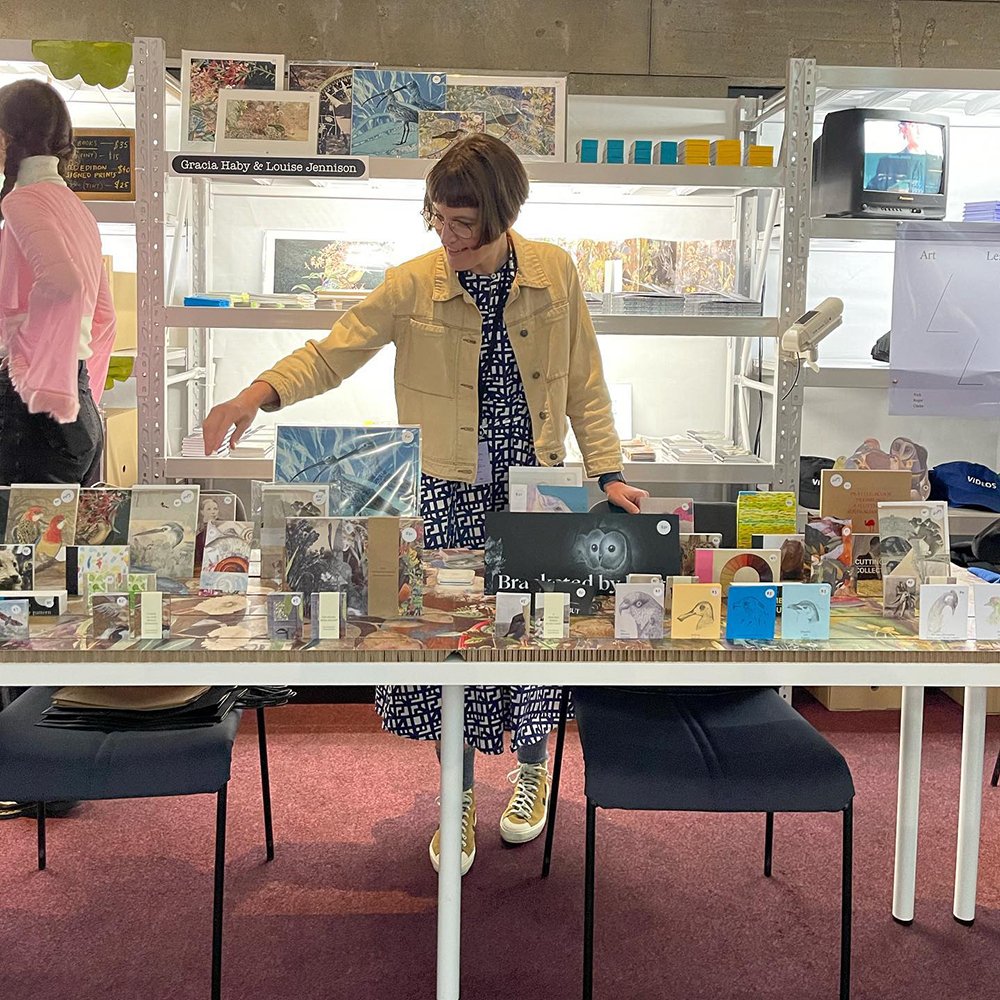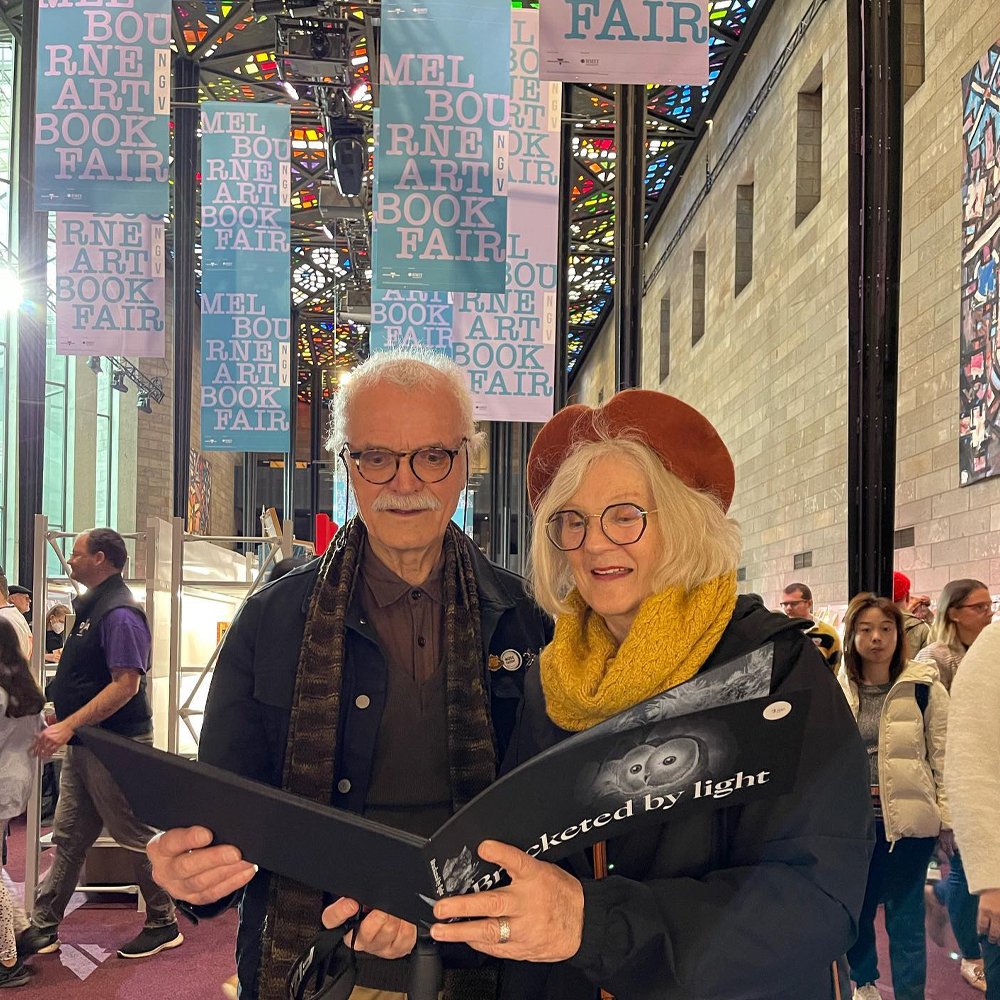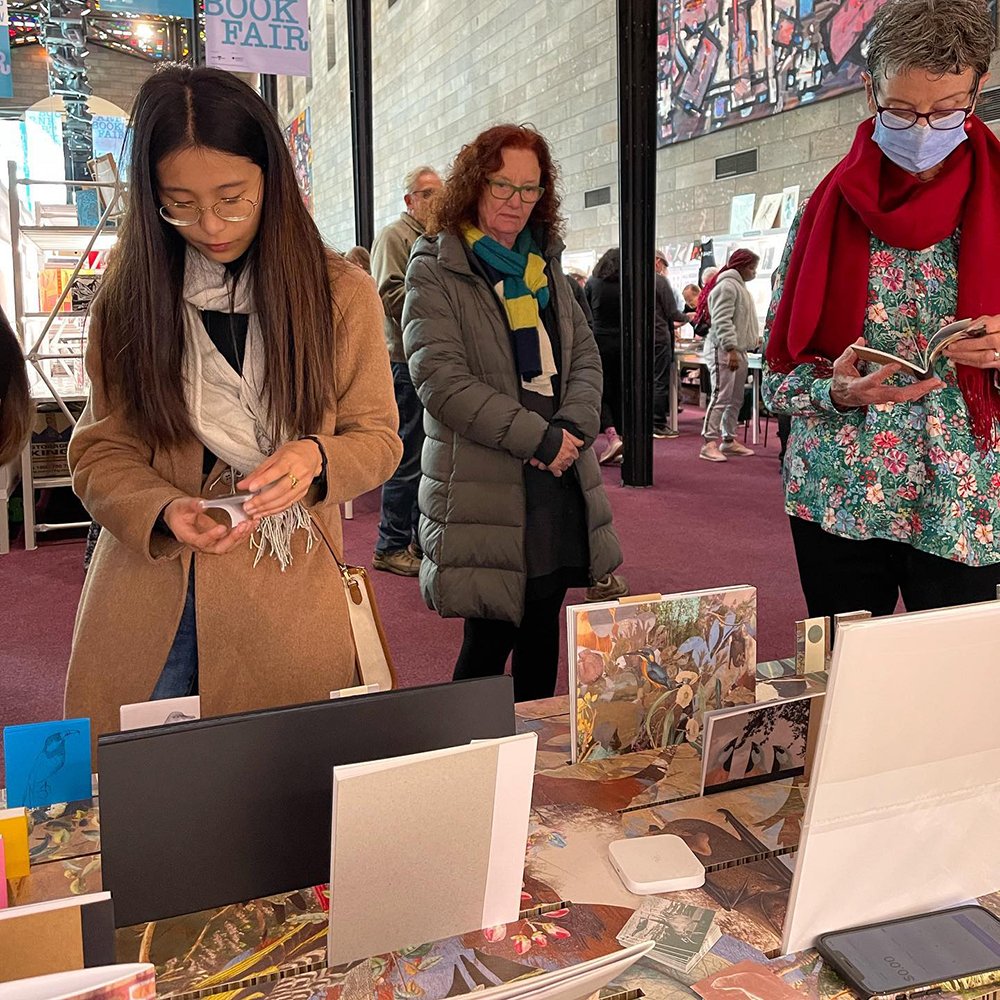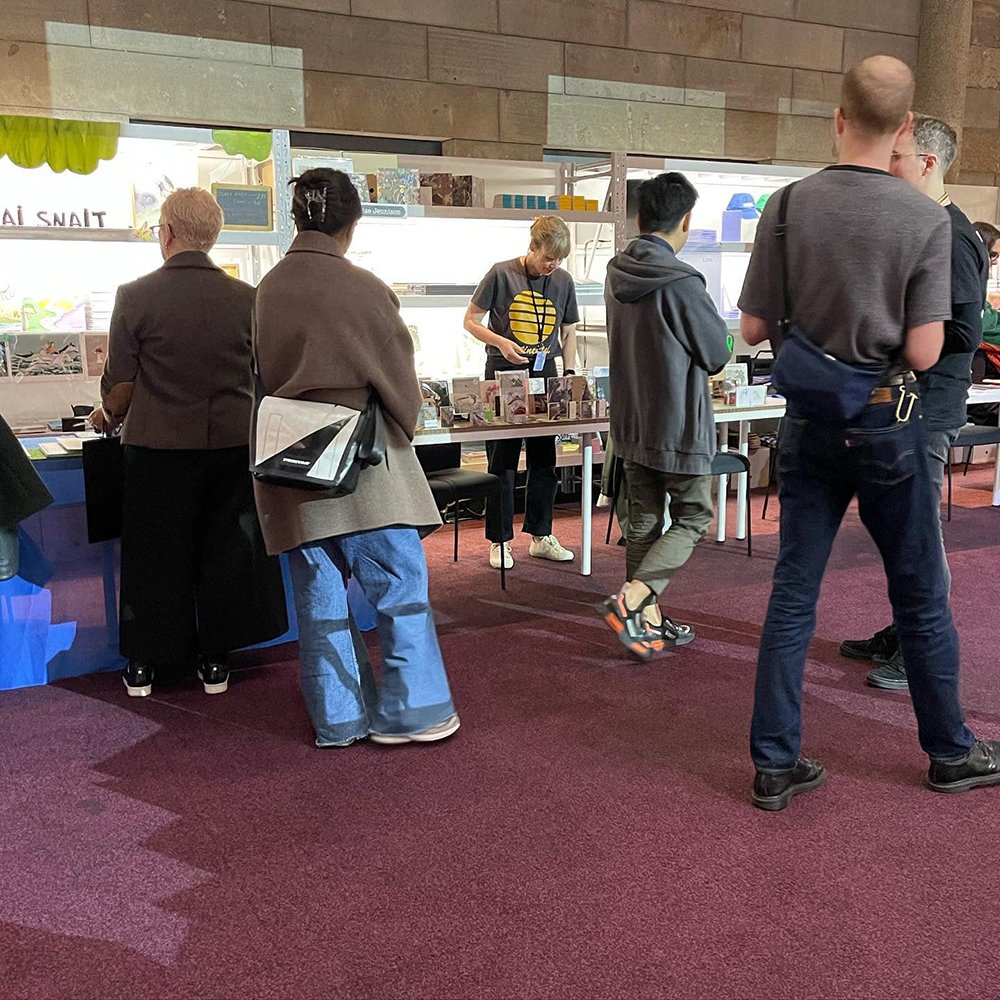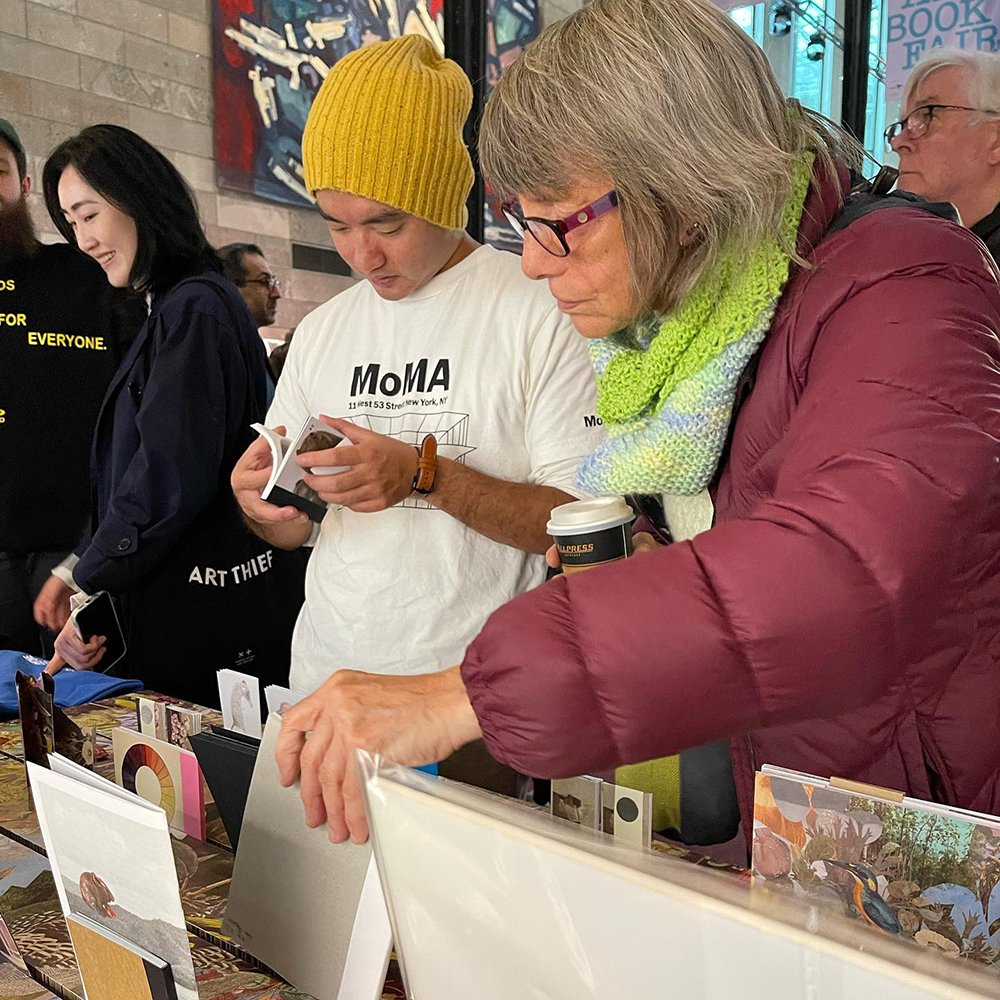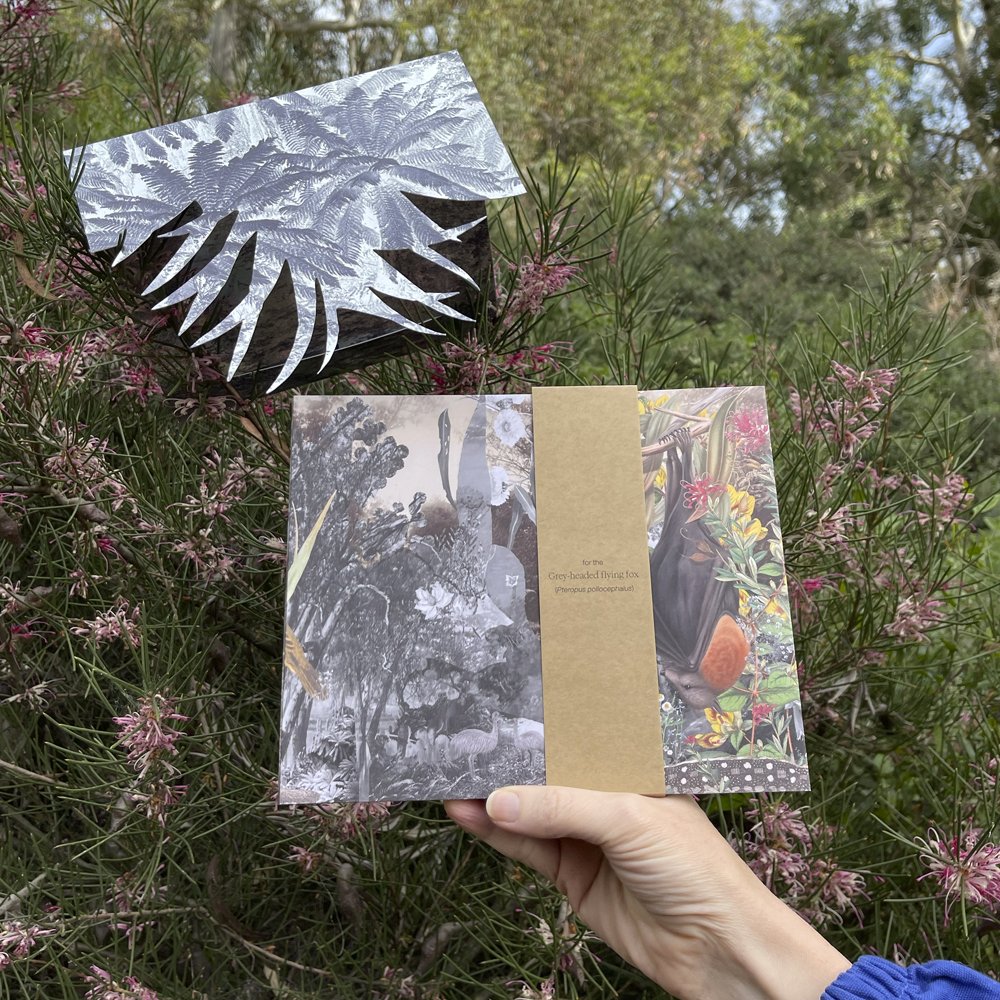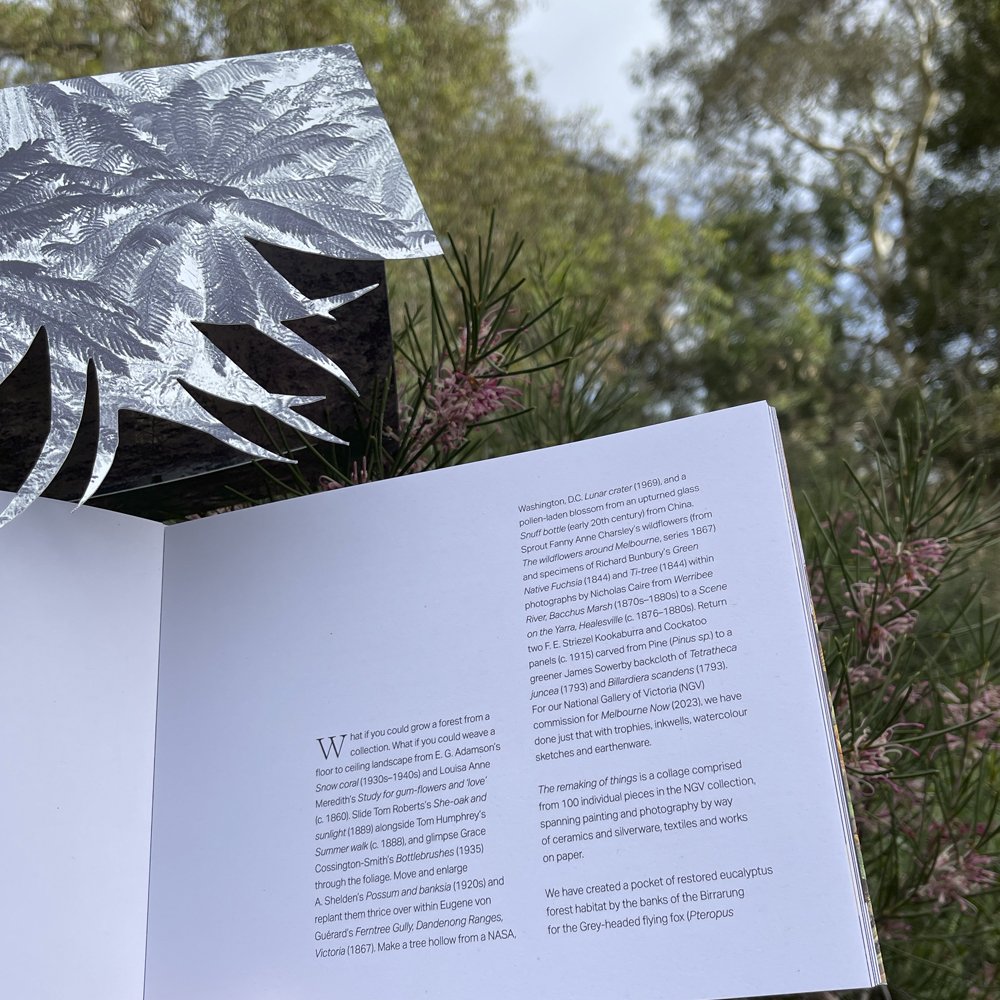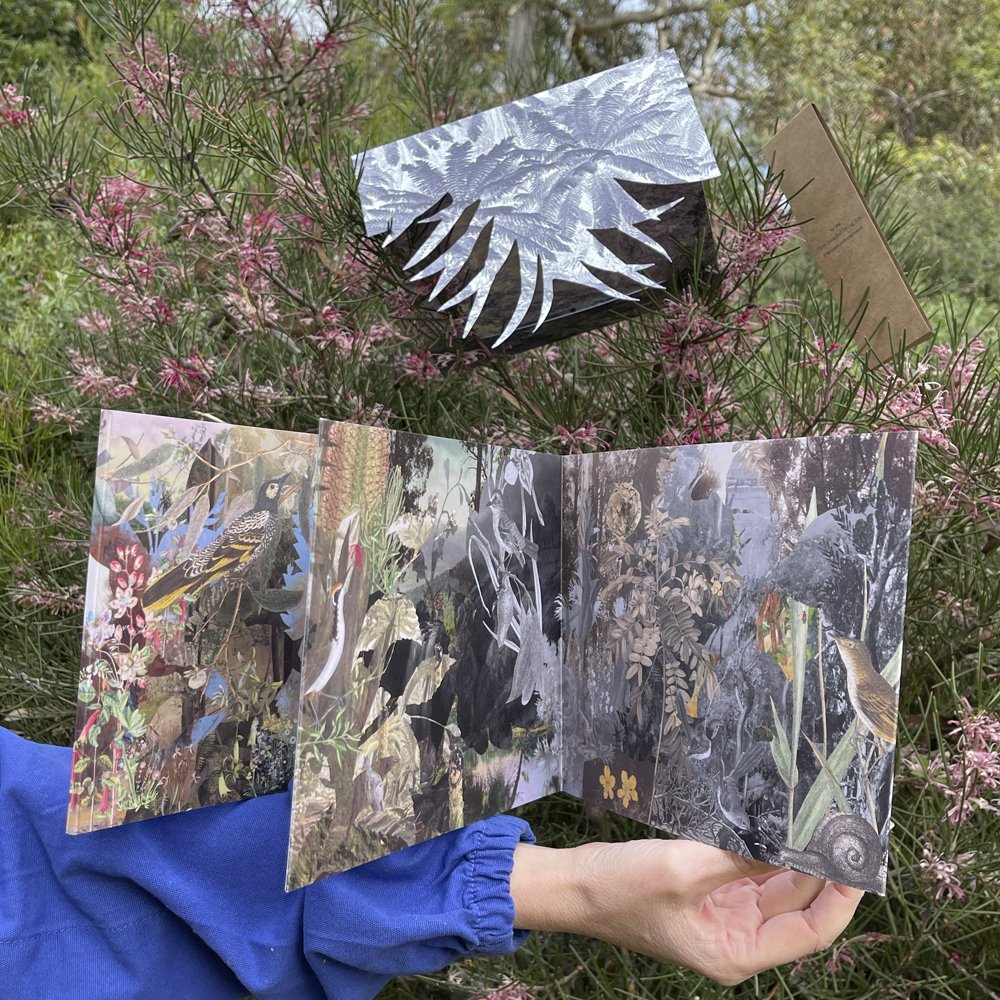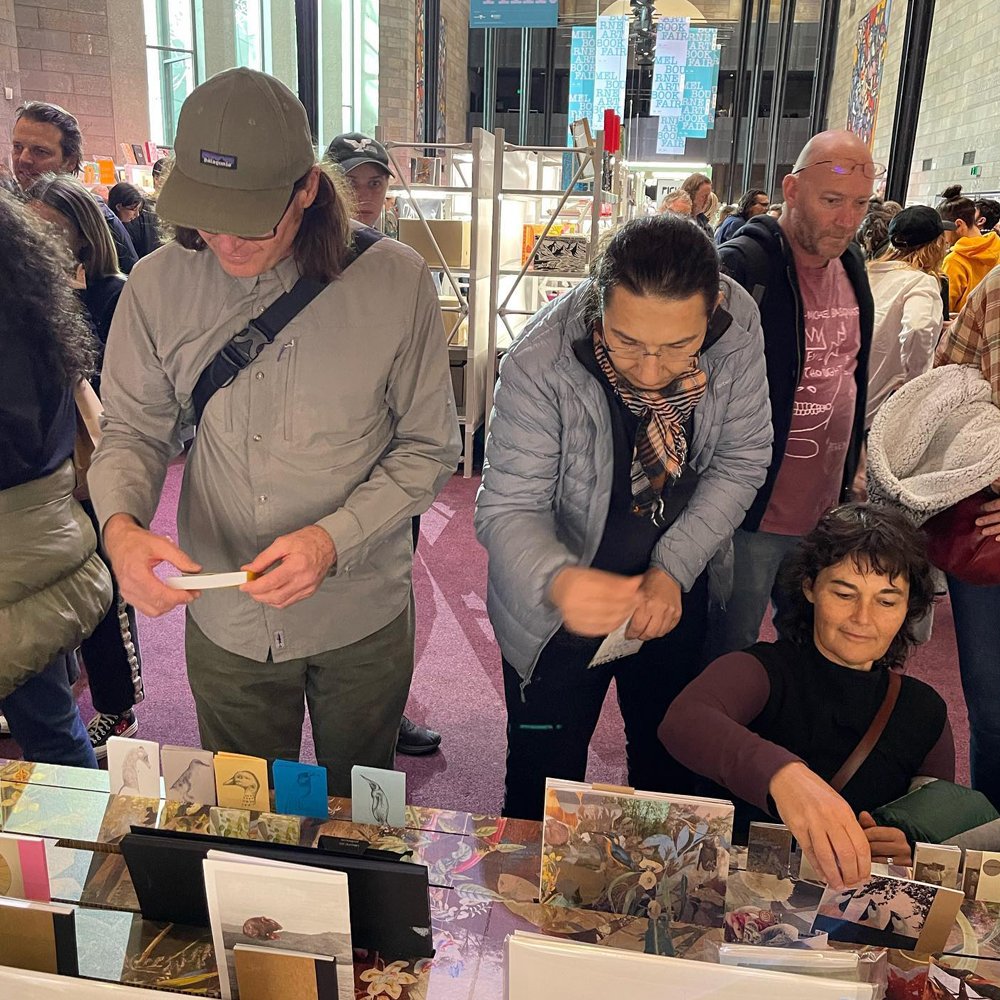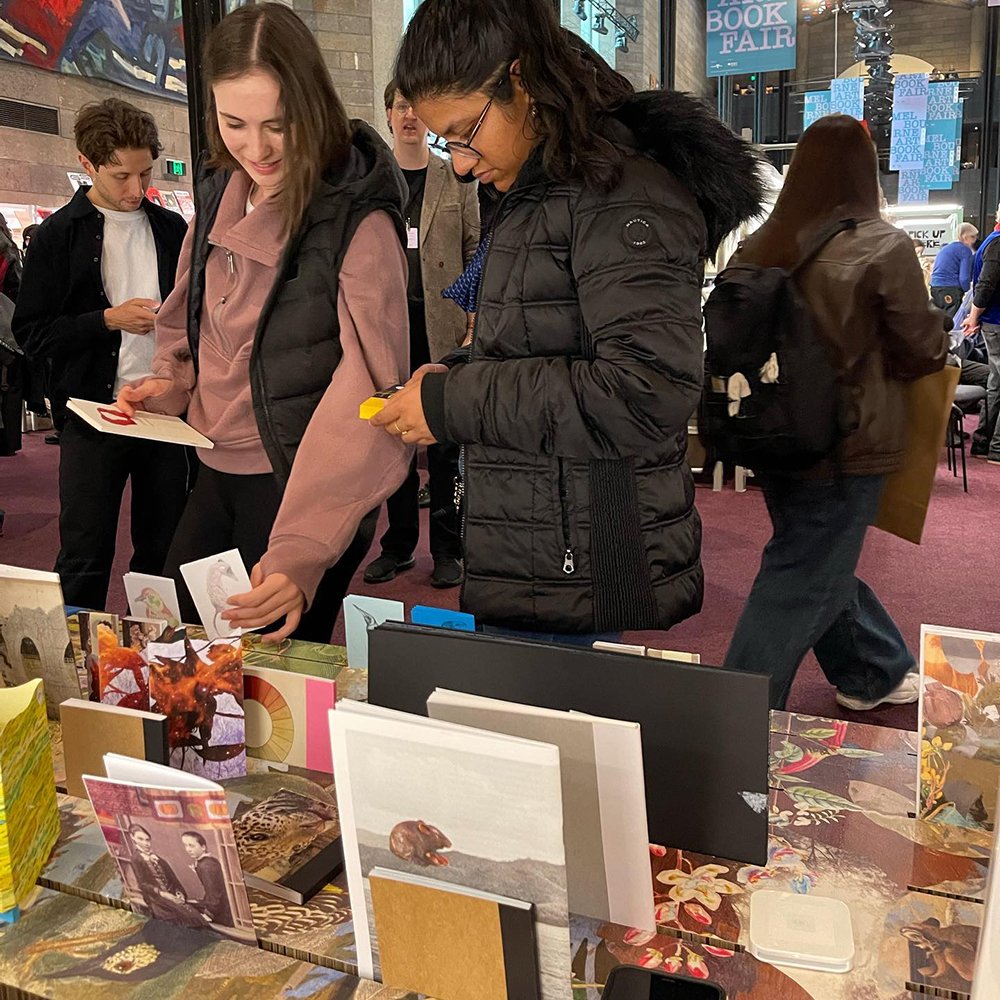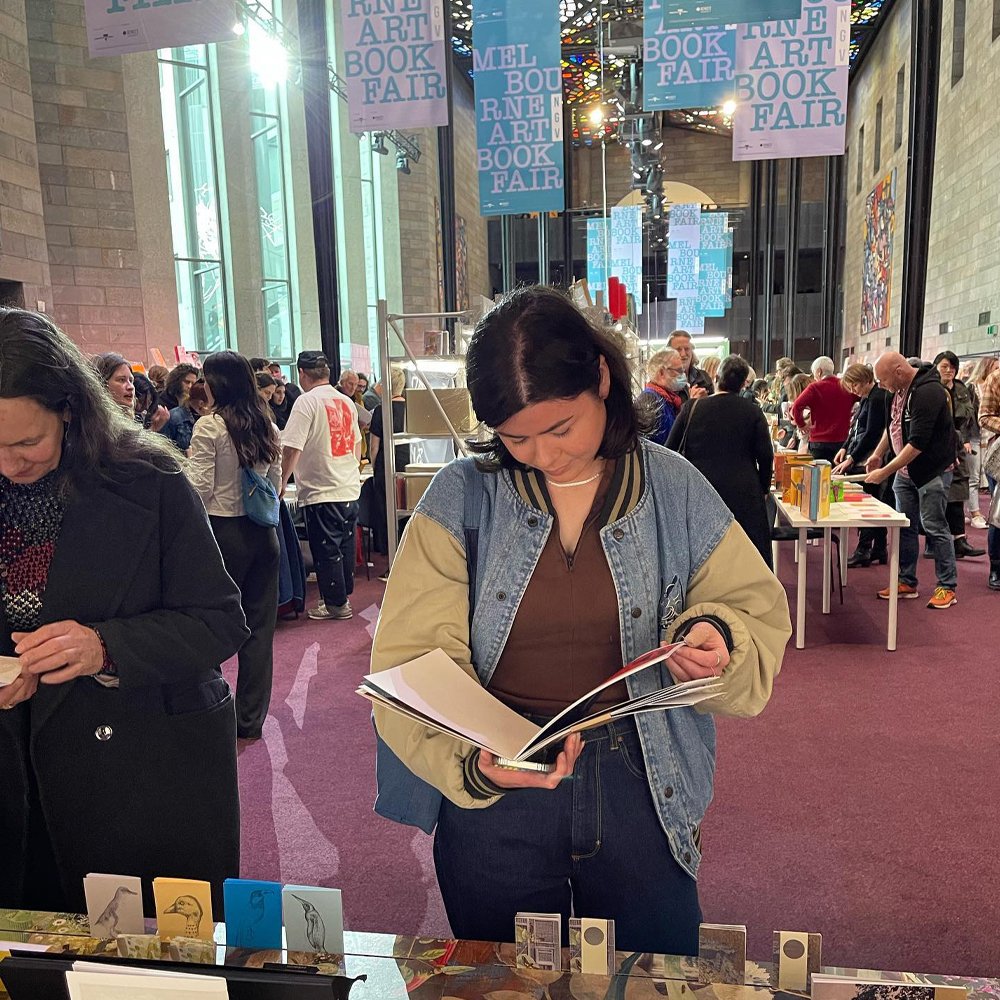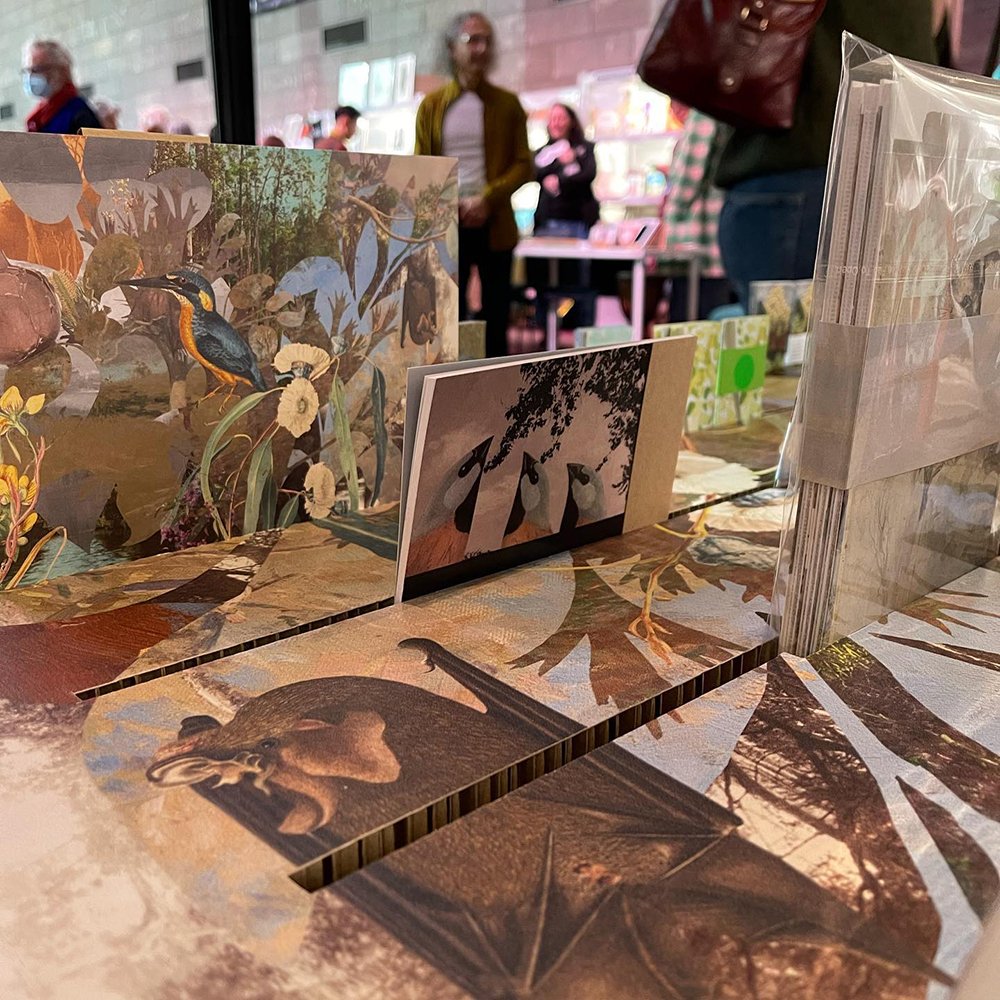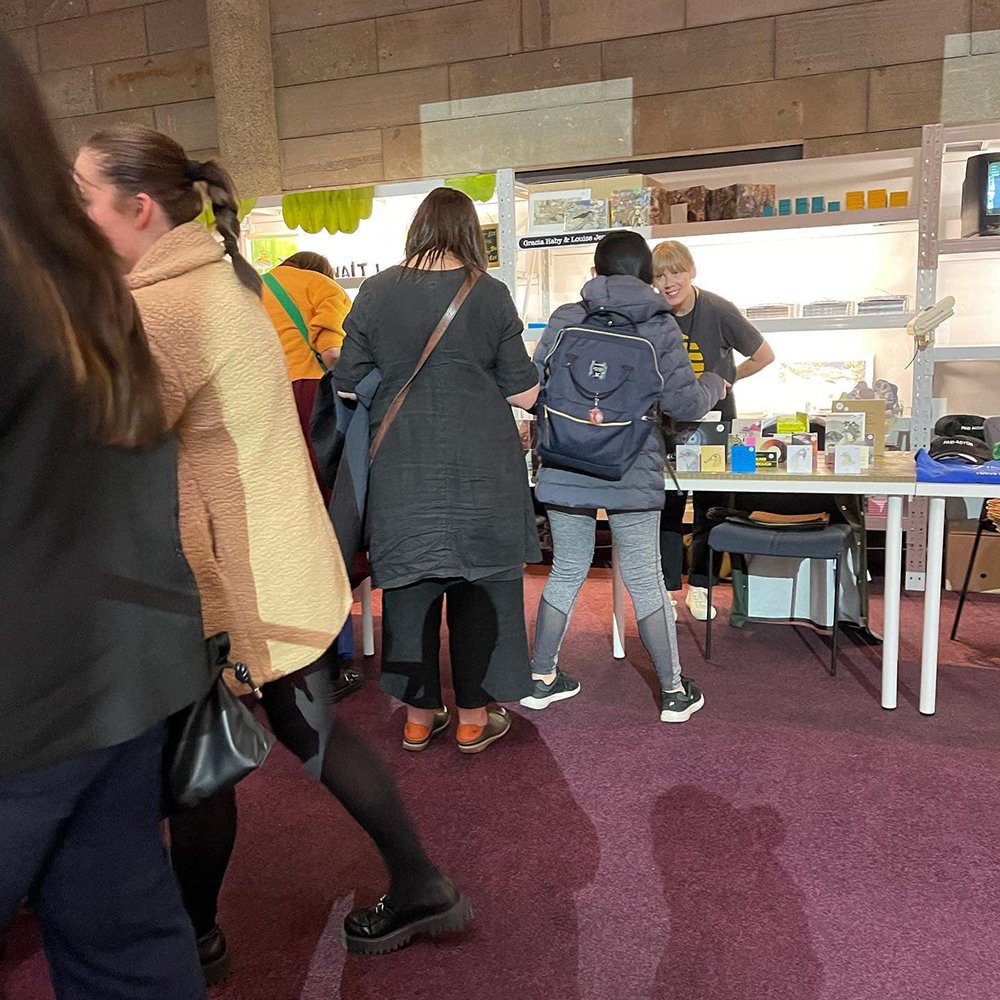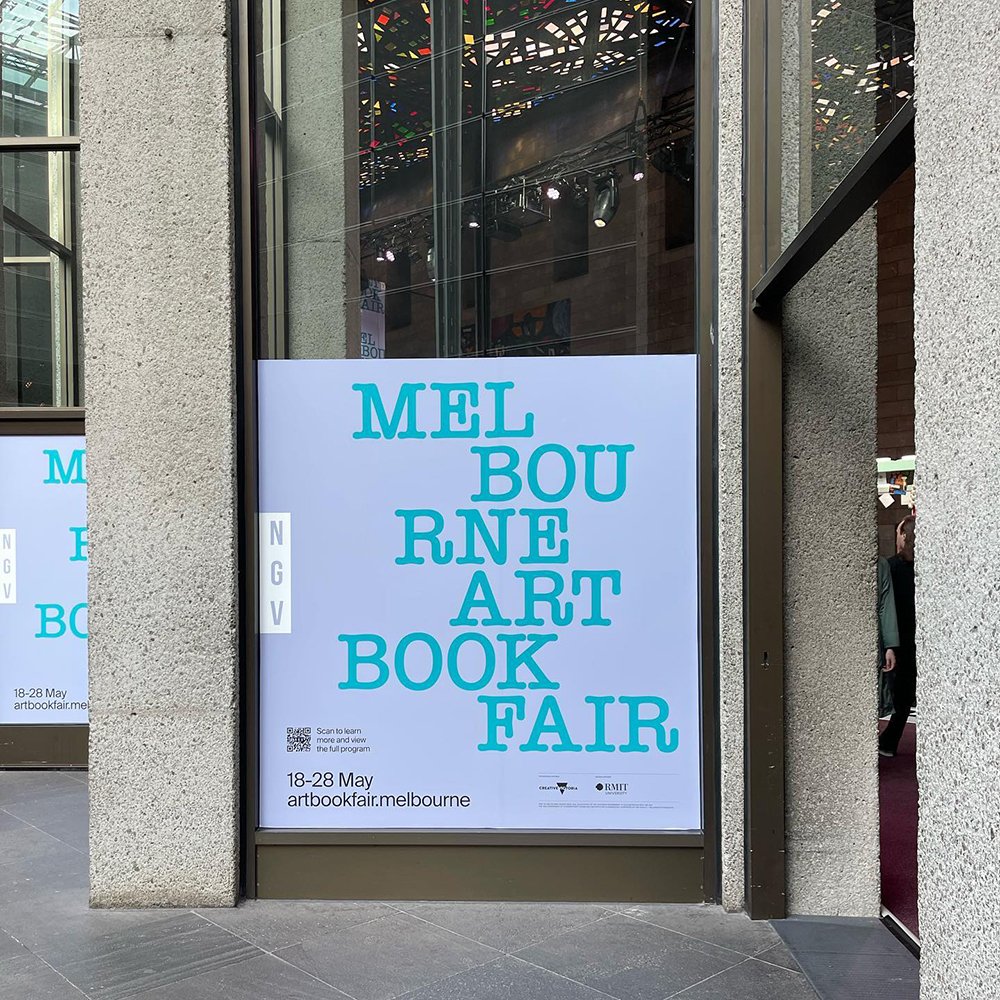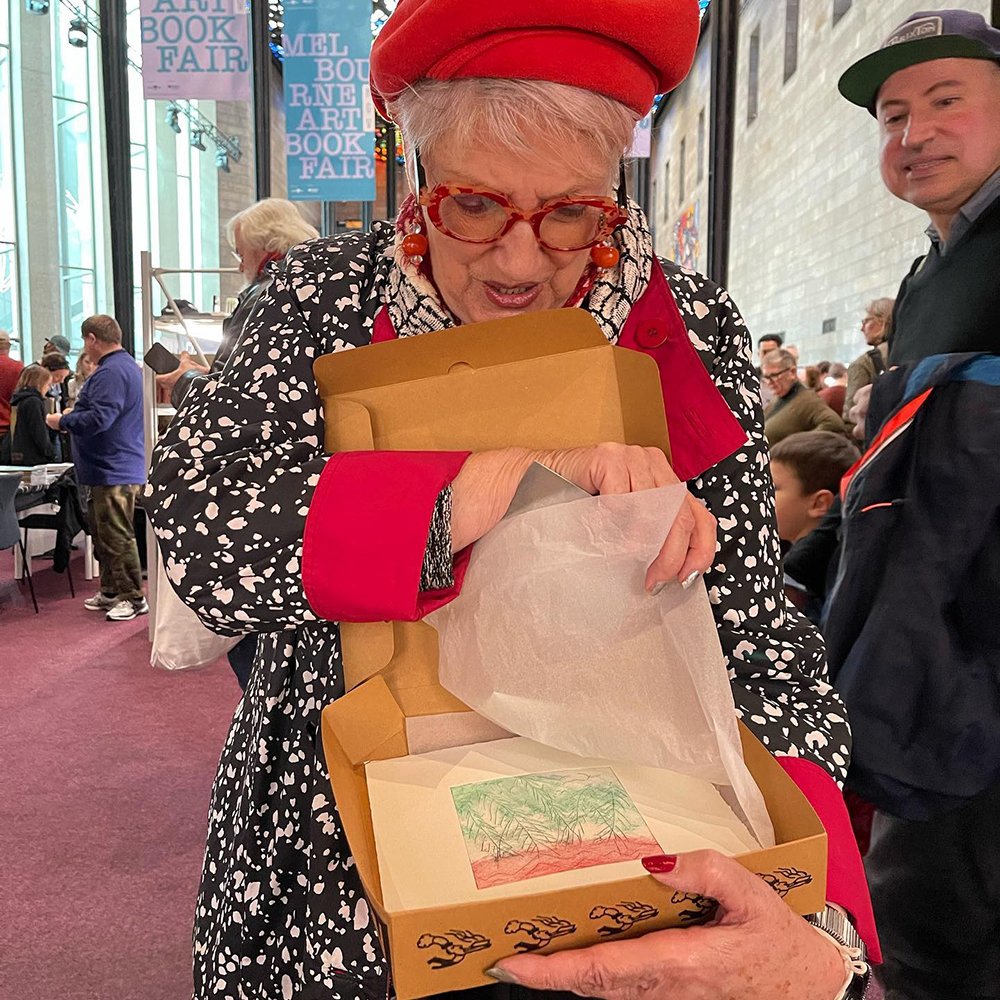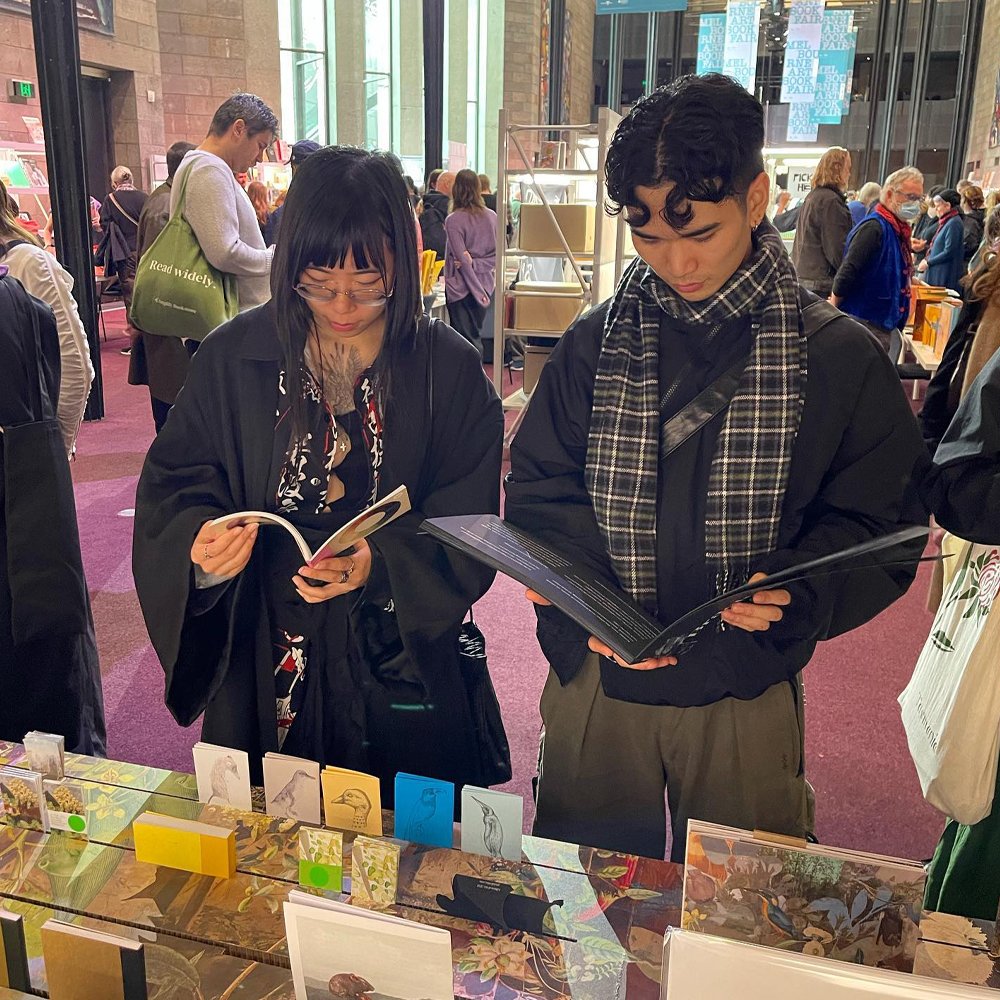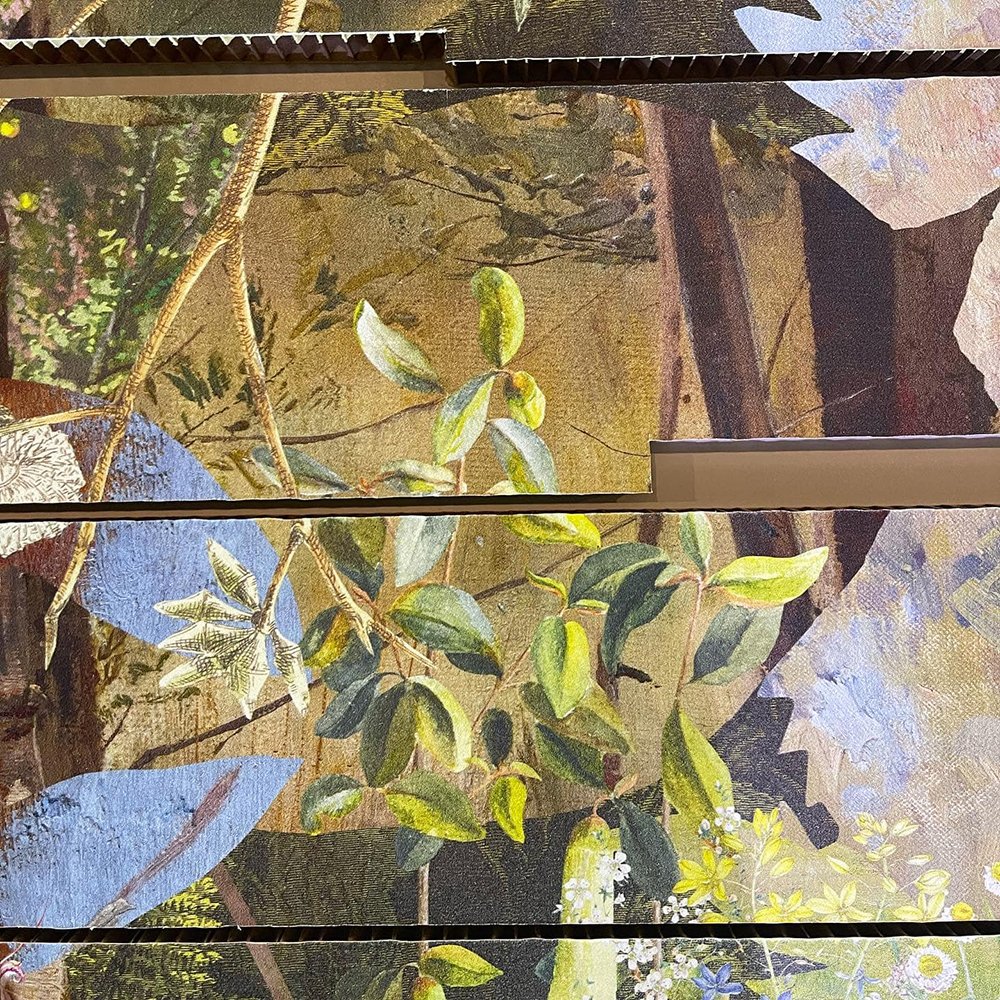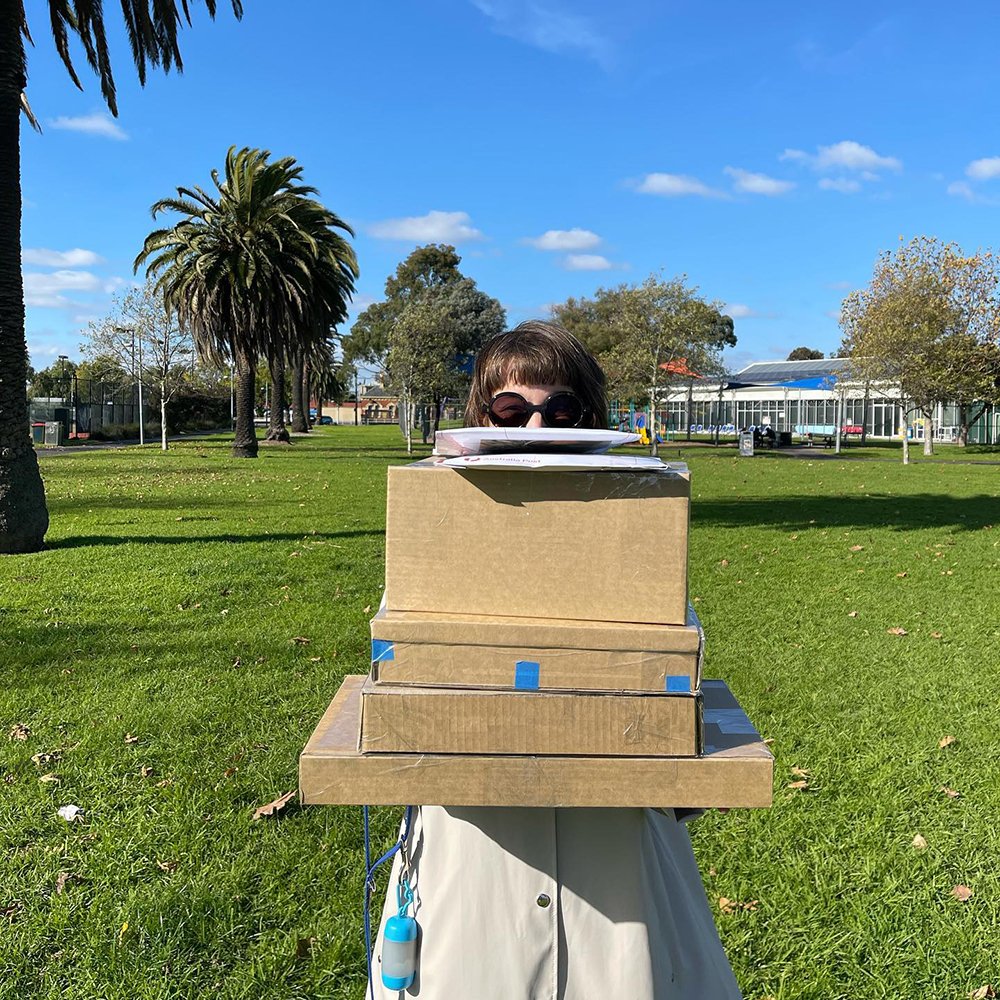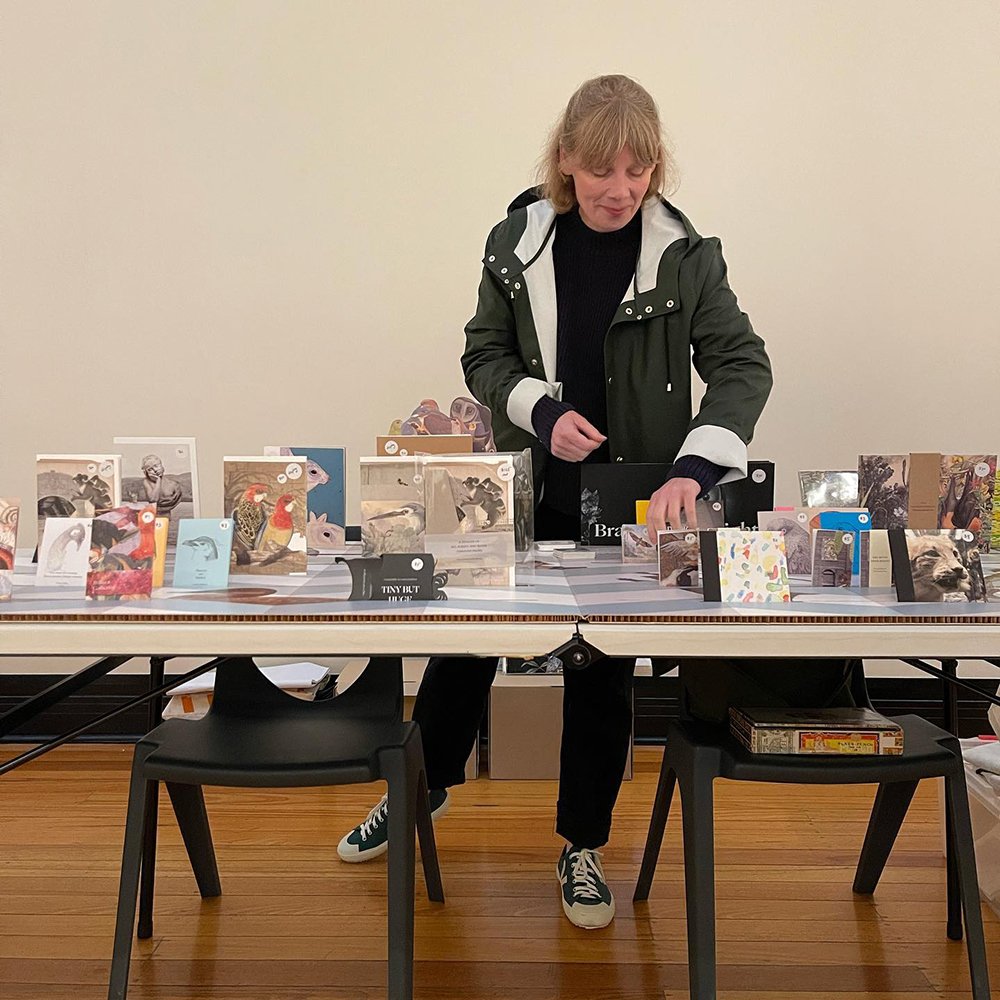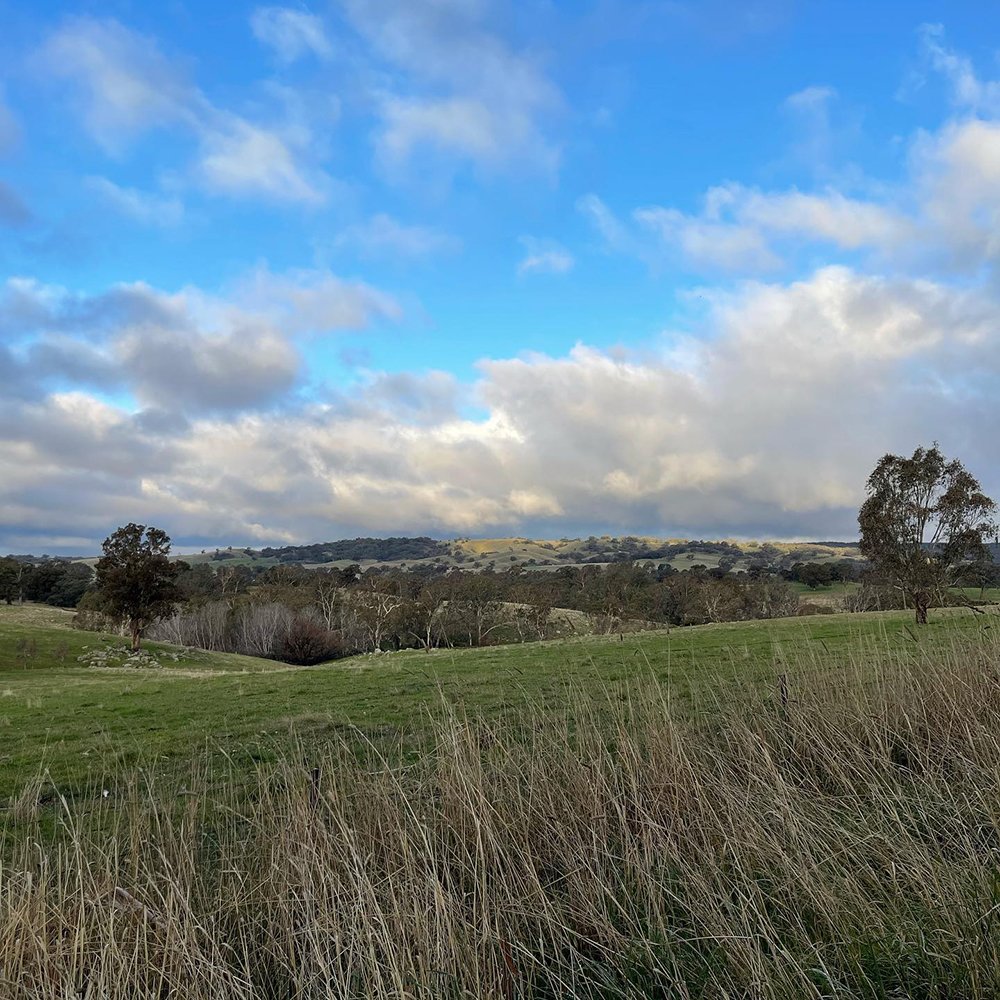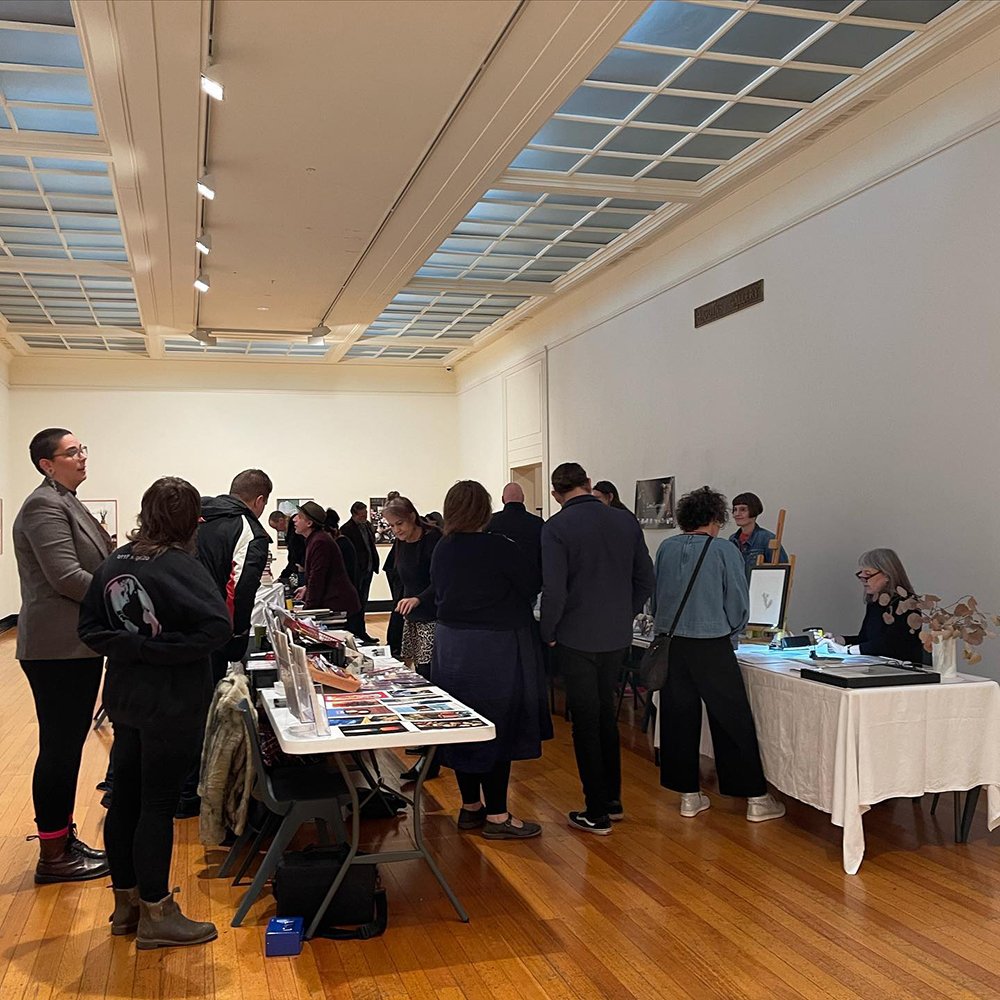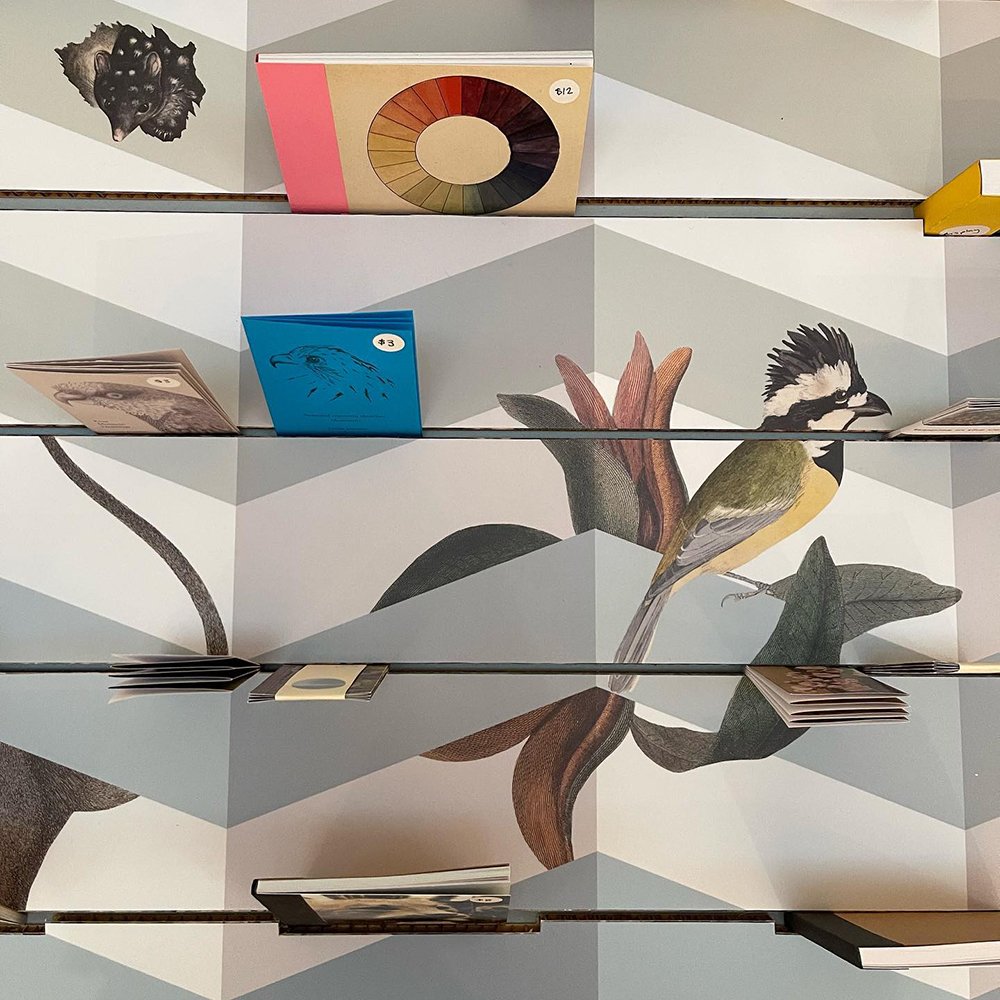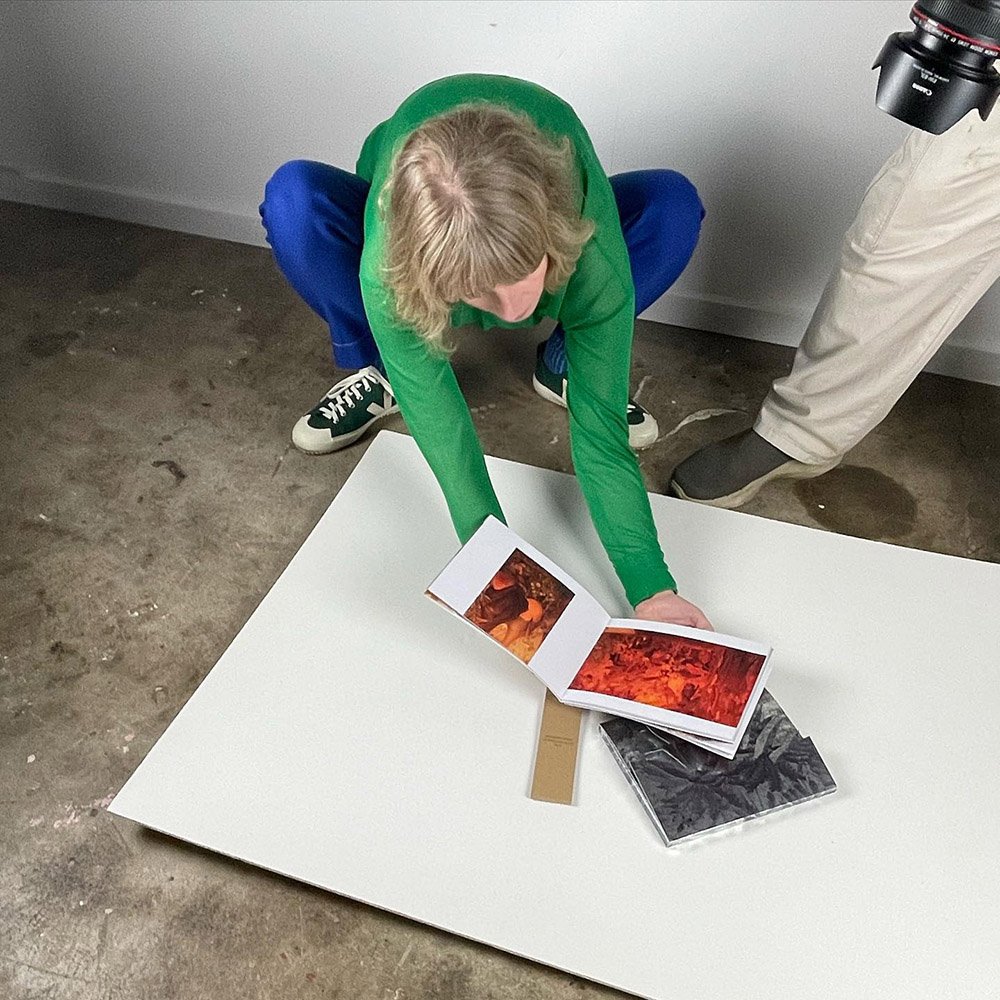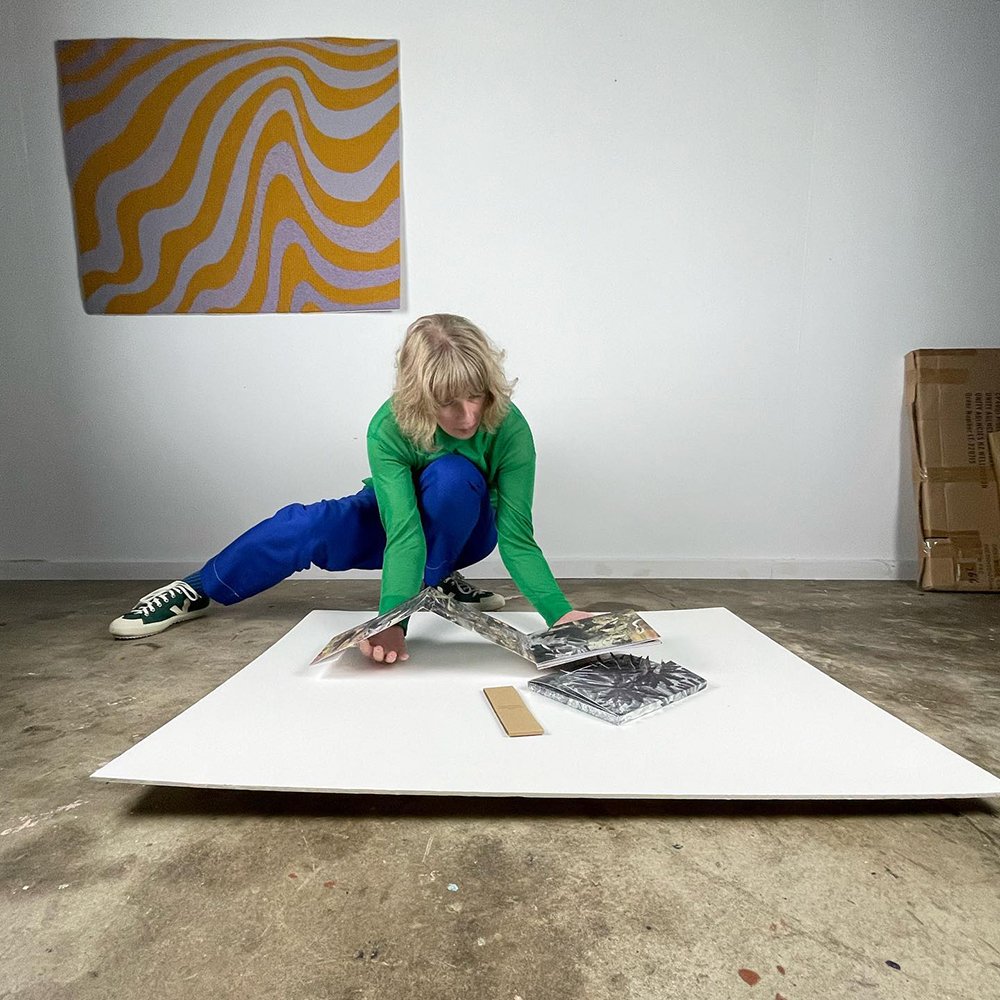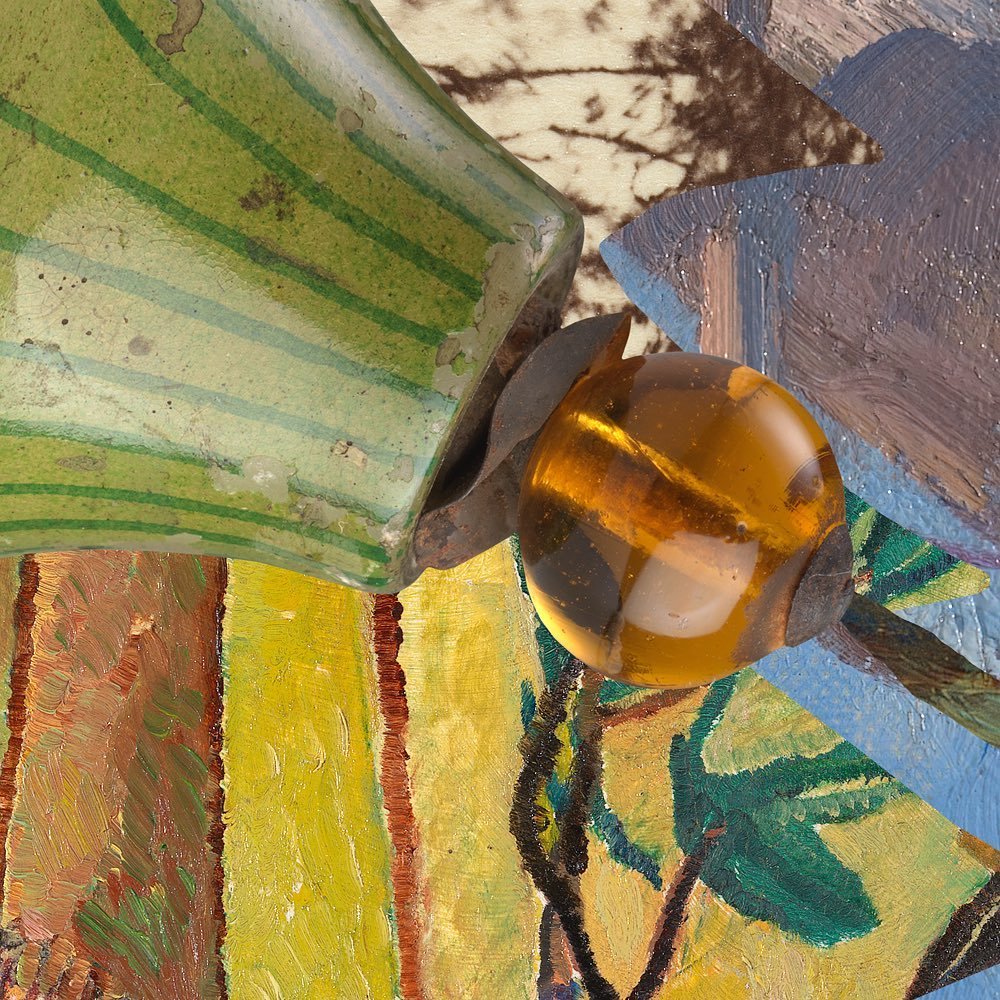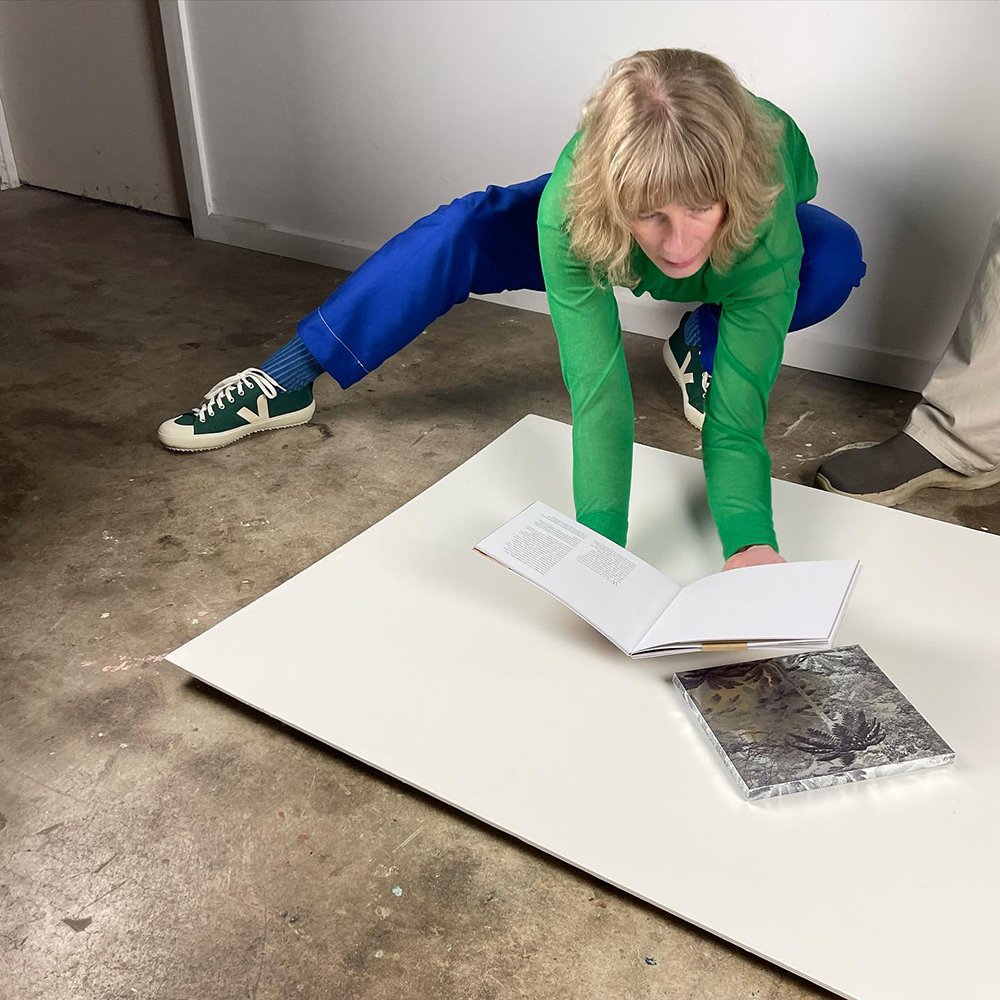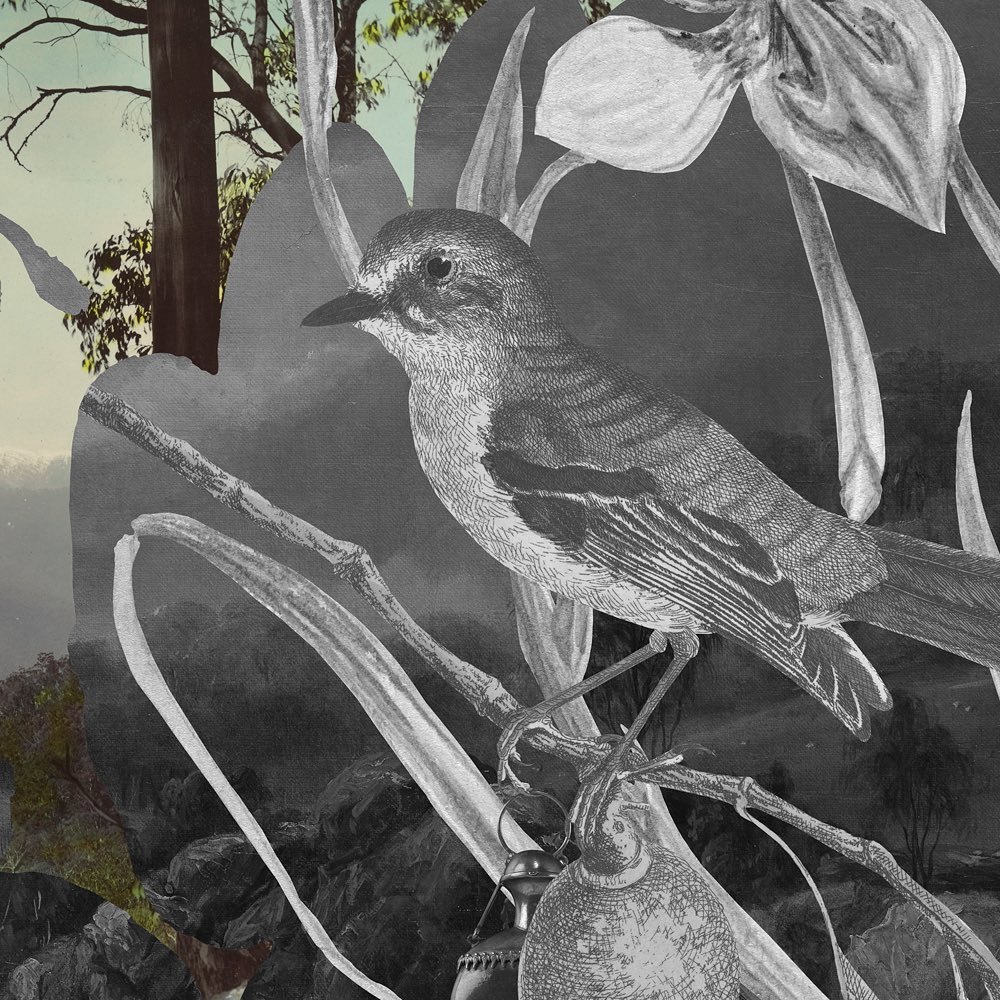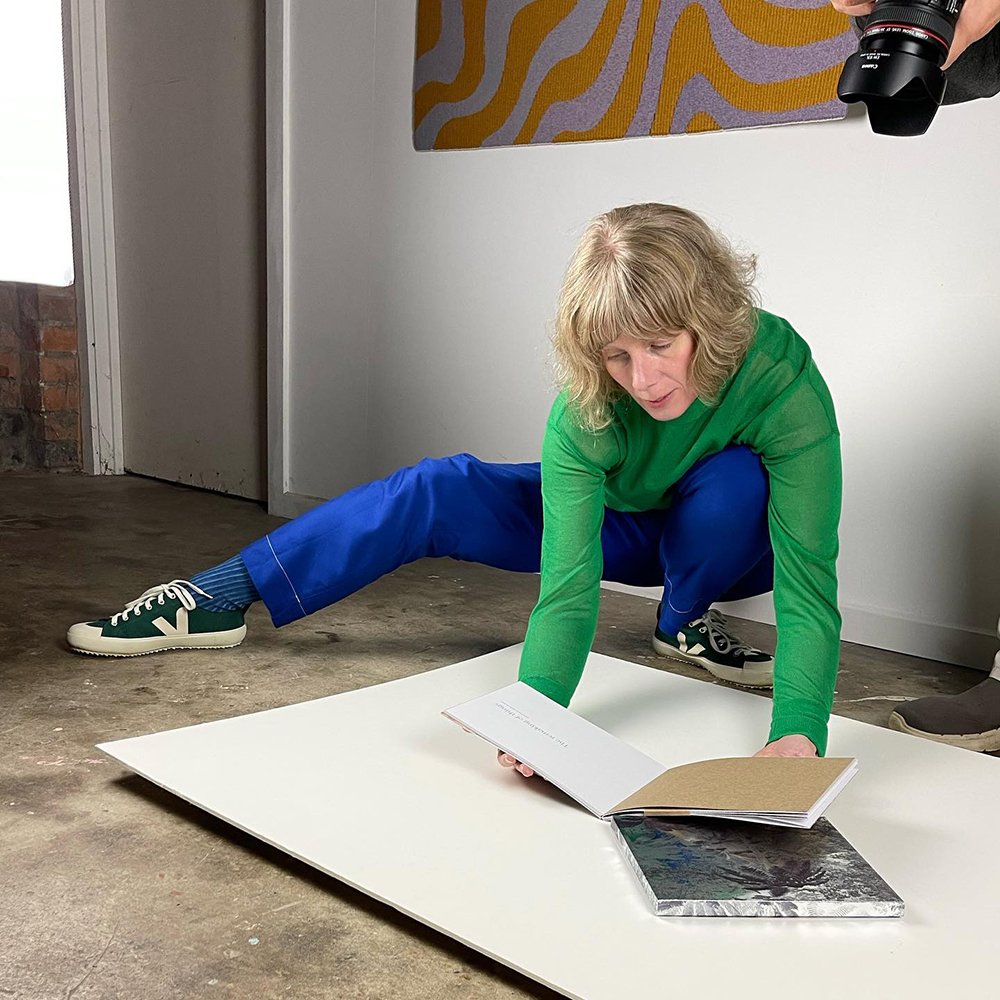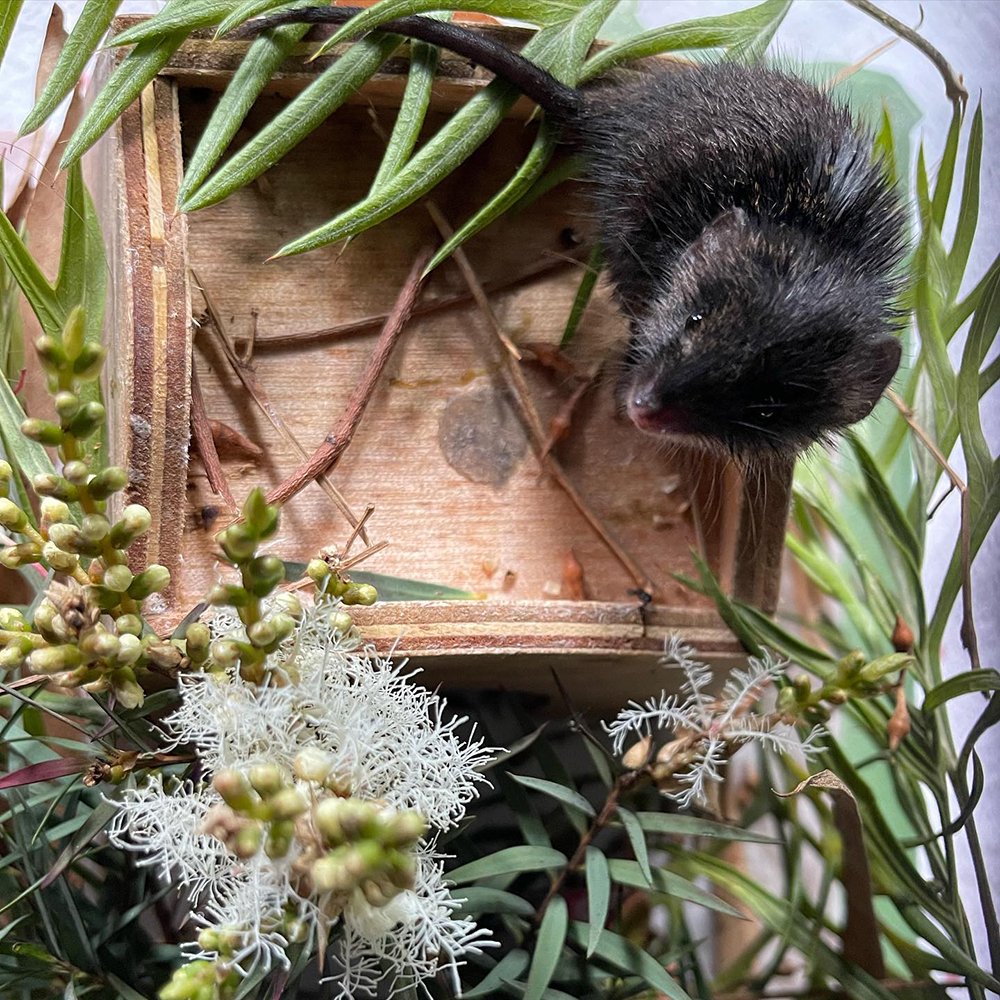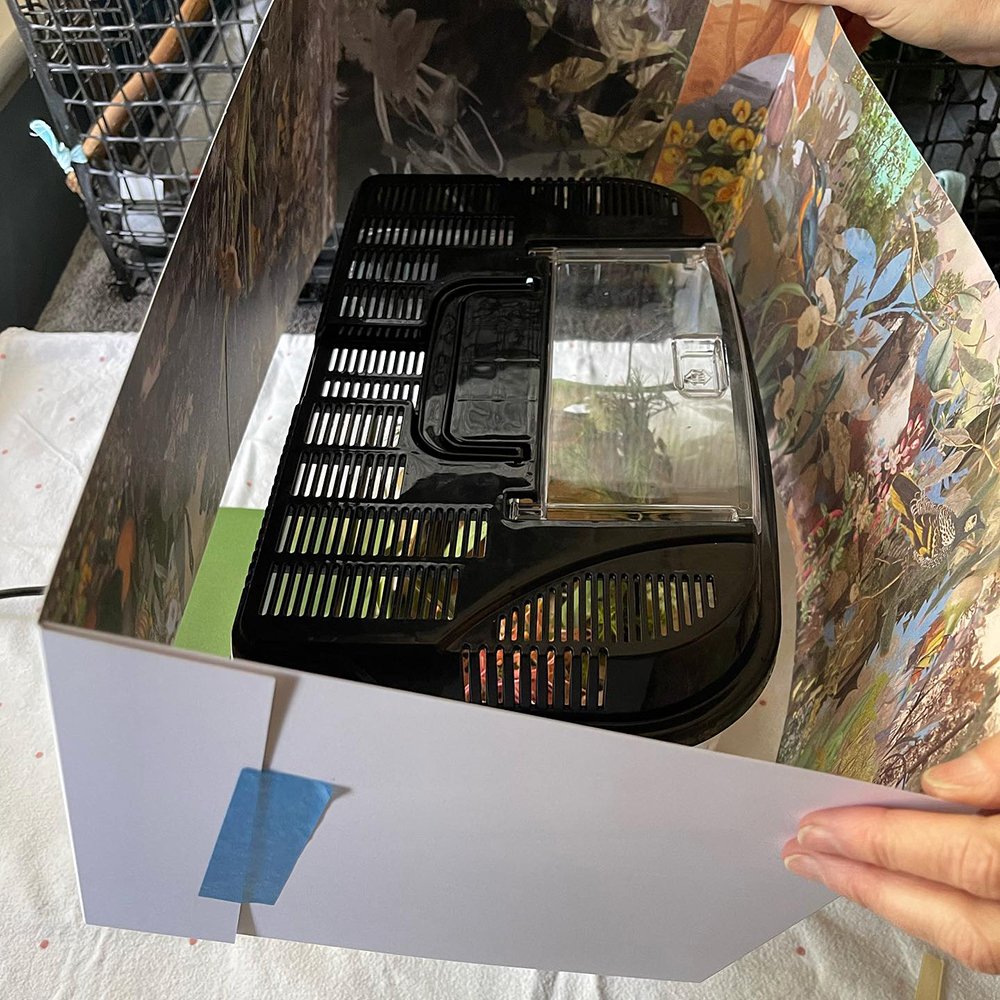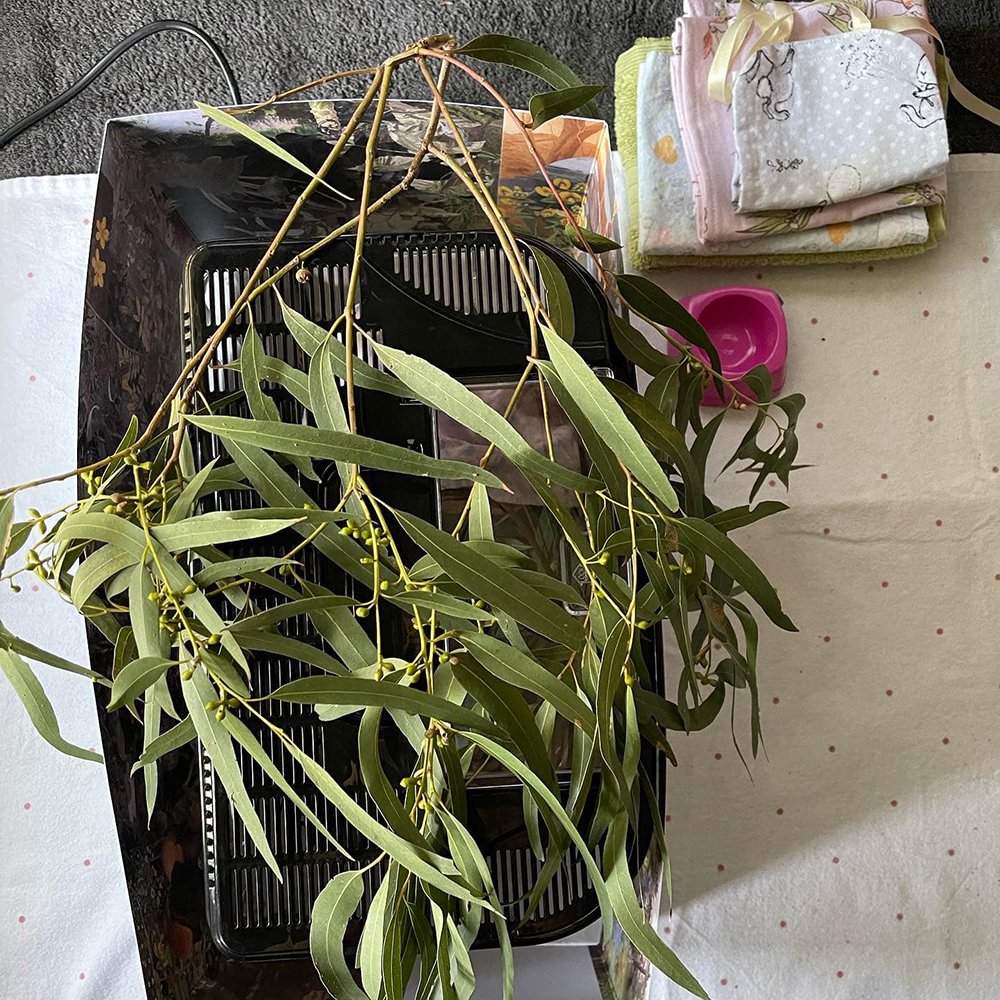THE REMAKING OF THINGS
What if you could grow a forest from a collection.
Erratic Temporality, The Melbourne Now broadsheet, 2023
Gracia Haby & Louise Jennison
The remaking of things
2023
38 page, perfect bound artists’ book, 36 Indigo Digital CMYK 160gsm ecoStar + 100% Recycled Uncoated, bound in Indigo Digital CMYK on 300gsm ecoStar + 100% Recycled Uncoated, with 185gsm Apmil Kraft end papers and belly band, 180mm x 222mm
Housed in a router-cut SwissQ inkjet CMYK on Silver Metalised Polyester 300gsm satin
Printed by Bambra
Edition of 100, with 10 artists’ proofs
What if you could grow a forest from a collection. What if you could weave a floor to ceiling landscape from E. G. Adamson’s Snow coral (1930s–1940s) and Louisa Anne Meredith’s Study for gum-flowers and ‘love’ (c. 1860). Slide Tom Roberts’s She-oak and sunlight (1889) alongside Tom Humphrey’s Summer walk (c. 1888), and glimpse Grace Cossington-Smith’s Bottlebrushes (1935) through the foliage. Move and enlarge A. Shelden’s Possum and banksia (1920s) and replant them thrice over within Eugene von Guérard’s Ferntree Gully, Dandenong Ranges, Victoria (1867). Make a tree hollow from a NASA, Washington, D.C. Lunar crater (1969), and a pollen-laden blossom from an upturned glass Snuff bottle (early 20th century) from China. Sprout Fanny Anne Charsley’s wildflowers (from The wildflowers around Melbourne, series 1867) and specimens of Richard Bunbury’s Green Native Fuchsia (1844) and Ti-tree (1844) within photographs by Nicholas Caire from Werribee River, Bacchus Marsh (1870s–1880s) to a Scene on the Yarra, Healesville (c. 1876–1880s). Return two F. E. Striezel Kookaburra and Cockatoo panels (c. 1915) carved from Pine (Pinus sp.) to a greener James Sowerby backcloth of Tetratheca juncea (1793) and Billardiera scandens (1793). For our National Gallery of Victoria (NGV) commission for Melbourne Now (2023), we have done just that with trophies, inkwells, watercolour sketches and earthenware.
The remaking of things is a collage comprised from 100 individual pieces in the NGV collection, spanning painting and photography by way of ceramics and silverware, textiles and works on paper.
We have created a pocket of restored eucalyptus forest habitat by the banks of the Birrarung for the Grey-headed flying fox (Pteropus poliocephalus), and all who fall beneath the care and knowledge of their wing, from the smallest Reed Warbler (c. 1804–1806) to the loftiest, gelatin silver Giant eucalyptus (1899), our human selves included. We have interlaced our roles as artists and wildlife carers for the Grey-headed flying fox to sow a message of hope, cultivated from Anne Paulson’s Sketches of Victorian bush flowers (c. 1861) and fit for a John Lewin’s Warty-face Honey-sucker (now known as a Regent honeyeater). We have placed our emphasis upon what we can grow, rather than upon what we have lost (habitat, biodiversity, stable climate). Through seed dispersal and pollinating plants, flying foxes are the reason we have trees, diversity. And it is because of this ‘no me, no tree’ that none of us can afford to lose this threatened species.
We have printed scenes from the glass plate negatives of Caire’s Fairy scene at the Landslip, Blacks’ Spur (c. 1878) and Condon’s Gully, Healesville (c. 1903–1910) upon silver foil paper, which has then been cut into the shapes of paperweights, embellished emu eggs, and further Sowerby specimens ranging from, what we now refer to as, acacias to grevilleas. This sweep of additional reflective collage components is intended to serve as a mirror: what is my role in the forest? What am I doing for nature? A literal reflection to spark a question, dressed in the costume of a Horseshoe bat’s outstretched wing.
With cyclic sound, and illuminated so as to transition from day to night and back again in the compressed span of twenty-four minutes for twenty-four hours, The remaking of things, is rarely quiet and rarely still. The twenty-four-minute sound loop features recordings from various remote flying fox colonies like those at Tallowwood Ridge, Dorrigo, NSW, recorded on the edge of a gully, inside a 5,000-strong camp. If you listen closely, you can hear the “hiccupping” sounds of the females, and the deep swoosh of wings as a flying fox travels between the trees. Just as glass negatives have been meshed with hand-coloured etchings in the collage, field recordings from the middle of the day on Bellingen Island, Bellingen, NSW, have been spliced with chatter from the Ku-ring-gai Flying-fox Reserve in Gordon, NSW.
In the early evening, perhaps you will hear a Ninox boobook duet, because a healthy habitat is one that is biodiverse. When the light appears a cool moonlit violet as the middle of the night slips into early morning, you can hear the pups in the crèche trees calling out to each other, and practising their wing beats, while the adults are out foraging. You can hear the buzz and bonk of insects and frogs.
As the light changes to indicate the approach of sunrise, the morning sounds are comprised from a camp at Lachlan Swamp, Centennial Park, Sydney, NSW. You can hear a female flying fox calling to her pup as she returns to camp, and the high-pitched reply of her pup, signalling their location. This call and response, like the sung conversation between the male and female boobooks, is a forest that thrums with activity.
It is intended as an embrace too, this wild-like printed refuge, and we invite you to enter the pages of this book in a similar spirit as you would the gallery, with eyes open, ears pricked up, and hearts unlatched. And once recentered and restored, perhaps you’ll ask yourself, if a single Grey-headed flying fox can fly 50 kilometres per night, dispersing up to 60,000 seeds per night, what can I do today to help nature? Will I become a volunteer wildlife rescuer or foster carer? Will I advocate for the flying fox when they are misjudged by others? Will I share my fruit tree or garden with others? Will I participate in planting and weeding days in my community? What green corridors can I help strengthen and extend? What are the values and ethics of my banking and super fund investments, and do they make the future I believe in possible? Will I write to my political representatives to advocate for climate action, protection of biodiversity, and habitat restoration?
What action can I take and what action will I take?
Allow yourself a moment to look at the world through the eyes of another, like the night gardeners who through pollination and seed dispersal ensure that there are forests, healthy and diverse. Allow yourself to see how interconnected all beings and systems are.
We hope you enjoy your time in the forest,
Gracia & Louise
●
Our artists’ book, The remaking of things, was released into the wild from our stall at the ninth NGV Melbourne Art Book Fair, in the Great Hall, NGV International (Friday 19th – Sunday 21st of May, 2023).
Just as we have often made zine versions of artworks, this artists’ book is a paper version of our Melbourne Now collage, complete with a 1437mm long concertina cover that folds out to become the NGV gallery space of sorts. Printed on ecoStar + 100% Recycled Uncoated stock. Made with 100% recycled post-consumer waste, ecoStar + is also made Carbon Neutral.
Our sincere thanks Beckett Rozentals, Curator, Australian Art, and the many dedicated NGV staff who collaborated with us on this work and supported its making. Thank-you for your boundless expertise, sharing your knowledge and love of the collection with us, and your commitment toThe remaking of things.
Editions of The remaking of things have been acquired by the National Gallery of Victoria, State Library of New South Wales, State Library Victoria, State Library of Queensland, the University of West England (UK), Indiana University, Wells Library, Art & Architecture Collection (USA), and UCLA Young Library, Special Collections (USA).
﹏
RELATED LINKS,
MELBOURNE NOW: THE REMAKING OF THINGS
NGV MELBOURNE ART BOOK FAIR
MELBOURNE NOW GRACIA & LOUISE PROFILE
#THEREMAKINGOFTHINGS
THE REMAKING OF THINGS IN COMMUNITY HALL
RELATED POSTS,
UNDERSTORY
FROM DREAMWEAVER
BIRDS, WE’RE CURIOUS FANS
BINGO!
AN OUTSTRETCHED WING
THREE DAYS IN THE GREAT HALL
MAKING A TREE HOLLOW FROM A LUNAR CRATER
THE FOLDING OF PAGES
ARTISTS-IN-RESIDENCE
IN THE COMMUNITY HALL
WHAT IF YOU COULD GROW A FOREST FROM A COLLECTION
SMALL, ARBOREAL, NOCTURNAL, OMNIVOROUS
SILVERED
LISTENING
COMMISSIONS & WILDLIFE FOSTER CARE REALLY DO GO PAW IN PAW
FROM CLOVER TO PELÉ
THE SOFTEST OF RELEASES
GROWTH
THE BEGINNING
What does the word ‘artist’ mean to you?
Does it look like a painter, a creator of collages, or a wildlife carer?
Gracia and Louise are interested in The Remaking of Things, including the role of the artist in 2023.
Their work for Melbourne Now aims to bring the preservation of a species — the Grey-headed flying fox — to our attention. The large-scale installation borrows from beloved artworks in the NGV Collection to create an imagined habitat for the endangered creatures.
In doing so, Gracia and Louise step outside of the traditional ‘environment’ of the artist and propose new functions for the makers of today.
Melbourne Now, NGV
Erratic Temporality
Sophie Cunningham
2023
The Melbourne Now broadsheet, NGV Publications
NOW
The Climate Change 2023: Synthesis Report recently recognised 'the interdependence of climate, ecosystems and biodiversity, and human societies; the value of diverse forms of knowledge; and the close linkages between climate change adaptation, mitigation, ecosystem health, human well-being and sustainable development'. There are other words in the report also. Words like unsustainable. Words like consumption. Phrases such as adverse impacts, damage to people (high confidence), substantial damages, increasingly irreversible losses. Which is to say that designers, architects, landscapers and urban planners have a lot to take into account.
SEGUE TO THE PAST
When I was growing up, our family life casually referenced the mishmash of the seventies at every turn. Type was everywhere! It SHOUTED, it was stern, sensual, fat, lush, curly, lurid, sexy.
Type, in all its exuberance and power. [Studio Ongarto Eucalyptusdom 2022; Alter Wilderness Society identity 2018]
This was a time of protest and challenge, [JES-WRI Treaty 2022 (feat. Lidia Thorpe)] the era of magazines as varied as Playboy, Spare Rib and Lip. [Virginia Fraser and Elvis Richardson FEMMO 2014–15] Objects that you'd see on a daily basis included crochet, Hills hoists, macrame, beanbags, K-Tel Bottle Cutter Kits, wind chimes, [Jan Nelson Black river running #14: 33.54 minutes 2020–22] bunk beds made from treated pine, Marimekko, TV shows like Number 96, and board games from the Jigsaw Factory.
Modernism bled into Brutalism bled into the vernacular and postmodernism. Newly planted eucalyptuses were planted alongside the compulsory lemon tree, though many were removed a few decades later as their roots began to undermine foundations. (Smaller natives, however, continue to flourish and Melbourne has seen a return of wildlife as a result: rosellas, bats, possums, cockatoos.) The vibe was chaotic. Blonde brick houses and apartment buildings, Mediterranean-infused fifties red brick Art Deco, Californian bungalows from the 1920s. Floorboards were being polished at every turn and Victorian terraces, large and small, were being 'opened out' at the back to let in the light.
2020
Half a century passed. The seventies bled into the eighties, the nineties into a new century. Generations ticked over. One, two, three. The past had set up a series of calls and responses but there was also repudiation: a need to move on. Melbourne became less homogenous. By the end of 2019 the city was on track to become the most populous in Australia as it welcomed people from around the world. We became more expansive, less self-referential.
Then everything ground to a halt. Smoke-choked skies were followed by one of the world's longest lockdowns. We sent each other mail. [Vincent Chan (typeface designer) Maud (design studio) AP Type typeface in use on Australia Post Prepaid Satchel Medium, Express Post Platinum Prepaid Satchel Small and Parcel Box Large 2020] We jogged within our five-k radius. [Globe International Dimension Shoe designed 2020–22, manufactured 2023]
We wore masks. [Katapult Group ActiveMask designed 2020–22, manufactured 2022] We pivoted. We worked from home. We talked to each other in parks through the fog, wind and rain of two long, long winters. We had too much time to think, or perhaps we had exactly the time we needed. We thought about connection, about relationships, about our relationship with connection. A see-sawing began between restraint (constraint, skill, precision, sobriety) and an underlying wildness. How to harness this erratic tempo, this wild momentum?
SEGUE TO THE FUTURE
What is the job of a house? Is it to let weather in? To keep weather out? Are we safer inside or outside? How bad is the climate going to get? Can you collage a home for grey-headed flying foxes? [Gracia and Louise The remaking of things 2022–23] Can you build a forest out of textiles? [Hannah Gartside Forest summons (for Lilith) 2022–23] Can you build a house out of rayon and steel? [Esther Stewart The space has been created for something to happen; 1:2 2019] Can you grow a vessel? [Fungi Solutions Triple Mycelium Product Box, Double Mycelium Product Box, Single Mycelium Product Box designed 2020-22, manufactured 2022]
What does it mean to be safe? Can we create a sense of safety without abandoning risk? [ONE PLANET Polar pyramid with Vestibule, tent designed 2003-18, manufactured 2022] How do you make a house, a railway overpass, [ASPECT Studios and Cox Architecture Caulfield to Dandenong Level Crossing Removal Project 2015–20] a landscape, a book, feel like home? Can we build a house that protects us from and connects us to?
In my mind I return again and again and again to the house that is not a house. No house. [Baracco+ Wright Architects Garden House 2014–ongoing] I imagine sleeping there: tea-trees, orchids, water lapping underneath, rain falling on perspex, rat-a-tat-rat-a-tat, animals slipping past me in the night as they go from here to there. I am inside and outside at the same time.
I want design to express the energy and shapes inherent in a form, to allow what is. I want an object's nature to be expressed, be it solid or fluid, [Craig Murphy-Wandin Man in dreaming 2022] hard or soft. I want a heart made of possum skin and fur, a heart that pulses with a love for all beings. [Matthew Harris Big love 2021]
Sophie Cunningham AM is the author of eight books, including This Devastating Fever (Ultimo Press, 2022) and City of Trees — Essays on Life, Death and the Need for a Forest (Text Publishing, 2019). This piece is based on select works — mainly architecture, design, landscape and urban planning works — featured in Melbourne Now. These are referenced in the text, denoted by square brackets.
